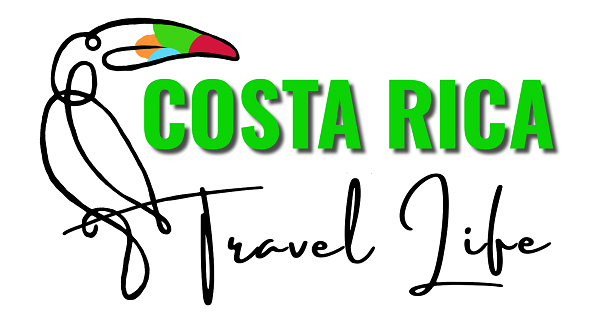
Home » Destinations » 15 Things to Know About Visiting Poas Volcano

15 Things to Know About Visiting Poas Volcano
By Author Costa Rica Travel Life
Posted on Last updated: April 5, 2024
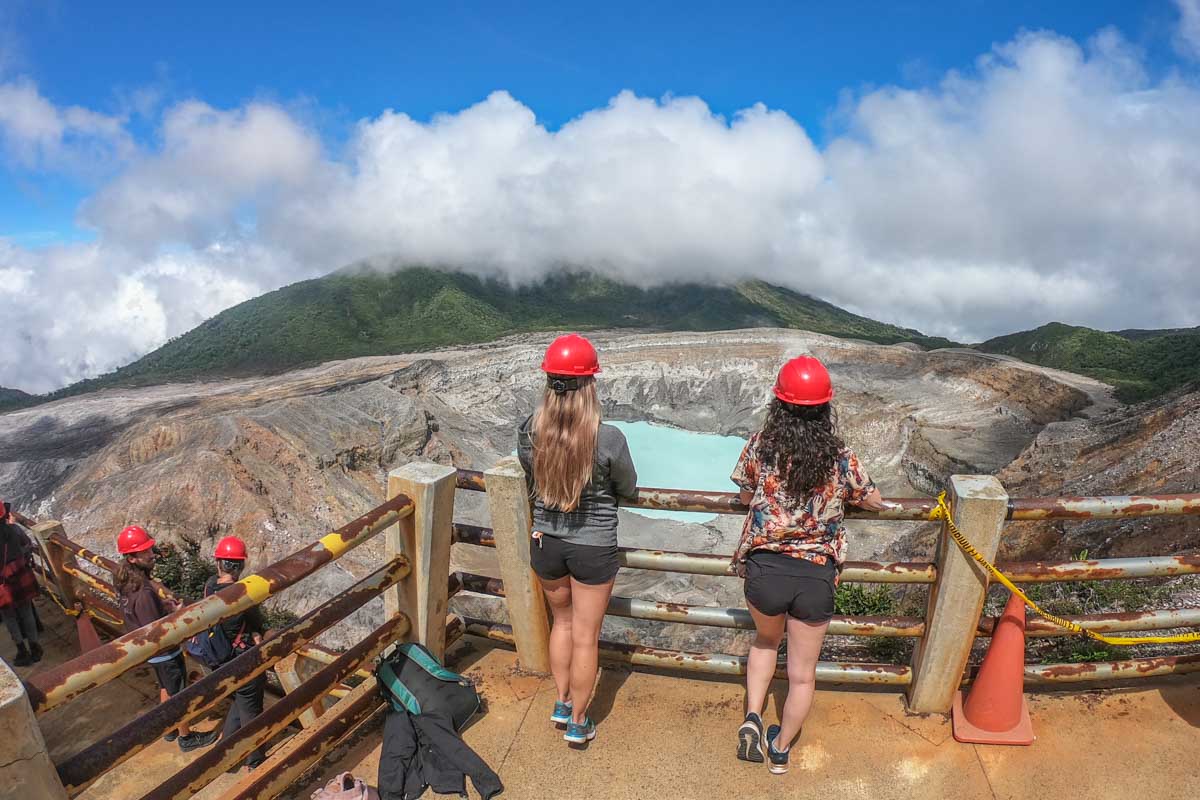
This blog may contain affiliate links. Read our disclosure policy for more info.
If you’re looking to experience one of Costa Rica’s most incredible geological marvels during your vacation – don’t miss Poas Volcano.
As one of five volcanoes in Costa Rica that remains active today, visitors can experience the bubbling, sulphuric, green glory of the volcanic lake that fills the gigantic crater. All from the safety of the observation deck, of course!
Located in Costa Rica’s fertile Central Valley region, Poas Volcano towers high into the clouds and is topped by one of the world’s largest volcanic craters. After exploring this incredible destination for ourselves we think this volcano is perfect for travelers looking for a thrilling experience in nature. Poas is well worth a visit during your travels around Costa Rica.
It makes a perfect way to spend a day around San Jose ! And it should come as no surprise that visiting Poas Volcano is one of the best things to do in all of Costa Rica !
In this blog, we share everything you need to know before you go by answering all your questions!
1. About Poas Volcano
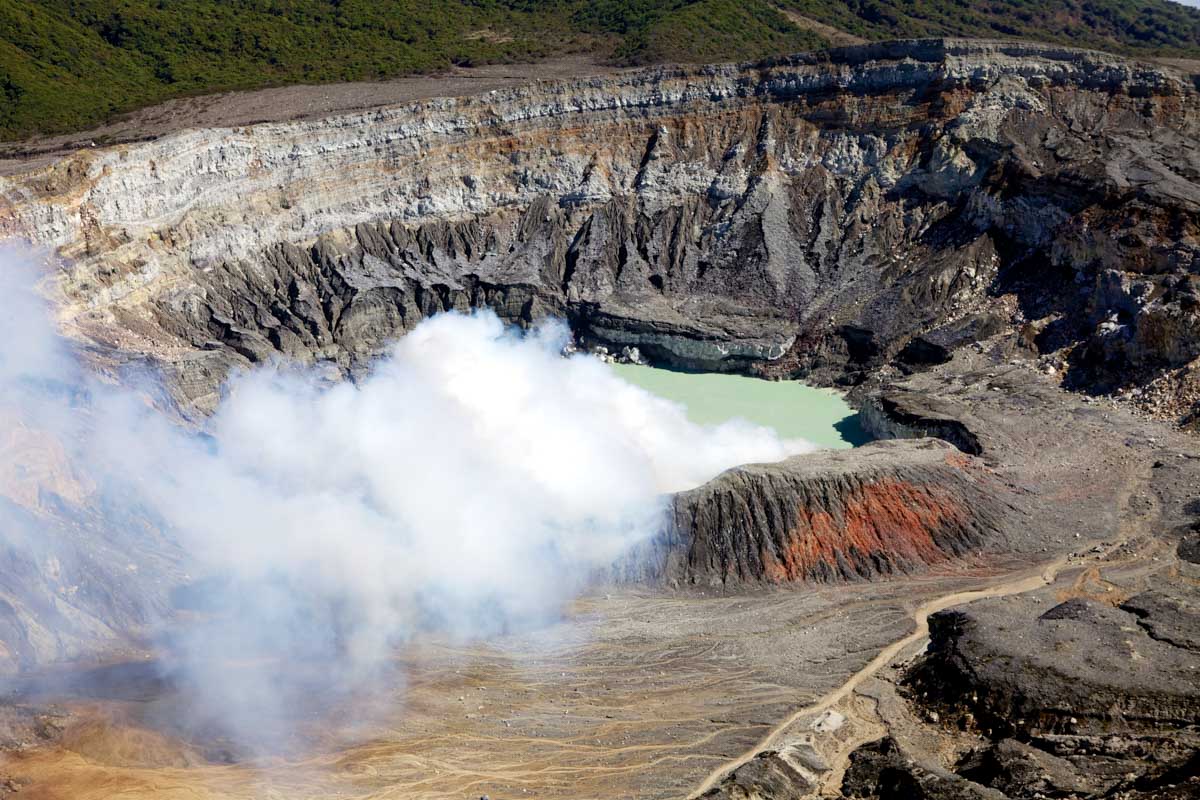
Poas Volcano National Park was established by the Costa Rican government in 1955 and remains one of the most visited National Parks in the country today. The entire protected area is 6,506 ha. It is easy to get from San Jose to Poas Volcano on a day trip . It’s about a 1.5-hour drive, making it the perfect excursion to add to either end of your journey.
Towering high above the Central Valley, Poas sits at 2,708 meters (8884 feet) above sea level and has a history of eruptions. Since the mid-1800s, Poas has erupted 39 times with explosions of varying intensity. Some of the more significant eruptions have even ejected steam and debris over 1,000 meters (3280 feet) above the lake!
The last blast happened just a few years ago, on September 30, 2019. Experts consider the volcano to be in a constantly active state. However, most eruptions are incredibly mild and are caused by the interaction of the hot lava with the water in the crater lake.
Travelers from around the world make the journey to Poas each year, and it remains one of the most popular tourist attractions in all of Costa Rica.
The park was closed to the public for a while in 2017 due to volcanic activity. A massive cloud of volcanic ash damaged some of the infrastructures, but the park reopened with limited access in 2018. Many of the neighboring attractions remain closed due to damage caused by the sulphuric acid rain from the evaporating lake water, but visiting the volcano and hiking the crater is still well worth the trip – and plenty of additional safety precautions have been added.
The larger of the two craters that top Poas is a mile wide and filled with bright bubbling water in a spectacular shade of greenish blue. This lake, known as Laguna Caliente, which translates to Hot Lake, is 900 meters (2953 feet) deep and considered the world’s largest geyser.
Lucky visitors might enjoy the rare opportunity to get up close and personal with an active volcano while remaining relatively safe from dangerous eruptions. Even luckier visitors might have the chance to witness a geyser-like eruption during their visit, caused by water seeping into the pockets of the volcanic rock and heating up until it becomes explosive steam.
2. What are Poas Volcano’s opening hours?

Poas Volcano is open to visitors from 8 am until 4 pm in the afternoon each day, with the last tour at 2 pm. In other blogs, it is suggested that the last entrance is at 1:20 pm. However, this is not true. The last entry allowed is at 2 pm so long as you have a ticket purchased in advance.
It’s also important to remember that the volcano can close at any time, unexpectedly, due to increased volcanic activity. However, this is not common.
Outside of this time, the volcano is closed to visitors, and there is a locked gate at the entrance to Poas Volcano National Park.
3. How much does it cost to visit Poas Volcano?

The cost to visit Poas Volcano is $15 USD for non-residents (foreigners) over the age of 13 and $5 USD for non-residents under 13. Resident adults of Costa Rica can visit Poas Volcano for 1,000 Colones ($1.90 USD) and children for 500 Colones ($0.90 USD) . All children under 2 are free!
On top of that, parking does cost money which I detail below.
4. Do you need to purchase your entrance ticket to Poas Volcano in advance?
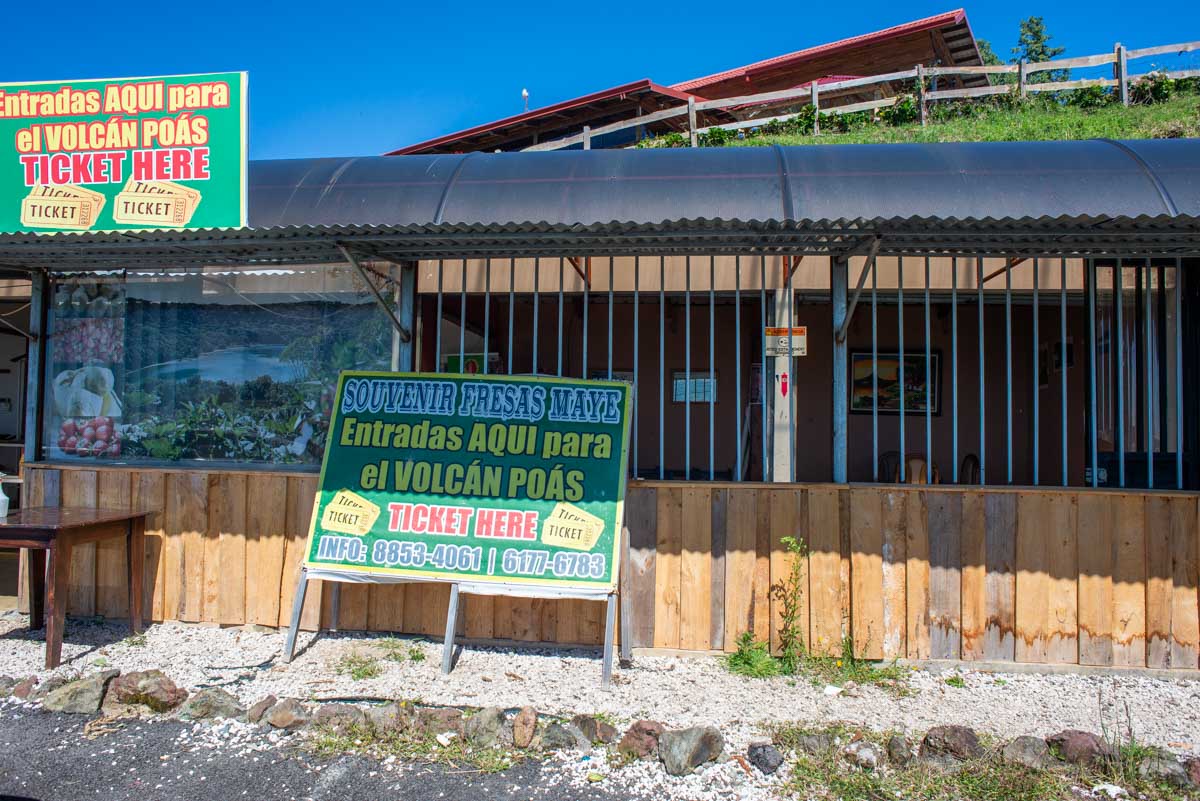
Poas Volcano is only open for a limited amount of daily visitors, so it is important to book your tickets ahead of time. In fact, they do not sell tickets at the gates of the park.
When booking, you will select a 20-minute time slot ahead of time for your tour booked online. Only a limited amount of people are allowed to visit the volcano during each time slot, so it’s a great idea to book at least a few days ahead, maybe more during the busy season.
If you can’t book ahead, there is an option to pay at Fresas Maye , which is a small fruit stand 2 kilometers (1.24 miles) from the entrance. We didn’t want to book ahead when we visited just in case of bad weather, so we chose this option. Without issue, we were able to pay and visit for a slight cost increase, which worked out just fine for us. The lady just books online for you and charges you extra.
There is no internet here so you can’t book yourself.
Even so, choosing to pay at Fresas Maye is a risk, and you could miss your time slot or have to wait around for a while, as time slots may be packed with prepaid bookings. We were visiting in November, so this was not an issue. But those visiting from December to April should book in advance – this is the busiest time of year to visit Costa Rica .
5. What are the best Poas Volcano Tours?

If you want to get the most out of your trip, booking a tour to Poas Volcano is a fantastic option. Many tours offer transportation that significantly reduces the stress and cost of traveling from nearby cities like San Jose. You’ll be with a knowledgeable guide who will enrich your trip with all kinds of exciting information about Poas and the surrounding area. If you’re interested in booking a tour, check out a few of our favorite options!
Half-day tour
If you’re traveling from San Jose, Costa Rica, check out this excellent half-day small group tour . You’ll be picked up from your hotel in a comfortable shuttle early in the morning to ensure your arrival at Poas before the clouds move in. Tour the volcano with your small group and a knowledgeable local guide who will tell you all about the incredible volcano. The tour takes about 4 hours total and costs about $110 USD.
3 in-1 tour
This three-in-one tour allows you to experience Poas Volcano in all its glory, along with a visit to a coffee plantation and a trip to the stunning La Paz waterfall gardens. You’ll be picked up early in the morning from your hotel in the San Jose area and transported on an air-conditioned shuttle to all of the amazing spots. The tour includes breakfast and lunch along the way and all of your entrance fees. For the cost of only $166 USD, it’s a bargain for an unforgettable full day of fun.
Poas Volcano and Starbucks Coffee Tour
Starbucks lovers will adore this unique experience , including visiting Poas Volcano and Costa Rica’s Starbucks Farm. Aside from viewing Poas, you’ll get to go behind the scenes at the massive commercial plantation that provides Starbucks with tasty coffee beans. It’s one of the best coffee tours on offer in Costa Rica ! The tour includes pick-up from your hotel in San Jose, along with lunch and bottled water, throughout your journey for $150 USD per person.
Scenic flight over Poas Volcano
Are you looking for a truly unforgettable way to experience Poas Volcano? Check out this one-of-a-kind private helicopter tour that gets you up close and personal with the beauty of Poas and its famous crater. Avoid the crowds and capture perfect areal photos of the fantastic colors of the crater lake on this two-hour private tour and one hour in flight. The cost is $950 for groups of up to six.
Why We Book Tours with Viator
Viator is a trusted online booking system for tours around the world! We almost always book our tours using Viator for a couple of reasons:
- Free cancellation on most tours – Most of the tours on Viator allow you to cancel and get a full refund up to 24 hours in advance. This is handy in case plans change, or if booking an outdoor activity, the weather forecast is looking grim.
- Reserve now and pay later – You can secure your spot on some of the most popular tours well in advance and not pay until closer to the day of the tour.
- Lowest price guarantee – If you happen to find the same tour at a lower price elsewhere, Viator will refund you the price difference.
- Pay in your chosen currency – Avoid costly international transaction fees by choosing to pay in your home currency.
- Peace of mind – When booking with tour operators you find in person on the street or in small booking offices, you are often promised one thing and given another. This online platform holds tour operators accountable with a written description of inclusions as well as the opportunity for customers to leave reviews.
Check out the Viator website here ! Or, for more info, read our detailed review about Viator here .
6. When is the best time to visit Poas Volcano?

To make the most of your trip to Poas Volcano, arriving as early as possible is a good idea. The high elevation means significant cloud cover rolls in after about 10 am. It often stays cloudy for most of the day and then clears up again around 1 pm (but this changes every day.) If a morning trip isn’t possible for your schedule, try aiming for that last afternoon time slot to get a clear view of the crater and lake.
The rainy season in Costa Rica is from May until December, and during those months, it can often be cloudy or rainy all day, which will take away from experience and cause most of the volcano to be covered in clouds.
The dry season is from mid-December until April, which coincides with the peak tourist season. While Poas Volcano will be more crowded during the dry months, they’re still the best time to visit.
7. How do you get to Poas Volcano?
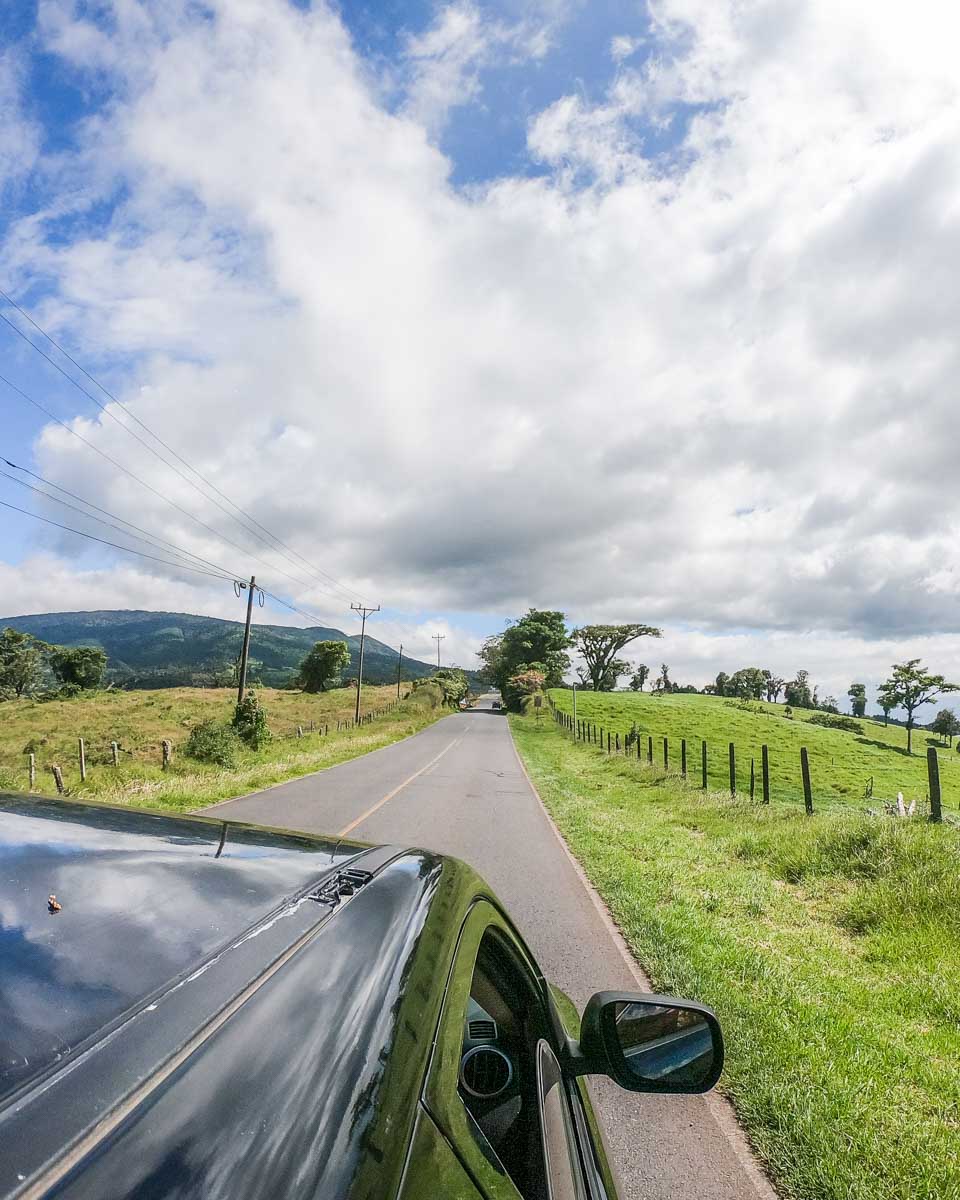
For the least amount of stress, booking a tour from San Jose to Poas Volcano is a great idea. The tours will include transportation from your hotel and plenty of options. This half-day tour is an excellent choice for those who just want to check out Poas without worrying about transportation.
If you’re looking to travel to Poas Volcano via public transportation, the good news is that there is a bus route. Although some blogs mention catching a direct bus from San Jose, this does not exist. Instead, your first step is to get the bus from San Jose to Alajuela and then catch the Poas Volcano bus from Alajuela .
San Jose to Alajuela
This journey costs around $1 USD and takes 45 minutes. The bus departs from the San Jose City Center bus station at Avenida 2, right across from La Merced park, and takes you to Alajuela with TUASA.
From Alajuela to Poas Volcano
Once you arrive in Alajuela, you’ll need to make your way to the FECOSA Terminal, which is located between Central and 2nd Avenue and 6th and 10th street, only 150 meters (490 feet) south of TUASA Terminal, Alajuela Downtown.
This bus departs ONLY on weekends and holidays at 9 am, costs $2 USD, and takes you to Poas Volcano. If you take this bus, it is recommended to book your tickets at Poas for 10:40 am or 11 am. You NEED to book this in advance as they won’t let you on the bus without a ticket.
The bus then returns from Poas Volcano back to Alajuela at 2 pm.
Poas Volcano is a popular tourist destination, so if you’ve rented a car , you can simply plug Poas National Park into GPS, which will take you straight there. The drive from San Jose to Poas is a little under an hour, as long as there isn’t any traffic. There are plenty of options for renting cars in San Jose, and it’s a good idea to book ahead of time. If you’re looking for the best deal for rental cars to reach Poas Volcano, click this link .
8. Is there parking at Poas Volcano?
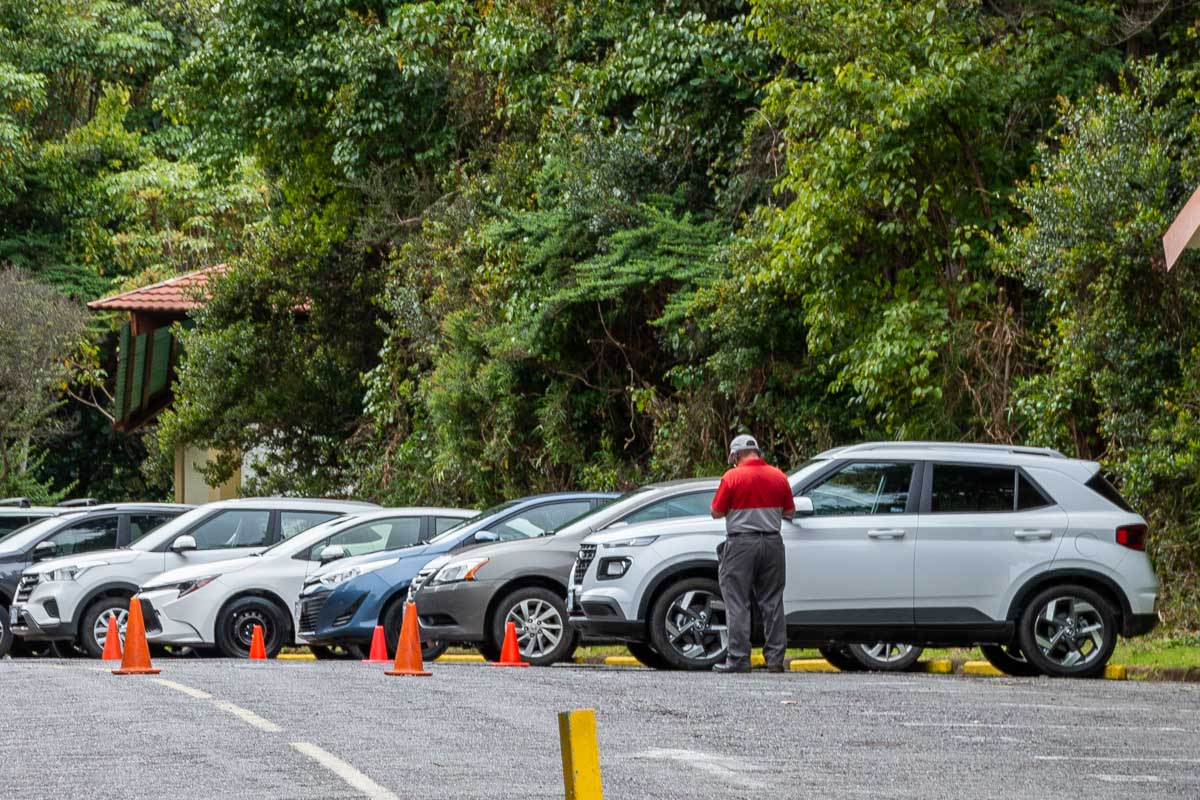
Poas Volcano does have a nice big parking lot. It costs 1000 colones ($1.90 USD) for a motorcycle, 2,000 colones ($2.77 USD) for a light vehicle, and 4,000 colones ($7.50 USD) for a bus to park for the duration of your stay. This fee must be paid in cash. USD or Colones is fine.
As an added bonus, the parking lot is under surveillance, so you can feel safe leaving your gear in the car while you visit the volcano.
9. Facilities at Poas Volcano?

There are restrooms available at Poas Volcano for all visitors to use, but no potable water, so make sure to pack plenty of water and beverages.
When we visited, there was a small gift shop and cafe that served food and drinks, and we could pay with cash and credit card. The gift shop and restaurant are currently closed but will likely reopen with the influx of tourists during the dry season.
Related Read: There are some really amazing restaurants in San Jose that you should check out when you’re there.
10. Is visiting Poas Volcano dangerous?
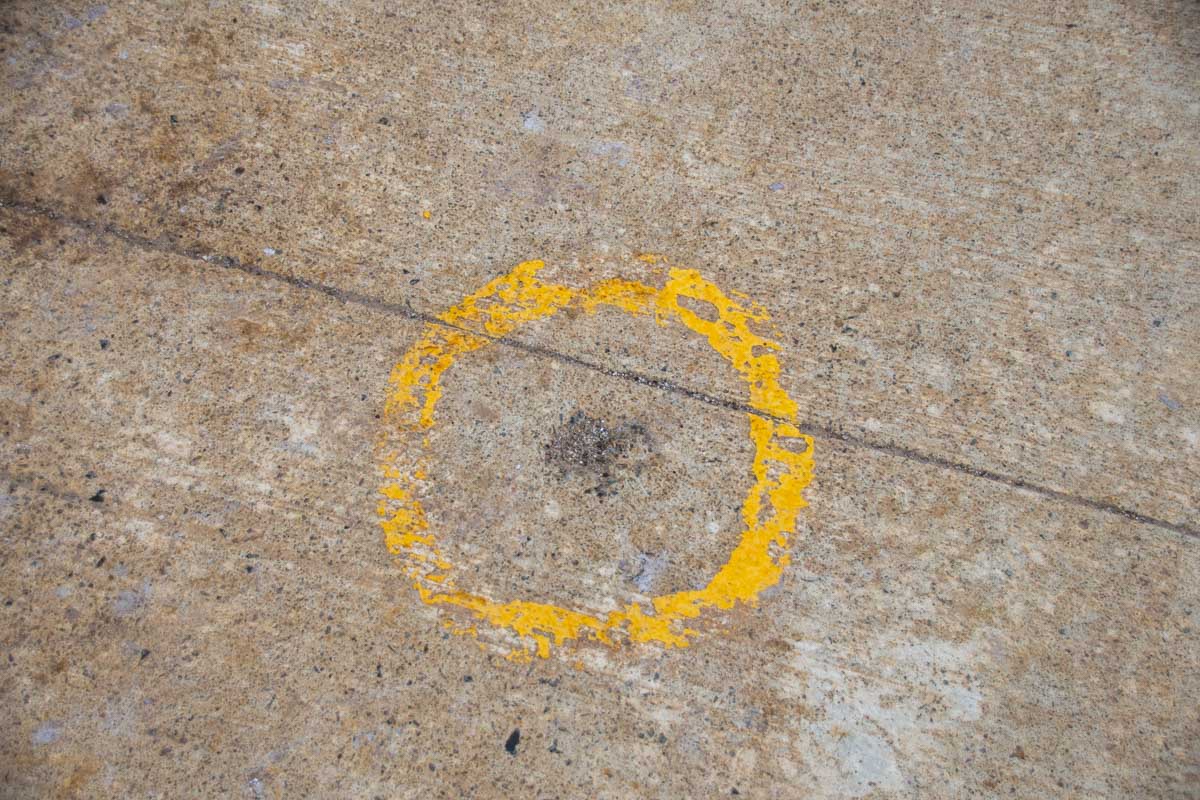
Poas Volcano is constantly being monitored for safety with state-of-the-art seismic testing and alarm systems set up to notify of increases in volcanic activity. There are always risks, as nature can be unpredictable, but for the most part, it is considered very safe to visit.
The park can close unexpectedly if volcanic activity increases to an unsafe level.
Additionally, you are required to wear a hard hat (provided with your entrance ticket). There is also a safety video you must watch before going to the volcano. Once at the viewing platform, there are shelters in place too that you can go into in the event of an eruption.
11. Is Poas Volcano suitable for children?

Poas Volcano is a great place to visit with kids. Unlike some other popular national parks in Costa Rica, the hike (from the center to the viewing platform) is short and suitable for the majority of travelers with kids. The entire walk takes just about 10 minutes. Still, keeping kids close is a good idea as some areas can get slippery, especially during the rainy season.
12. What should you bring to Poas Volcano?
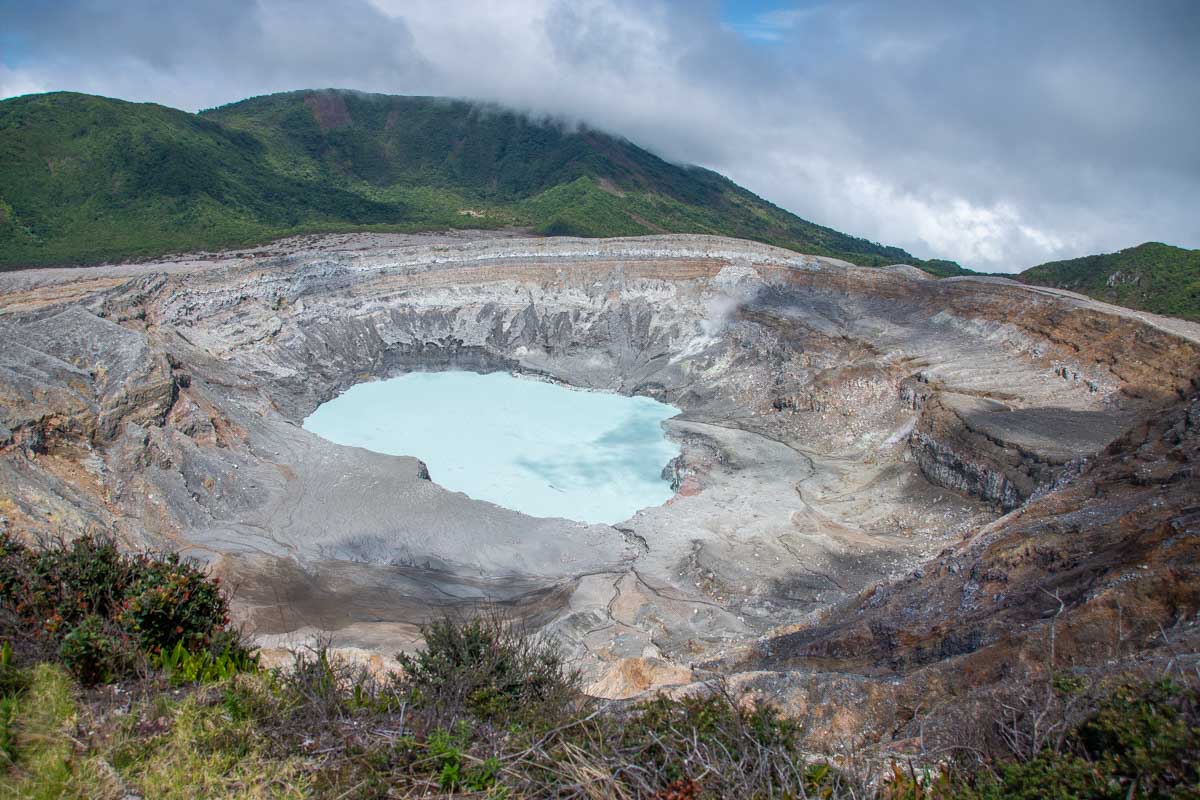
To have the best day ever on your trip to Poas Volcano, it’s important to pack a few essentials for your day trip. Grab a small daypack and include the following items:
- Snacks
- Water bottles – there isn’t potable water, and you will want to be prepared if the cafe isn’t open during your visit.
- Cameras – believe us, you will want to take all the pictures of the amazing crater and brightly colored lake.
- Comfortable shoes for walking
- A windbreaker or raincoat – the high elevation at Poas Volcano means it gets chilly. Be prepared for damp misty weather and rain.
- Warm layers – if you’re used to warmer weather, keep in mind that it is much colder at Poas. If you tend to feel chilled, it might be a good idea to pack extra layers like a sweatshirt and wear pants.
- Cash – it’s always good to have around, and there won’t be any ATMs nearby.
13. What is the tour at Poas Volcano like?
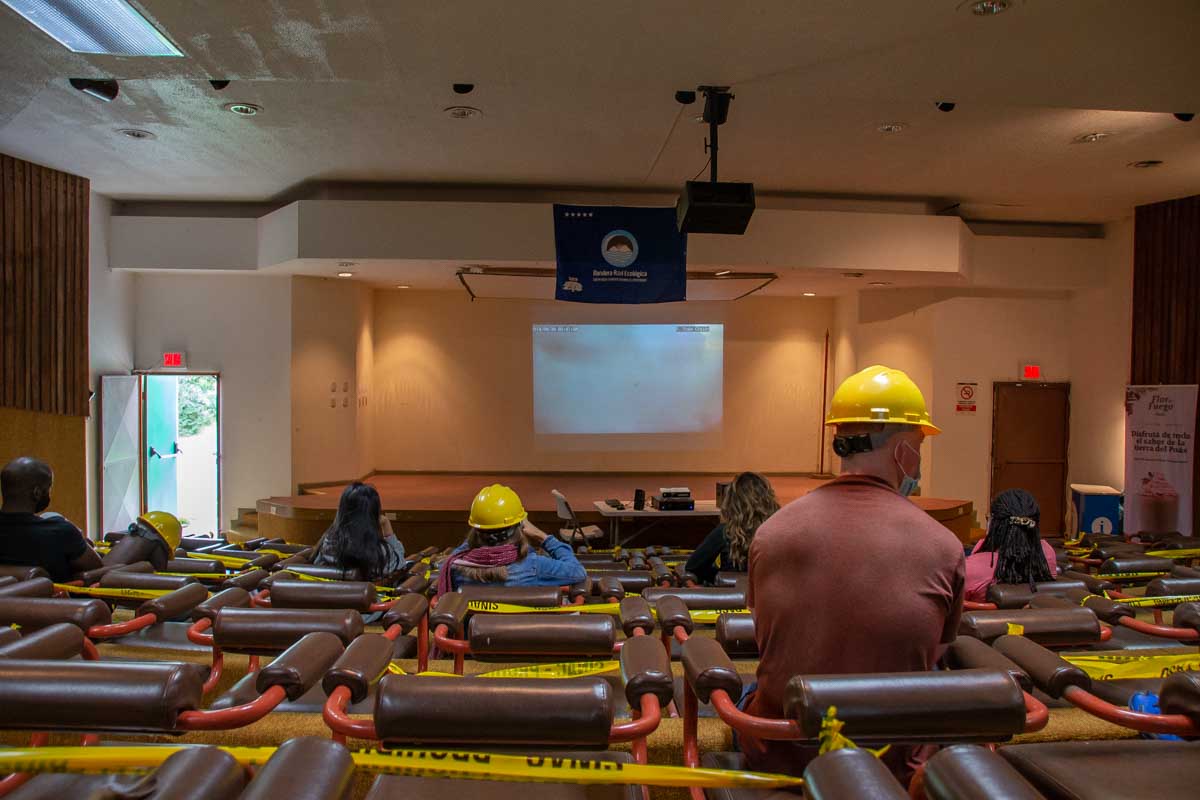
The tour of Poas Volcano begins with your arrival and check-in with the staff. If your time slot is coming up, they will ask you to use the bathroom if you need to before seating you in the movie room to watch a short video about the volcano that includes a safety briefing. To be honest, it’s hard to understand and not that detailed.
Afterward, you will head off along the access road to the viewing platform. This short walk takes around 10 minutes and is only slightly uphill.
Once at the viewing platform, you are allowed 20 minutes at the top, so be sure to explore the entire platform.
At the top, there is a park ranger constantly monitoring the volcano, and there are also safety shelters in case an erruption were to occur. Get familiar with these when you arrive. You never know if you’ll need to use them.
After the 20 to 25 minutes is up, the ranger will instruct you to head back down. We lingered a bit until he gave us the final move-on – they are pretty friendly!
We then headed back down to the visitor center and enjoyed a meal at the cafe.
All up, the experience from beginning to end takes around 1 hour, and it’s not a strict schedule. We were booked in at 10:20 am and didn’t start watching the video until 10:40 am.
I do believe the tour could be better. Having a guide explain more about the volcano would be nice, and it can feel a bit like herding sheep! With that said, this is one of the best things to do in Costa Rica .
Related Read: Be sure to visit La Fortuna and all the fun things to do there !
14. What are the best hotels near Poas Volcano?

Make your visit to Poas Volcano last by booking a room nearby. There are some great places to stay in the area – here are a few of our top choices that are suitable for most budgets.
Altura Hotel $
Altura Hotel is a lovely hotel with pretty rooms and views over the central valley. The decor is modern and trendy, and the property features mountain walking trails. A Costa Rican-style breakfast is included in the morning, and it is only 1.2 miles (1.9 kilometers) from the entrance to Poas Volcano.
Rates begin at $108 USD/night. You can check availability and book Altura Hotel on Booking.com here or Expedia here .
Poas Volcano Lodge $
Poas Volcano Lodge is a boutique hotel right on the perimeter of the National Park. The rooms offer incredible views of Poas Volcano and plenty of amenities. There is a tasty bar and restaurant on site and lovely gardens to explore during your stay. The entire property is stylish, and you can even enjoy the view from your private balcony, making this one of our favorite options near Poas Volcano.
Rates begin at $105 USD/night. You can check availability and book Poas Volcano Lodge on Booking.com here , Hotels.com here , or Expedia here .
Hotel Mango Valley $
Hotel Mango Valley features simple rooms, but the grounds and gardens really shine. The lush green hills and surrounding coffee plantations make for beautiful views, and there is even an outdoor swimming pool to enjoy on warm days. A full breakfast is served daily in the garden.
Rates begin at $57 USD/night. You can check availability and book Hotel Mango Valley on Booking.com here , Hotels.com here , or Expedia here .
Peace Lodge $$$
For a luxurious option that doesn’t cut any corners, head to Peace Lodge . The incredible property features gorgeous rooms with every amenity, a trendy bar and restaurant, indoor and outdoor pools, spa baths, and anything else your heart could desire. Enjoy the views of the mountains or gardens from your private balcony or soak in your relaxing spa tub. Peace Lodge offers a relaxing and high-end experience that you’ll never forget.
Rates begin at $401 USD/night. You can check availability and book Peace Lodge on Booking.com here , Hotels.com here , or Expedia here .
Related Read: Heading to San Jose? Check out the best hotels near the San Jose International Airport .
15. Is visiting Poas Volcano worth it?

Poas Volcano remains one of Costa Rica’s most famous national parks for a good reason. The volcano is breathtaking and one of the most unique places you’ll ever visit. You’ll never forget getting up close and personal with an active volcano, and it’s a must-visit location for anyone visiting Costa Rica.
Getting Around Costa Rica
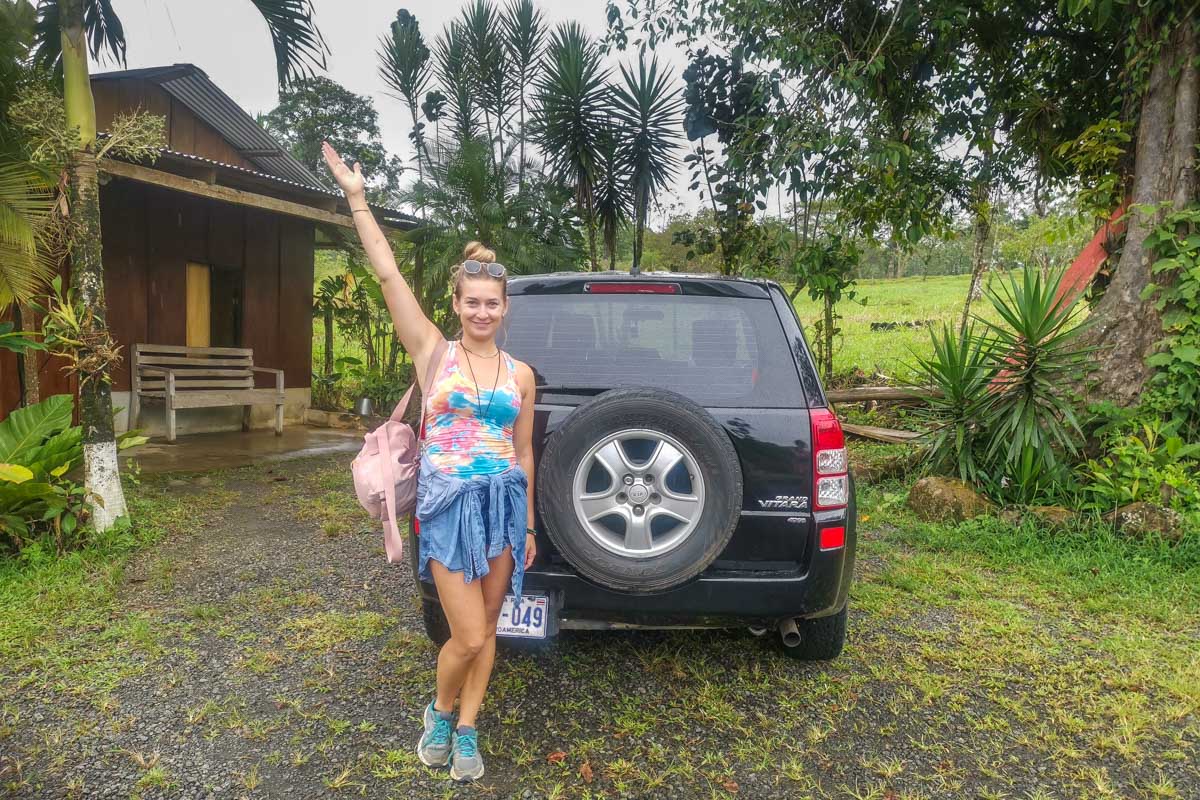
How you choose to get around Costa Rica is one of the biggest decisions you’ll make when planning your holiday here! How you do it depends on your budget, travel style, and comfort level.
Renting a Car
Without a doubt, the number one way to explore Costa Rica is in a rental car. We book rental cars on the Discover Cars website as we have had good experiences with them in the past.
One of the things you need to watch for when renting a car in Costa Rica is the mandatory insurance that the government requires you to have. There are a lot of very cheap rentals that don’t include this mandatory insurance (TPL) in the original booking price, but there are also ones that do. To avoid additional surprise charges when you pick up your rental car, be sure to rent a car that includes the mandatory insurance when you book.
Thankfully, on Discover Cars it’s easy to tell apart the companies that include the mandatory insurance and those that don’t. The trick is you can’t pick any car on their website. In the picture below, you can see this rental car, with pick up in Jaco, includes the TPL. That means the mandatory insurance is included in the price. Any cover you get above that is extra.
Of course, I still suggest getting the full coverage offered by Discover Cars, which covers you even more.
You can browse cars on Discover Cars here .

Book Shuttles
If renting a car isn’t in your budget, you don’t feel comfortable driving in Costa Rica , or you just don’t like driving, shuttles are the next best option. There are hundreds of shuttle routes available all over the country, and they are very affordable.
Shuttles in Costa Rica are specifically for tourists and often include pick up and drop off at your selected hotels and airports. The drivers also speak some English, and the vehicles have air conditioning. You’ll also be guaranteed a seat when you book a shuttle (which isn’t the case with the public bus system.)
To get the best price, use the website Bookaway . They compare all the offers and prices of shuttle companies in Costa Rica so you get the best price! Honestly, we have saved so much money using Bookaway!
You can search for shuttles online on Bookaway here.
Lastly, you can use the public bus system. On short journeys, such as from San Jose to La Fortuna or Uvita to Manuel Antonio, this system is great. However, the longer the journey the more hassle and time spent on a bus. It’s undoubtedly best to save the public bus in Costa Rica for short and straightforward trips!
The public buses are definitely the cheapest way to get around Costa Rica, but they are not always very reliable and schedules often change without notice and delays are to be expected. The buses can also be very crowded and hot – so just be prepared!
It’s also good to speak some Spanish if you plan on riding the public bus since most drivers and ticket booth operators don’t speak English.
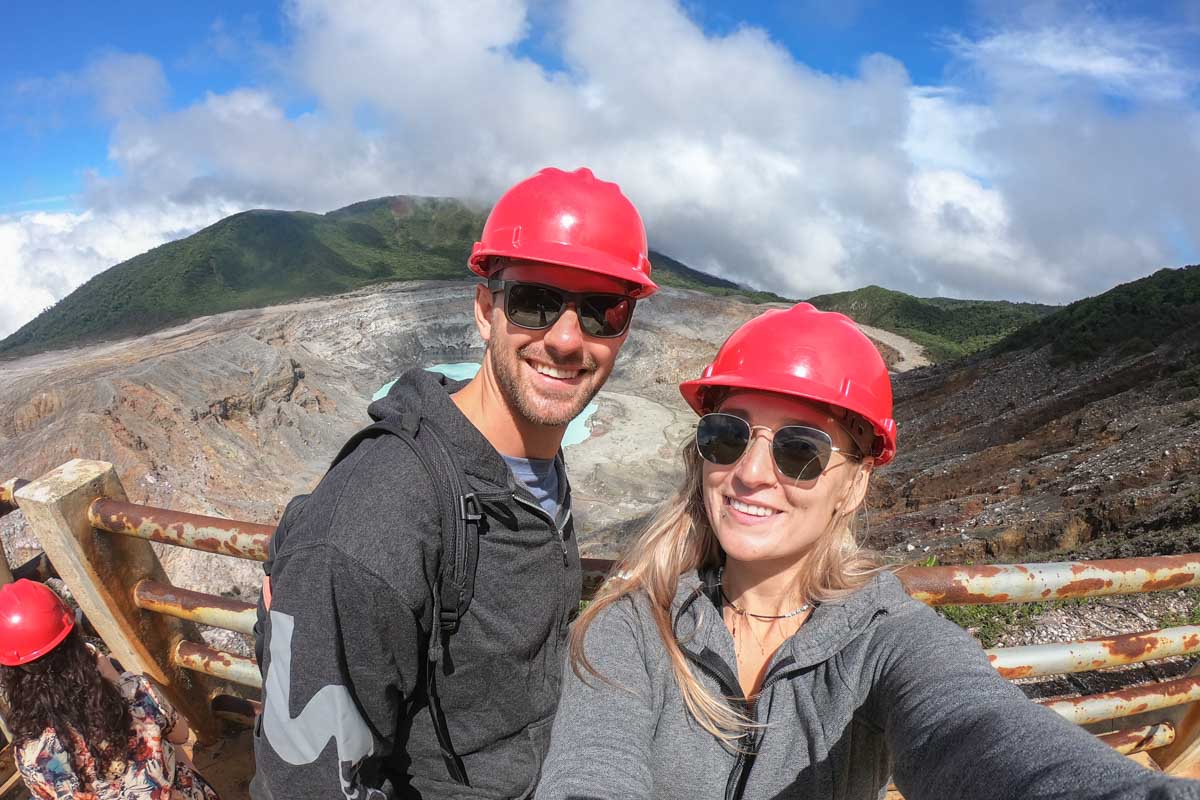
And there you have it – everything you need to know about visiting Poas Volcano. I hope you enjoy it as much as did, and that you have clear weather for a wonderful view of the crater lake.
If you found this blog helpful, check out some of our other detailed guides including:
Guide to visiting Manuel Antonio National Park
Things to know about La Fortuna Waterfall
The BEST beaches in Costa Rica
Monday 7th of August 2023
Thank you for this information. Very helpful and well stated.
Sunday 9th of July 2023
This was insanely helpful thank you so much for this!!!

Top 5 Most Active Volcanoes to Visit in Costa Rica & What To Know About Them
You’ve certainly heard that Costa Rica is a country with lovely beaches, stunning jungles, and a vast wealth of flora and fauna, but did you know that it also has plenty of volcanoes? In addition to the five still active, the nation is home to over 100 other mountains considered dormant or extinct.
There are numerous activities, all based on their towering and majestic heights, for tourists to enjoy. For instance, hot springs with mineral-rich water are a magnet for spa fans due to the heat from the volcano’s magma close to the surface. The small elevation fluctuations produce a hub of biodiversity unmatched anywhere else in the globe, attracting both scientists and tourists.
This article will also provide essential information to let you know what is the most active visited volcano in Costa Rica and the top volcanoes to visit for the greatest thrill if you’re planning a trip to this beautiful country.
The 5 Active Volcanoes of Costa Rica

Arenal Volcano
Arenal, at 1,670 meters above sea level, is undoubtedly the most well-known of Costa Rica’s volcanic giants since it is one of the world’s top ten most active volcanoes. It is in the nation’s northern region and towers above the lush surroundings, where the best coffee globally is grown on plantations.
Arenal and its surroundings make a fantastic base for adventurous travel. Therefore, you won’t be let down by the awe of its splendor as you watch the vapor fumaroles flow continuously. The best thing is that you may enjoy this stunning scene while relaxing in naturally heated hot springs that the volcano has warmed.
In addition to being a magnificent conical volcano to admire, it is also home to some of the best hikes in the area and a wonderful zip-lining canopy tour. La Fortuna is a small rural community that has managed to hold on to its Costa Rican customs. Here, you may sample regional cuisine, travel to nearby natural attractions, and enjoy an incredible view of the Arenal Volcano.

Poás Volcano
This volcano is also among the most well-known places to visit in Costa Rica. Two crater lakes, active fumaroles, and sulfuric emissions make it one of the biggest active volcanoes in the world.
The northern lake, known as the Laguna Caliente or a hot lagoon, is among the world’s most acidic water bodies, in stark contrast to the Botos Lake, which is cool, clear, and encircled by the grandeur of the tropical cloud forest.
For the best views of the crater before the clouds roll in, get there as soon as the Poás Volcano National Park opens at 8 am. Another quick 30-minute hike will lead you to a lovely picnic location on the lake, which is well worth the effort.
The location also has a cafe, a small but highly educational museum with fascinating information about the volcano, and a gift store. You can also visit the La Paz Waterfall Gardens if you have the entire day to spare. That’s what I did!

Irazú Volcano
The Irazu is Costa Rica’s tallest volcano, rising beyond 11,000 feet. In fact, you can see the Pacific and the Caribbean if you’re fortunate enough to reach the peak on a clear day. However, keep in mind that it gets a little chilly up there, so dress warmly.
Despite being a little over an hour’s drive to the east, the Irazú Volcano National Park is not as popular with tourists as the Poas Volcano despite being the nearest to San José. The main crater is 1050 meters in diameter and offers breathtaking views.
The hiking routes surrounding the Irazú Volcano are mostly level, similar to Poas, making them accessible to almost everyone. The sole distinction is that they are not paved, making them less accessible for visitors on wheelchairs.
There are fantastic half-day volcanic tours starting from San Jose for those with limited time. There are also full-day tours that include a luncheon with views of the Orosi Valley and a visit to Lankester Gardens.

Rincón de la Vieja Volcano
The name “ Rincón De La Vieja ” means “corner of the old lady,” which is how the locals refer to it. This volcano, which is Costa Rica’s third-most active, is surrounded by a freshwater lake, geysers, waterfalls, hot springs, and boiling mud pools.
The Rincón de la Vieja Volcano National Park has a vast network of paths that range in length from brief excursions to all-day hikes. Sadly, climbing the crater is no longer possible because of the most recent volcanic activity. However, there are still plenty of mud pits, hot springs, waterfalls, fumaroles, and crater lakes to explore.
You can choose the ideal trail out of the 7 available options, all of which range in complexity. The Las Pailas portion, which has easy hiking trails suitable for people of different physical abilities, receives the most visitors.
As part of a vacation package that includes several of Costa Rica’s well-known eco-adventure parks, experience the thrill of zip-lining, unwinding in natural hot springs, or riding a horse through some of Rincón de la Vieja’s most breathtaking scenery.

Turrialba Volcano
Although Turrialba Volcano is one of the least frequented of our top 5, it is now receiving worldwide attention. This attention is impacting some travelers’ plans for their Costa Rica vacations due to the recent rise in volcanic activity.
It has one of the most scenic roads in the nation since the access route features lovely ranches, coffee plantations, rivers, and authentic displays of rural country life. It is the second-highest volcano in Costa Rica, rising 3,340 meters above sea level. The mountain lies in a cloud forest, so the temperature is fairly cool there—around 55 degrees.
This volcano is well-known for its ongoing release of ash and white smoke. It is also home to remarkable fauna, including gigantic toads, agoutis, toucans, armadillos, howler monkeys , and long-tailed hermits. It also boasts of having a wide diversity of natural vegetation splendor.
Turrialba Volcano is about 50 kilometers from San Jose. Since there are no tarmacked roads leading to the destination, the nature resorts surrounding it provide horseback trips to take you up to the summit.
Frequently Asked Questions About Costa Rica’s Volcanoes
How many volcanoes are there in costa rica.
Over 75 million years ago, a volcanic movement created the geography of present-day Costa Rica. Therefore, the country is home to some of the most stunning active volcanoes in the world. The nation is home to approximately 120 volcanic sites, but only five (listed above) are active. Most of Costa Rica’s volcanoes are now protected zones or national parks.
What Is The Most Visited Volcano In Costa Rica?
The Arenal and Poás Volcanoes are currently the most popular and highly visited volcanoes in Costa Rica. The Arenal is endowed with plenty of beautiful natural sceneries to captivate all who visit it. On the other hand, Poás’ location makes it a highly attractive option to visitors since it is a little over an hour from the San José International Airport in the stunning Central Valley.
What Is Costa Rica’s Most Active Volcano, And When Did It Last Erupt?
Currently, the most active volcano is the Turrialba Volcano in central Costa Rica , as it has experienced frequent explosive eruptions from 2016, as well as in January, March, and April of 2017.
Before 2014–17, visitors could climb into the main crater, but an increased volcanic activity that produced thick clouds of volcanic ash forced the closure of Turrialba Volcano National Park. The park and volcano, however, reopened on December 4, 2020, after the eruptions stopped.

Which Volcano Is Better In Costa Rica?
The Arenal Volcano is the most popular and well-known volcano in Costa Rica due to often being considered the best volcano site in the country. It is also Costa Rica’s tourism industry’s show-stopping centerpiece, providing plenty of cool activities visitors can engage in and enjoy.
Some of the most popular ones include; the Arenal hot springs, trekking through the Arenal Volcano National Park’s canyons, kayaking on Lake Arenal, and zip-lining. Additionally, if you want to view and take pictures of a famous, cone-shaped volcano, it’s the best volcano in Costa Rica to go to. I personally found it quite impressive as seen from Lake Arenal.
Which Volcano Is The Biggest Threat To San José, Costa Rica?
The Turrialba volcano is 30 kilometers from the western Central Valley, with approximately 2.1 million residents as of 2010 on the easternmost edge of Costa Rica’s Central Volcanic Range. Since San José is located directly downwind from Turrialba and receives most of the Caribbean’s E-W winds, it could be in danger.
In 1864–1866, an eruption seriously damaged an area 3 km in diameter surrounding the volcano and sent ash over San José city and 130 km down to the Pacific coast . A small, recently opened fumarolic vent produced lithic ash on January 5 and 6, 2010, due to intense fumarolic-phreatic activity (T>500°C).
According to earlier predictions, the very fine ashes dispersed to the southwest and west and eventually reached San José’s eastern suburbs (35 km away). Phreatic or magmatic eruptions in the future (months to decades away) pose a serious hazard to homes and farms within 5 km of the volcano, as well as to agriculture, pastures, and telecommunications on the volcano’s western flank.
Due to the location of the main international airport in Costa Rica, which is on the ash dispersal trajectory, the “worst-scenario” eruption might harm up to 1.5 million people and hinder air travel.
Can You Hike To The Top Of Arenal Volcano?
This enormous mountain (Arenal Volcano) reaches an astonishing 1,657 meters tall, but it does not deter tourists from setting out on expeditions to reach its lava-filled terrain in La Fortuna.
Numerous treks in Arenal Volcano National Park allow you to stroll around the base of the volcano, along the old lava fields, and through the jungle, even though climbing to the top of the Arenal Volcano is not permitted.
The best time to use the trails is by visiting the park between February and April when the place is experiencing dry weather. The routes usually become hazardous and impassable during other times of the year due to heavy rain present in the region.

Is Costa Rica Part Of The Ring Of Fire?
There are more than 250 known volcanic formations in Costa Rica, which is a part of the magnificent Pacific Ring of Fire and has been home to volcanoes for more than 75 million years. However, there are currently only over 100 sites that exhibit volcanic activity.
Three volcanic mountain ranges cut through Costa Rica’s “land of fire”: the Guanacaste Region, which includes significant volcanoes like Rincón De La Vieja and Arenal; the Central Volcanic Zone, which consists of the magnificent volcanoes Turrialba, Barva, and Poás, and; finally, the Cordillera de Tilarán, which includes El Chato.
Last Thoughts
Every year, many people travel to Costa Rica to see the volcanoes since being in the vicinity of such a majestic force of nature is truly captivating. Fortunately, there are many other thrilling activities that you can partake in around the volcanoes.
For instance, many volcano national parks pair well with activities like white water rafting, kayaking, horseback riding, bird-watching, zip lining, volcanic mud bathing, and mountain biking.
Julien is an exploration-minded, curiosity-driven traveler and blogger. On a mission to witness the planet's natural beauty and diversity, he shares his experiences on this website through articles, videos, and photography, including interactive virtual tours.
Fascinated by animals and plants since young, he is also fond of outdoor and so-called extreme sports, often discovered while traveling and practiced back at home where he focuses on improving his knowledge and skills - so he can explore further on the next trip!
More About Me
You May Also Like

What to Expect from Costa Rica’s Summer Weather

What Species of Monkeys Are in Costa Rica and Where to See Them?

Meet The National Animal of Costa Rica, The Sloth

What To Do in Costa Rica When It Rains? Best Rainy Season Activities

26 Things Costa Rica Is Known and Famous For

Meet The National Bird of Costa Rica, The Clay-Colored Thrush
Leave a comment cancel reply.
Notify me of follow-up comments by email.
Notify me of new posts by email.
Click here to see more results

FOR YOU, FOR FREE: 17 years' worth of firsthand Costa Rica trip planning and travel advice compiled into hundreds of articles, plus exclusive discounts. Created by a Costa Rican and a four-time published Costa Rica guidebook author. Welcome, amigos, and as we say in Costa Rica, pura vida!
Our 2023 Moon Costa Rica guidebook (third edition)
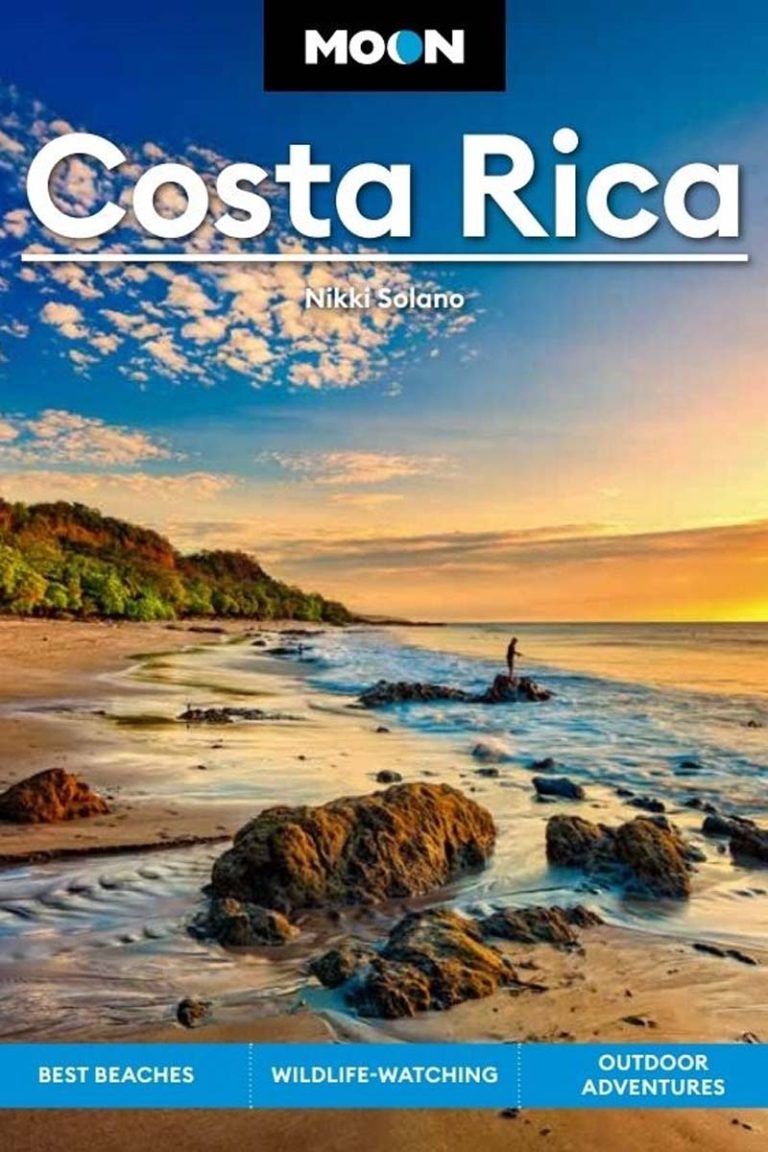
Our 2022 Moon Best of Costa Rica guidebook (first edition)
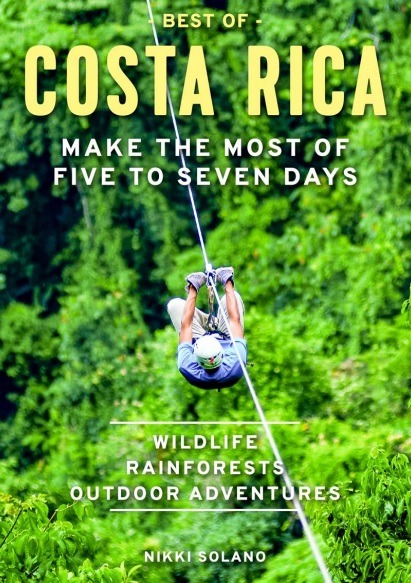
Our 2021 Moon Costa Rica guidebook (second edition)

Our 2019 Moon Costa Rica guidebook (first edition)
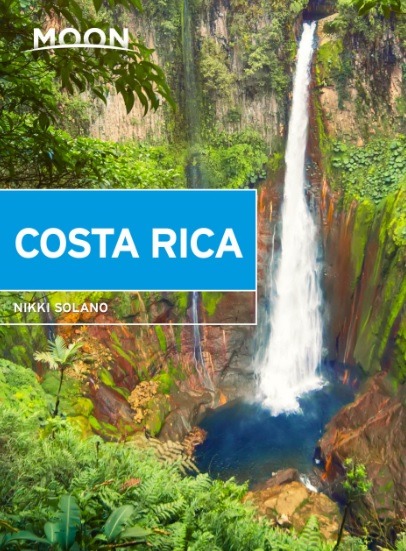
- Moon Travel Guides
- FREE DIY COSTA RICA ACCESS! Details here.
Our company is inclusive. Read our Anti-Hate, Anti-Racism, Anti-Xenophobia, Anti-Inequality, Anti-Discrimination Statement here.
NEW! Our awesome Costa Rica Destination Tool filters 66 destinations by nearly 150 criteria to help you quickly and easily decide where to go in Costa Rica according to your unique preferences, wants, and needs. Learn more and access the tool on our sister site, DIY Costa Rica, here.
How To Experience The Best Costa Rica Volcanoes: Arenal, Poas, Rincon De La Vieja, Irazu, And Turrialba
Home » What To Do In Costa Rica » Volcanoes » How To Experience The Best Costa Rica Volcanoes: Arenal, Poas, Rincon De La Vieja, Irazu, And Turrialba

Last updated on November 7th, 2023 at 02:57 pm GMT-6 (Costa Rica time)

Written by Nikki Solano
Want to know our pick for the BEST VOLCANO TO VISIT in Costa Rica? It is featured on DIY Costa Rica !
Want to save money in costa rica, our sister site, pura vida eh inc., has volcano tour discounts. con mucho gusto (you’re welcome) and pura vida.
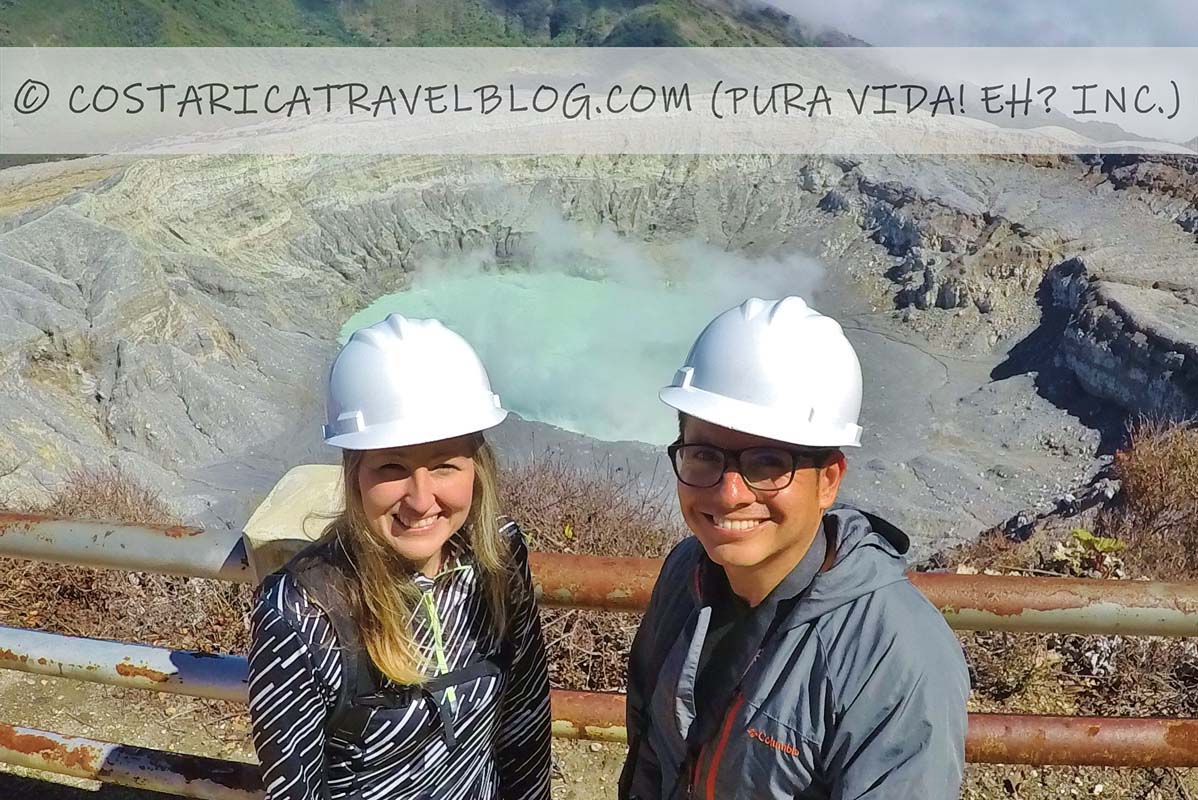
Get the Costa Rica info you need by browsing our article's TABLE OF CONTENTS:
Costa Rica’s active volcanoes: Know this first
Costa rica volcano national parks, map of volcanoes in costa rica, ways to experience the arenal volcano, what’s not permitted at the arenal volcano, a rundown of the arenal volcano national park, ways to experience the poas volcano, what’s not permitted at the poas volcano, a rundown of the poas volcano national park, what’s not permitted at the rincon de la vieja volcano, a rundown of the rincon de la vieja national park, ways to experience the irazu volcano, a rundown of the irazu volcano national park, costa rica volcanoes: the turrialba volcano, which costa rica volcano is the best to visit.
First things first: rugged Costa Rica is ridden with volcanoes. Most don’t take the iconic shape of a cone, and none spew red-hot lava, so unsurprisingly, the majority are mistaken for mountains.
Even if you don’t realize it at the time, no matter where you travel in Costa Rica, you’ll likely drive around or be within eyeshot of a volcano during your trip. This anticlimactic experience probably isn’t enough to wow you, but don’t fret; there are Costa Rica volcano experiences that will. Continue reading below to learn about these experiences, specifically, ways to discover Costa Rica’s top five volcanoes—Arenal, Poas, Rincon de la Vieja, Irazu, and Turrialba —each of which is currently active.
Each of the five Costa Rica volcanoes detailed below is located inside its eponymous national park: the Arenal Volcano National Park , the Poas Volcano National Park , the Rincon de la Vieja National Park , the Irazu Volcano National Park , and the Turrialba Volcano National Park . Each national park welcomes visitors, although the Turrialba Volcano National Park is often closed due to volcanic activity (see below for details). One of the national parks, the Poas Volcano National Park, requires visitors to have a reservation. While participation in volcano tours that take place at the various national parks is encouraged, some activities inside the parks (including hikes to the craters of the Arenal Volcano and the Rincon de la Vieja Volcano) are prohibited.
Without further ado, here’s what you should know about Costa Rica’s top five active volcanoes: the Arenal Volcano , the Poas Volcano , the Rincon De La Vieja Volcano , the Irazu Volcano , and the Turrialba Volcano .
We created the above map to showcase where each active Costa Rica volcano is located. Included on the map are the following sites (each of which we detail in this blog post):
- Arenal Volcano (marked by a mountain icon)
- Irazu Volcano (marked by a mountain icon)
- Poas Volcano (marked by a mountain icon)
- Rincon de la Vieja Volcano (marked by a mountain icon)
- Turrialba Volcano (marked by a mountain icon)
Costa Rica Volcanoes: The Arenal Volcano

For our full article about the Arenal Volcano National Park, don’t miss our related blog post: Why You Should (And Shouldn’t) Visit The Arenal Volcano National Park
The most visited and recognizable Costa Rica volcano is the Arenal Volcano. Though we were lucky enough to spend several years living at the base of this volcano back when it used to erupt on the regular (see our blog post Why You Should (And Shouldn’t) Visit The Arenal Volcano National Park for an account of what that was like), nowadays, only faint puffs of smoke escape its crater. Smack dab in the heart of Costa Rica’s epicenter of adventure (the town of La Fortuna; see our blog post Must-Know Info About La Fortuna Costa Rica From Longtime Residents for our La Fortuna city guide), the Arenal Volcano is the showstopping centerpiece atop the table of Costa Rica tourism. It’s also the best Costa Rica volcano to visit if you want to see and/or snap photos of an iconic, cone-shaped volcano. Though the most straightforward way to experience this particular Costa Rica volcano is to hike around its national park, there are actually countless ways you can experience the Arenal Volcano during time spent in touristy La Fortuna. Here are a few suggestions.
You can view the Arenal Volcano at a distance while:
- Touring hanging bridges
- Riding an aerial tram
- Soaking in hot springs
- Horseback riding
- Bird-watching
- Mountain biking
- Riding an ATV
- Kayaking or stand-up paddling on Arenal Lake
- Strolling around downtown La Fortuna
- Staying at an accommodation in the La Fortuna/Arenal area that provides volcano views
- Crossing Arenal Lake (coming to or from Monteverde)
You can hike trails around the foothills of the Arenal Volcano at:
- the Arenal Volcano National Park
- Arenal 1968
- El Silencio Mirador y Senderos
- The Arenal Observatory Lodge
You can combine a guided volcano tour (i.e., a hiking tour around the foothills of the volcano) with the following guided experiences:
- Waterfall visits
- Hot spring visits
- Zip-line tours
- Hanging bridge tours
- Horseback riding tours
- Mountain biking tours
- Safari float tours
Apart from the inclined trails that you’re welcome to hike around the volcano’s base, hikes on other trails that lead up the steep slopes of the Arenal Volcano are strictly prohibited. This means that it is not possible to arrive at and/or see the crater of the Arenal Volcano.
- Experience type provided: volcano visit, educational walking/hiking tour
- Location: west of downtown La Fortuna, on the road to the community of El Castillo
- Sectors that are open to the public: two; the Main Sector and the Arenal Peninsula Sector
- Operating hours: 8:00am to 4:00pm daily
- Visit recommended for: individuals of all ages
- Parking: free parking on-site
- Bathrooms: free bathrooms on-site
- Degree of physicality required to visit: low to moderate, depending on the trails that are hiked
- Wheelchair access/suitable for the mobility impaired: no, but there’s a volcano viewpoint that can be accessed by car (no hike required)
- On-site attractions: great bird-watching, multiple volcano viewpoints, Arenal Lake viewpoints, an observation tower, an opportunity to climb over lava rocks, an opportunity to view a giant Ceiba tree
The average Arenal Volcano experience: Since it isn’t possible to reach the crater of the Arenal Volcano, most Arenal Volcano tours stick to the volcano’s foothills where flat and hilly trails weave through forest and decades-old lava rocks roughen the landscape.
Costa Rica Volcanoes: The Poas Volcano
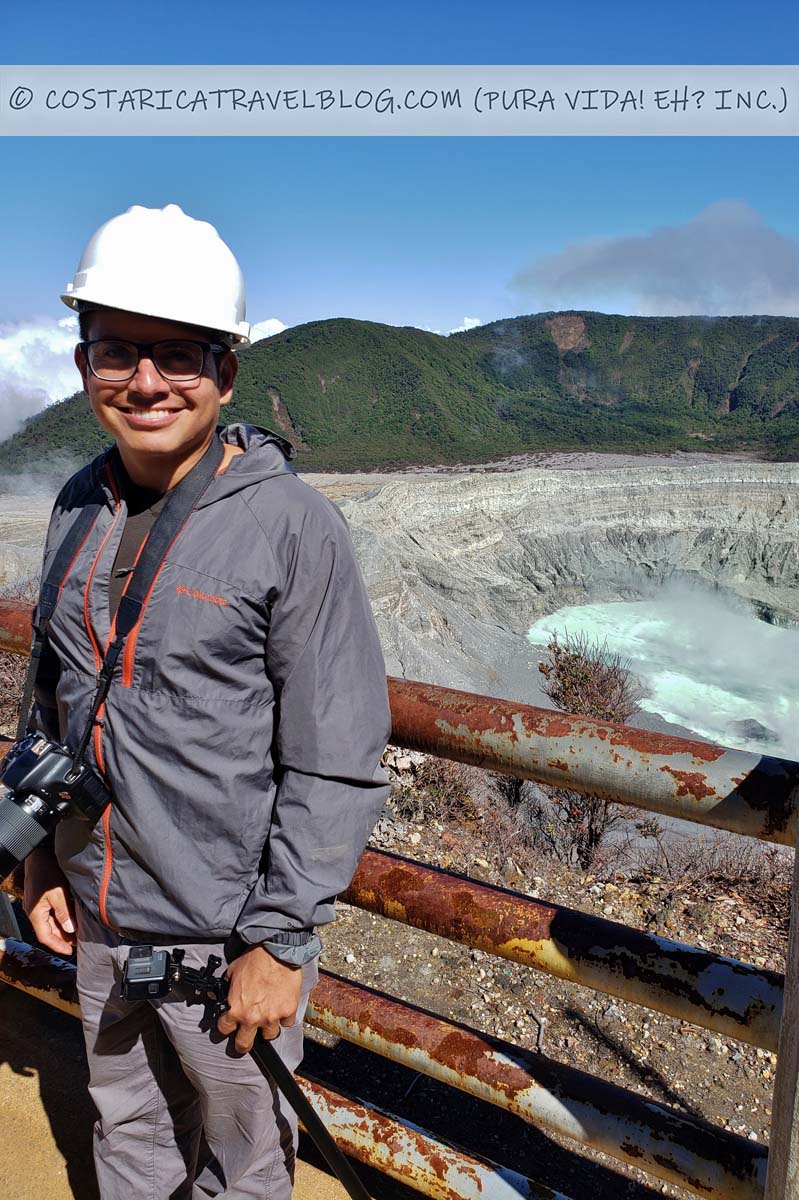
For information about planning a visit to the Poas Volcano National Park , don’t miss our related blog post: How To Reserve The Poas Volcano National Park (Screenshots)
The Poas Volcano has long been one of the most popular Costa Rica volcanoes to visit, thanks in part to its proximity to the Juan Santamaria International Airport (SJO) (a one-hour drive). What makes visits to this particular volcano tricky to coordinate, though, is the fact that reservations for the date and exact time you plan to visit are required (see our related blog post How To Reserve The Poas Volcano National Park (Screenshots) for information about the reservations process). If you aren’t opposed to following the reservation process and committing to an exact date and time for your visit, you’ll be able to experience the one and only way to currently visit the Poas Volcano, which is to walk the short, wheelchair-accessible trail that leads directly to the volcano’s active crater from just beyond the parking lot. If you do that, you’ll be rewarded with an opportunity to stand at the edge of the crater —a pretty incredible experience on clear, sunny days when the crater’s beautiful blue pool is visible.
Unfortunately, hiking trails inside the Poas Volcano National Park other than the main trail that leads to the main crater, including the forest trail to Lake Botos that we used to love to explore, are closed to the public.
- Experience type provided: volcano visit, educational walking tour
- Location: north of downtown Alajuela, near Poasito
- Sectors that are open to the public: one; the Main Sector
- Operating hours: 7:00am to 2:00pm daily
- Visit recommended for: individuals of all ages, especially young children, seniors, and others who would prefer an easy walk
- Parking: paid parking on-site
- Bathrooms: free bathrooms on-site
- Degree of physicality required to visit: low
- Wheelchair access/suitable for the mobility impaired: yes
- On-site attractions: crater viewpoint, the educational display about volcanoes inside the park office
The average Poas Volcano experience: The accessible crater atop the Poas Volcano draws in crowds of sightseers. Poas Volcano tours involve driving up the volcano’s slopes and walking the short, paved trail that connects the parking lot and the crater.
Costa Rica Volcanoes: The Rincon de la Vieja Volcano
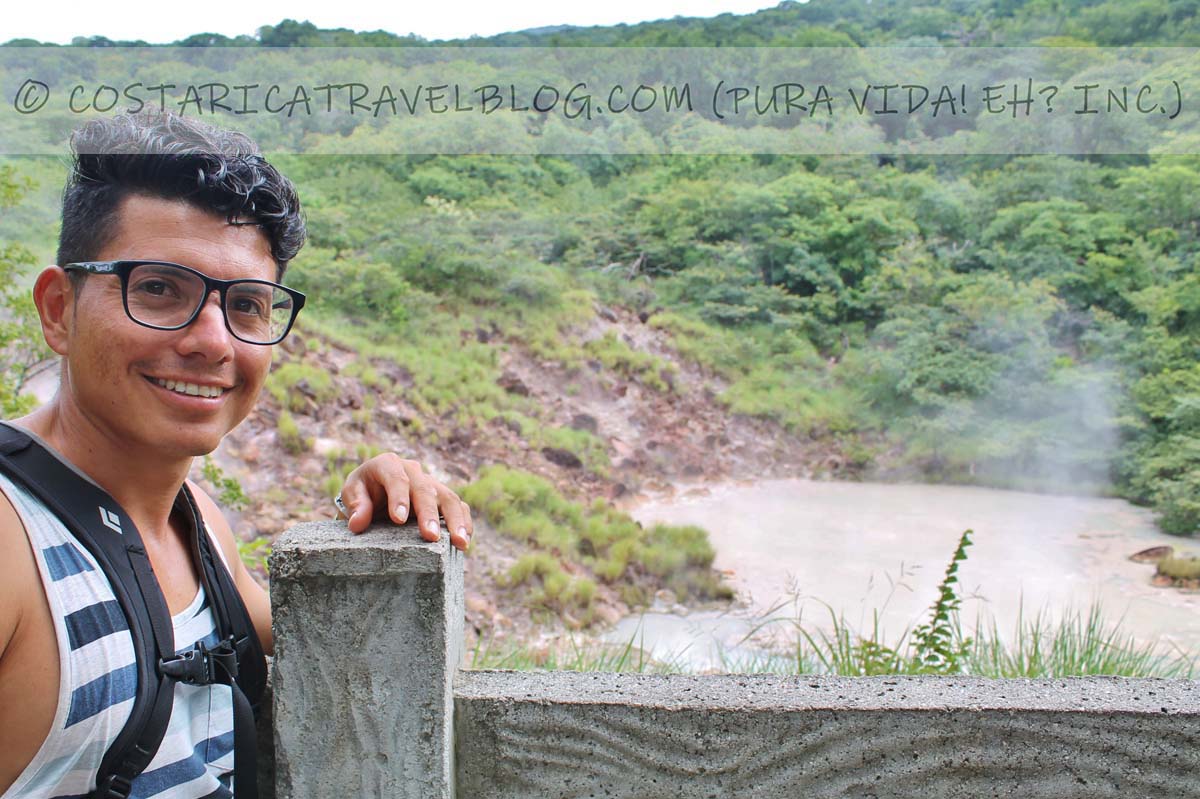
With each passing year, interest in visiting the Rincon de la Vieja Volcano increases, mirroring the growth in popularity of the adventure centers that dot the volcano’s foothills. Fortunately, this volcano still feels off the beaten path despite its path becoming more trodden, mainly because it sits at the end of a long road that cuts through a rural area, and is a 45-minute drive from the nearest city. Because tourism in the Rincon de la Vieja area is understated, this is the best Costa Rica volcano to visit if you want to couple your visit to a volcano with other adventure or nature tours but you’d rather not travel to a busy, highly sought-after destination like La Fortuna. Like visits to the Arenal Volcano near La Fortuna, though, the Rincon de la Vieja Volcano can be experienced in a few different ways. Here are some suggestions:
You can view the Rincon de la Vieja at a distance while:
- Participating in adventure or nature tours run by adventure centers like Hacienda Guachipelin and Buena Vista del Rincon
- Staying at an accommodation in the Rincon de la Vieja area that provides volcano views
- Driving Highway 1 around the city of Liberia
You can hike trails around the foothills of the Rincon de la Vieja Volcano at:
- the Rincon de la Vieja National Park
- Adventure centers like Hacienda Guachipelin and Buena Vista del Rincon
You can combine a guided tour of the Rincon de la Vieja National Park with the following guided experiences:
- River tubing tours
- Canyoning tours
The Rincon de la Vieja Volcano contains plenty of hidden treasures, including bubbling hot springs and mud pots, and smoking fumaroles . These attractions can be dangerous if you get too close, so you must stay behind the park’s guardrails and not go near the hazards. (Swimming in the hot springs is not permitted.). Also, although years ago it was permitted to hike to the top of the Rincon de la Vieja volcano, the trails that lead the way are currently closed to the public; access is strictly prohibited. This means that it is not currently possible to arrive at and/or see the crater of the Rincon de la Vieja Volcano.
- Location: northeast of Liberia, in a remote location
- Sectors that are open to the public: two; the Pailas Sector and the Santa Maria Sector
- Operating hours: 7:30am to 5:00pm Tuesday to Sunday (the Rincon de la Vieja National Park is closed on Mondays)
- Wheelchair access/suitable for the mobility impaired: only the first few meters of the principal trail in the Pailas Sector are paved
- On-site attractions: waterfalls, good wildlife-watching; an opportunity to see a mini volcano (named Volcancito), hot springs, fumaroles, and mud pots
The average Rincon de la Vieja Volcano experience: Since it isn’t possible to reach the crater of the Rincon de la Vieja Volcano, most Rincon de la Vieja Volcano tours stick to the volcano’s foothills where flat and hilly trails pass through forest and lead to fascinating attractions and a handful of waterfalls.
Costa Rica Volcanoes: The Irazu Volcano
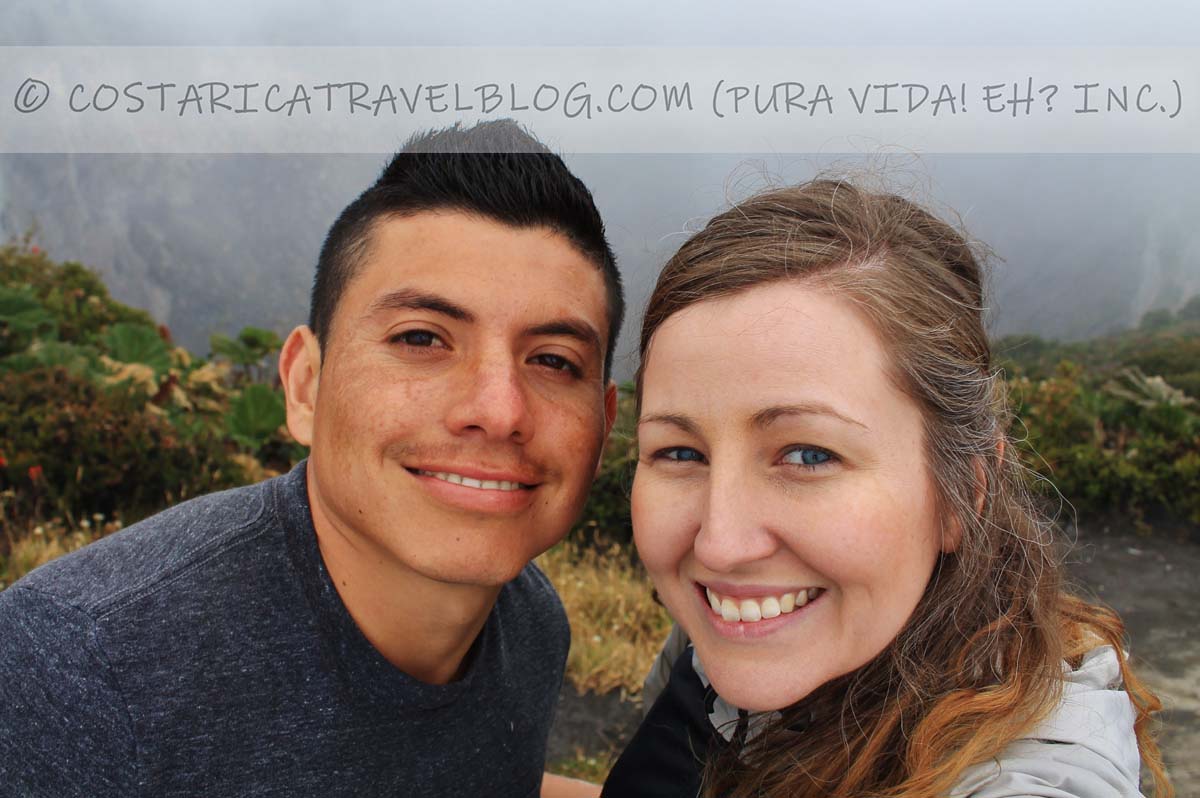
The Irazu Volcano is one of only two Costa Rica volcanoes that permit visitors to stand at the edge of a crater. (The other is the Poas Volcano.) This is the main reason to visit the Irazu Volcano— Costa Rica’s tallest volcano, which sits 11,000+ feet above sea level (more than double the height of the majestic Arenal Volcano)—to peer into its deep, daunting crater. Fortunately, unlike visits to the Poas Volcano, visits to the Irazu Volcano don’t require a reservation , making this volcano the best Costa Rica volcano to visit if you want to lay your eyes on a crater in a hassle-free way. Though there’s only one way to see the Irazu Volcano’s crater, there are actually two ways you can experience this volcano:
- You can walk the short, wheelchair-accessible trail that leads directly to the volcano’s active crater from just beyond the parking lot
- You can hike less-traveled nature trails elsewhere in the park, though you’ll need to drive to the off-site Prusia Sector for that
- Location: north of downtown Cartago, near Tierra Blanca
- Sectors that are open to the public: two; the Main Sector and the Prusia Sector
- Operating hours: 8:00am to 3:30pm daily
- Parking: free parking on-site
- On-site attractions: crater viewpoint, nature trails
The average Irazu Volcano experience: The accessible crater atop the Irazu Volcano is the attraction’s best feature. Irazu Volcano tours involve driving up the volcano’s slopes and walking the short, paved trail that connects the parking lot and the crater.

GREAT NEWS! The Turrialba Volcano National Park has reopened following its closure due to volcanic activity. To avoid providing outdated information about the Turrialba Volcano National Park from visits before it closed and reopened, we’ve removed the majority of content from this section. We will be visiting the Turrialba Volcano National Park in the coming months to conduct new research, and after we do, we’ll update this section to share our findings. Pura vida, amigos! 🙂
When deciding for yourself which Costa Rica volcano is the best to visit, consider our answers below.
- Which Costa Rica volcano is the closest to San Jose/Alajuela/the SJO Airport? The Poas Volcano, followed by the Irazu Volcano.
- Which Costa Rica volcano is the closest to the La Fortuna/Arenal area? The Arenal Volcano.
- Which Costa Rica volcano is the closest to the northern Pacific coast/Guanacaste/Liberia/LIR Airport? The Rincon de la Vieja Volcano, followed by the Arenal Volcano.
- Which Costa Rica volcano provides the best volcano-viewing experience? The Arenal Volcano, if you want to see a cone-shaped volcano, or else the Poas Volcano or the Irazu Volcano, if you want to see a volcano’s crater.
- Which Costa Rica volcanoes provide the best crater-viewing experiences? The Poas Volcano and the Irazu Volcano.
- Which Costa Rica volcano provides the best hiking experience? The Arenal Volcano, followed by the Rincon de la Vieja Volcano.
- Which Costa Rica volcano provides the most rugged, off-the-beaten-path hiking experience? The Turrialba Volcano, when open to the public.
- Which Costa Rica volcanoes are the easiest to walk/hike? The Poas Volcano and the Irazu Volcano have flat, paved trails. The Arenal Volcano and the Rincon de la Vieja Volcano have some easy forest trails in addition to moderate forest trails.
- Which Costa Rica volcanoes provide challenging treks for more experienced hikers? The Rincon de la Vieja Volcano and the Arenal Volcano.
- Which Costa Rica volcanoes are wheelchair accessible/best for the mobility-impaired? The Poas Volcano and the Irazu Volcano.
- Which Costa Rica volcano has hot springs within its national park? The Rincon de la Vieja Volcano. (Swimming in the park’s hot springs is not permitted.)
- Which Costa Rica volcanoes feed hot springs that sit off national park property but can be visited by members of the public for swimming/soaking purposes? The Arenal Volcano and the Rincon de la Vieja Volcano.
- Which Costa Rica volcanoes are most often visited in combination with visits to nearby attractions? The Arenal Volcano, followed by the Rincon de la Vieja Volcano. Truly, though, visits to any of the five volcanoes described in this article can be combined with visits to nearby attractions.
- Which Costa Rica volcano provides an opportunity to view lava? Currently, no Costa Rica volcanoes emit lava.
QUESTION TO COMMENT ON: Have you visited one of the above-mentioned Costa Rica volcanoes? Which one did you pick, and why?

Hey, Costa Rica Travel Blog reader, thank you for visiting and reading our blog! We're truly grateful for your time and preference.
Do you know that your spam-free reading experience is most important to us? Unlike some other Costa Rica blogs, we do not to sell your personal information, and we choose not to display ads, sponsored content, or affiliate marketing on our blog so we can keep your visit as distraction- and junk-free as possible. Because we prioritize your privacy, we don't earn money when you visit us, when you sign up for our e-course, or when you click on our links, which means the time and work we put into this blog—including its 300+ articles—is entirely voluntary! If you find our content valuable, and you'd like to thank us for making the trip-planning process easier and your Costa Rica vacation more enjoyable , please consider making a small donation ($1, $2, $3, or an amount of your choosing) to our blog. Doing so is a great way to pat us on the back if you feel we deserve it . 😊 Pura vida, amigos!

Click on the button above to donate through PayPal. (If you cannot see the PayPal button above, click here .) A PayPal account is not required to make a donation; credit and debit cards are also accepted. PayPal donations are confidential; we never see your payment details.

Tagged: adventure , alajuela , arenal , arenal volcano , cartago , costa rica , costa rica travel , costa rica travel tips , costa rica vacation , guanacaste , irazu volcano , la fortuna , poas volcano , rincon de la vieja , rincon de la vieja volcano , tourism , travel , travel tips , turrialba , turrialba volcano , vacation , volcano
- Author Posts
The comment section of this article has moved! If you have a question or comment about our article above or Costa Rica travel in general, please post it in our Questions and Answers Forum on DIY Costa Rica , our sister website, where you can also access our private Costa Rica recommendations, our Costa Rica Destination Tool, and our Costa Rica Recommendations Map. See you there, amigos! 🙂
Great overview. I’ve only seen Poas and Irazu so far but I enjoyed both for different reasons
Hi mybeardandmypenguin!
Thanks so much! Poas and Irazu are the only two volcanoes (of the five discussed in our article) that welcome visitors to stand at their craters. The views are incredible! It’s great that you’ve had a chance to see both.
Pura vida! 🙂
Great and thorough review! My mother and I are visiting Costa Rica in late May of this year, but we will be staying in La Fortuna. We are staying for seven days, so five full days and two half days. Do you think it’s possible to visit Arena, Poas, Irazu as well as the Paz Waterfall, Orosi Valley, and Lankester Gardens? Our biggest issue is we can’t find a tour company that will pickup from La Fortuna near the Arenal and go to these destinations.
Hi goddivaldi!
Quick question: Will you be flying into San Jose? If so, I’d recommend giving yourself a day at the start of your trip to tour the Irazu Volcano and the Orosi Valley. If you don’t mind departing from San Jose to Arenal the next day, you can combine that journey so you see the Poas Volcano and the La Paz Waterfall Gardens along the way. This means you’d spend the first day in the San Jose vicinity (touring Irazu and Orosi), spend the second day traveling from San Jose to La Fortuna (touring Poas and La Paz along the way), and then spend the next few days exploring in La Fortuna.
Hello, I was that Volcán Rincón de la Vieja is closed due the activity, so it’s imposible to hiking. Do you know something about that? And the hikking to Turrialba there is any agency that could find the information or guide the hike?
Yes! The trails that lead to the craters at the Rincon de la Vieja Volcano are currently closed. But other trails inside the Rincon de la Vieja National Park are open and worth hiking. As for the Turrialba Volcano, this volcano’s national park keeps closing and opening, closing and opening, due to volcanic activity. It is currently closed to the public.
- The forum ‘Costa Rica Travel Blog Forum’ is closed to new topics and replies.
- Kale by LyraThemes.com.
We're Nikki and Ricky, and we're human!
Sadly, ai-generated costa rica blogs and guides are taking over the internet. thank you for choosing our authentic website and resources over others, for trusting our firsthand experience, and for preferring our human-backed recommendations 😀 other ways we are unique:.
✓ We choose not to display ads, sponsored content, or affiliate marketing on our blog. Because we prioritize your privacy, we don't earn money when you visit us, when you sign up for our e-course, or when you click on our links, which means the time and work we put into this blog is entirely voluntary. ✓ Ricky is a born-and-raised Costa Rican and Nikki (married to Ricky) has explored Costa Rica since the mid-2000s . ✓ We've operated our Costa Rica-based business, Pura Vida! eh? Inc. , for 16 years (and counting!) . ✓ Our Costa Rica guidebooks are published by the prestigious Moon Travel Guides brand . ✓ We only ever write about experiences we know firsthand , and we never stuff our blog with general information about Costa Rica that is widely available elsewhere . ✓ We never copy or plagiarize other writers' content . How we wish other writers would show us the same respect! ✓ Unless stated otherwise, every photo displayed on our blog was taken by us, and with our own two hands. (Unlike some other bloggers, who rely on drones to travel and conduct research for them, we actually visit and explore the places we write about .)👍🏽 ✓ We're active in promoting Costa Rica around the world . We've written about Costa Rica for Wanderlust Magazine (UK), presented Costa Rica on Rick Steves' Monday Night Travel Show and podcast/radio show (US), and served as a Costa Rica Destination Editor for Essentialist (Spain). ✓ Our work is backed by hundreds of positive reviews and testimonials ( read some here ) ✓ We are not overly active on social media . Instead of fixating on our own popularity, we spend the majority of our time exploring and researching Costa Rica, updating our various Costa Rica resources, and working with travelers one-on-one. We're focused on the quality of your travel experience , not the quantity of our followers. ❤️
We hope you enjoy your visit to our junk-free blog as much as your time in Costa Rica. 😊

- Privacy Policy Overview
- Remember my preference
This website uses cookies to operate and provide you with the best user experience possible. To ensure you're aware of and okay with this and our other privacy-related practices, please review our Privacy Policy, then click the button below to accept it.
If you do not accept the policy, we respect your choice 100%. Unfortunately, several of our website’s features, including our Questions and Answers Forum, rely on cookies to operate. Most are also run by themes, plugins, and other add-ons to our website that we do not and cannot control, which means the cookies you receive are mainly provided by third parties. Because simple actions like reading our articles, asking a question, and even visiting our website’s homepage require the use of cookies, it is not possible to explore or use our website without them. If you would prefer not to receive cookies, we kindly (and sadly) ask that you do not visit our website. (Alternatively, you can try setting your browser to remove or reject browser cookies before visiting our website, but you may find that our website doesn’t function properly without them.) By visiting or submitting information through our website, you acknowledge and accept our use of cookies, and the use of third-party cookies. For more information, please see our Privacy Policy.
Thank you for understanding!
In order for our site to remember that you accept our policy, please enable the Strictly Necessary Cookie.
If you leave the Strictly Necessary Cookie disabled, we will not be able to save your preference. This means that every time you visit this website you will need to accept the policy again.
- Edexcel IGCSE
- Edexcel A Level Geography Resources
- Key Stage 3 Geography Resources
- All Resources
Visiting the Costa Rica volcanoes: What you should know
The Costa Rica volcanoes should be a highlight of any trip to this beautiful country. They are absolutely fascinating and very beautiful! If you are considering visiting these natural attractions though, it is best to be prepared! In this article I have outlined the top Costa Rica volcanoes and what you should know before you go!
The Costa Rica volcanoes
Costa Rica is sometimes referred to as the Land of Fire. It is also part of the infamous Pacific Ring of Fire, as well as being in the Central American Volcanic Arc. All of this is to say that there are a fair few volcanoes in Costa Rica! Visiting a Costa Rica volcano is a highlight of any Costa Rica itinerary , and in this article I will tell you why!
The Costa Rica volcanoes are all impressive, and three of them are still active. This number was six, up until recently, but given how things are classified it is now three.
The six most recently active volcanoes are:
Turrialba Volcano
- Poas Volcano
Arenal Volcano
Rincon de la vieja volcano, irazu volcano, miravelles volcano.
All of these have erupted at some point in the last 10,000 years. Visiting volcanoes is actually very safe – especially if you go with a guide or expert. You can even soak in volcanic hot springs!

Located in central Costa Rica, the Turrialba Volcano has erupted as recently as 2017. For the past few years visitors have been unable to get close to the volcano due to the increase in volcanic activity and large ash clouds. However, in December 2020, the Turrialba Volcano National Park reopened to the public.
Turrialba is a stratovolcano. It is 3,340 m (10,958 ft) high and has three craters. The largest crater has a 160 ft diameter. You can see the Pacific Ocean and Caribbean Sea from the summit on a clear day, and the forest views are stunning. Ferns, moss, lichens and more line the slopes.
You can access the national park by bus from San Jose, and it isn’t too far away. The city of Turrialba itself is, of course, nearby too. Even before recent closures, this was an underrated volcano in terms visitor numbers. If you are in San Jose it is well worth visiting, though!
You’ll experience far fewer crowds than you’ll see at other volcanoes here. There is an entrance fee (under $10) for those visiting, though you’ll need a four-wheel-drive to do so as the terrain is rugged. Hotel Casa Turire , located nearby, organises guided tours for guests and non-guests. For hiking and birdwatching, the Turrialba Volcano National Park is a great place to visit.
Poas Volcano

Another stratovolcano, Poas Volcano is 2,708 m high (8,885 ft) and is in central Costa Rica. It is located within the Poas Volcano National Park.
Since 1828, Poas volcano has erupted 40 times – the latest being in early 2017. The national park was closed for almost 1.5 years following this, reopening in September 2018.
Near the summit there are two crater lakes. One is a hot lagoon with a varied acidity, which supports barely any aquatic life. While beautiful to look at, the water here causes acid rain and fog.
Access to the Poas Volcano is currently still fairly restricted. You need to book online in order to visit, at a cost of $15 for non-residents. Locals need only pay $1.50 – though everyone needs to book in advance. You show your ticket on arrival, walk along the path to the overlook where you can spend 20 minutes, and then your visit is done. It isn’t the most exciting of the volcanoes in Costa Rica when it comes to seeing it for yourself but if you are staying nearby, it can still be worth visiting!

Arenal is one of the most popular volcanoes in Costa Rica for tourists . The area is actually an ecotourism hotspot , and you’ll see it on many ‘where to visit in Costa Rica’ lists.
Arenal is another stratovolcano, in the La Fortuna district. It is 1,633 m (5,358 ft) high and has a 140 m-diameter crater. Arenal Volcano is less than 7,500 years old which – in volcano terms at least – is pretty young. Following an eruptive period that lasted from 1968 until 2010 (the tenth longest-duration volcanic eruption since 1750), Arenal is now dormant.
You can only visit the base of the volcano. However, the beauty of the area makes it all worth it – the natural wonders here will take your breath away. It is no surprise that around 1.5 million people visit Arenal every year. During the day you can see smoke billowing from the volcano’s peak, and at night you’ll spot basaltic lava streaming down from an active vent on the western side.
The volcano itself is located within the Arenal Volcano National Park, covering 29,962 acres. You can hike, swim, bathe in geothermal springs, go bird watching or horseback riding, try canyoning… the possibilities are endless and Arenal should definitely be on your list if you’re looking at volcanoes in Costa Rica!
For somewhere to stay, check out Arenal Observatory Lodge & Spa . Often called La Fortuna’s #1 eco lodge, the rainforest and farmland here is incredible. You’ll get to see various species of exotic wildlife and so many types of plants. Originally a scientific research station, this lodge is now one of the best places to stay in order to visit Arenal Volcano. With 48 rooms and two holiday homes, alongside a restaurant and spa and a huge observation deck you’ll always have a good view… You can take daily walks, enjoy the swimming pool, peek out from the observation tower and so much more. It’s an amazing place to have as a base for exploring.

Located in the Guanacaste area in the north-west of Costa Rica, this is an andesitic complex volcano. The name means ‘The Old Woman’s Corner’ – this is in reference to a local legend about Princess Curabanda. The volcano is around 1,916 m (6,286 ft) high. You can’t get to the crater due to recent volcanic activity (in 2011) but the area itself is beautiful and worth visiting. There are various lodges and hotels in the area who are happy to arrange tours and activities within the Rincon de la Vieja National Park.
With hot springs to soak in and nature to admire, you can have a great day out here. Guides in the car park are available for hire, too. There is so much to see and you can enjoy a picnic lunch surrounded by the most beautiful scenery! From river tubing to ziplining, you’ll find plenty of adrenaline-pumping activities on offer that are fun for everyone in your travel party.

One of the three technically-still-active Costa Rica volcanoes, it is also the highest. It stands at 3,432 m high, or 11,260 ft. You can see the Atlantic and Pacific Oceans from the summit on a clear day, though it is usually cloudy.
The volcano stands in the Irazu Volcano National Park (5,705 acres of montane forests ) where you can see hummingbirds, owls, armadillos and so much more. The area is around 30 km away from the city of Cartago, and you can drive or take the bus in no time at all. San Jose is only around 50 km away, too.
It is a difficult but rewarding hike if you choose to climb to the Diego de la Haya crater. This is one of the most popular things to do when visiting the Irazu Volcao. Wear layers, because it’s cold at the top! You can visit on guided tours or go it alone – either way, it’s one of the best volcanoes in Costa Rica.

Part of the Guanacaste Mountains, Miravelles Volcano is actually one of the less popular volcanoes in Costa Rica. It has only ever erupted once, in 1946.
This is the site of the largest developed geothermal field in Costa Rica. At 2,203 m high (6,637 ft) it is one of the smaller volcanoes on this list. The area is virtually untouched by tourism – there are no crowds here. This means it is a great place to come if you want to see a volcano in a more relaxed fashion.
Miravelles Volcano is around 2 hours away from some of the most popular beach towns in the country (Playa Conchal, Playa Tamarindo and some others) so if you’re on a beach holiday but want to add in something extra, Miravelles is worth considering.
From the thermal spring at Yoko Termales ($10 entrance fee per adult) to the volcanic activity center at Las Hornillas, there is actually plenty to do and see here! There is even a thermal water park called Thermomania, which is amazing if you’re planning to visit volcanoes in Costa Rica with your children . Thermomania even has an on-site restaurant and bar, meaning it’s fun for all the family…
Costa Rica volcanoes: Further reading
If you are planning a trip to Costa Rica, you may also be interested in the following articles:
- Costa Rica itinerary
- The best eco lodges in Costa Rica
- Costa Rica with a Baby

10 Best Things to Do at Arenal Volcano

Home » Destinations » 10 Best Things to Do at Arenal Volcano
The Arenal Volcano region is one of the most popular destinations in Costa Rica, thanks in part to the countless tours that operate in the area . Travelers have access to secondary rainforests, waterfalls, the country’s largest lake, cultural experiences, and a diverse selection of hotels in Arenal, which has earned it the adventure capital of Costa Rica title in the eyes of many. Whether you’re headed there to zip-line or just relax in the volcano-fed hot springs, Arenal has something for everyone.
Hike Along the Base of the Arenal Volcano.
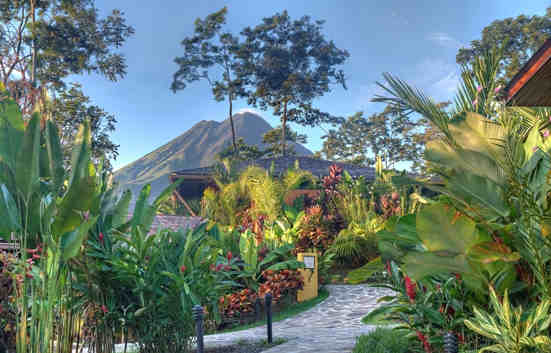
Arenal Volcano as seen from Nayara Springs Resort
Without a doubt, Arenal is the most popular and well-recognized of Costa Rica’s volcanoes. Until recently, it was the country’s most active volcano with an average of 41 eruptions per day. While it isn’t currently legal to hike to the top, visitors to Arenal can we hike along the base of the volcano with a naturalist guide to learn about old lava flows and local wildlife. Combine the hike with a visit to Ecotermales Hot Springs and you’ll have the quintessential Arenal volcano experience.
Related Article: 9 Best Costa Rica National Parks & Reserves
Soak in Arenal Volcano All-Natural Hot Springs.
Is there anything more relaxing than a soak in warm, thermal waters after a day of adventure? Formed when water is heated underground and bubbles to the surface, the Arenal volcano’s mineral waters have been used as therapeutic baths for more than two hundred years. Today, the hot springs are a highlight for travelers after a day of adventurous activities like whitewater rafting and waterfall rappelling. Hot springs entrance is included at some hotels, while other hot springs in the area can be visited with a day pass.
Related Article: Best of Costa Rica Hot Springs & Thermal Resorts
Fly Through the Forest Canopy by Aerial Tram or Zipline.
Arenal hosts one of the best zip-lining experiences in Costa Rica, offering incredible views with a side of adrenaline! You’ll ascend on an aerial tram to the top of an observation point overlooking Lake Arenal. From the observation point, set off on one of the highest and fastest ziplines in Costa Rica! As you fly through the treetops, you’ll be treated to incredible vistas with the Arenal Volcano looming in the background. This exciting Arenal zip-line is a must-do for anyone with a taste for adventure – all ages are welcome!
Experience an Arenal Sloth Tour
The sloth is one of Costa Rica’s most adorable mascots, ranking atop the Must-See Wildlife lists of many visitors. Known to be elusive and subtly tucked among the treetops, seeing a sloth out in the wild can be something of a challenge. Thankfully, the Arenal region is a great place to spot the sweet, smiling sloth of your dreams. Wildlife enthusiasts have a choice of an early morning sloth tour (in general, wildlife is usually best at sunrise) or an afternoon tour that departs after lunchtime. This walking nature tour takes you to the best locations for seeing sloths in Arenal, depending on recent sloth activity reported in the area. If you don’t have a whole day to dedicate solely to sloth tours in Arenal, there’s also a chance you could see one on the Arenal Hanging Bridges Hike and other local nature walks. The Nayara Resorts are known to have a few resident sloths, which guests can watch out for during their stay. The Club Rio animal sanctuary at The Springs Resort & Spa is often home to rescued sloths; this sort of sloth experience is more controlled in a zoo-like setting and is often a great fit for families with very young children.
Visit La Fortuna Waterfall.
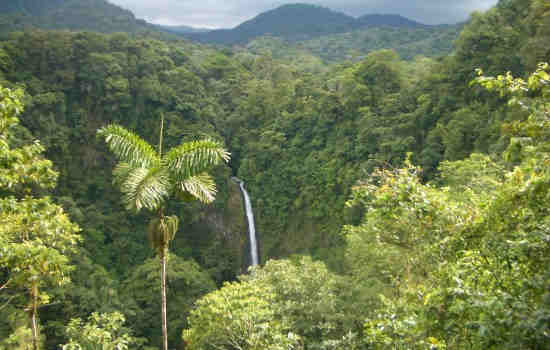
La Fortuna Waterfall from the lookout point
The little farming town of La Fortuna (adjacent to the Arenal hotel zone) is named for its beautiful neighbor, the La Fortuna Waterfall. Surrounded by lush rainforest greenery, La Fortuna plummets 200 feet to fall into a pool of crystal-clear water. Visitors arrive at the park entrance, where the cascade can be observed from a viewing point high above. Then, walk down a long pathway of stairs (about 500, to be exact) for an up-close look at this amazing force of nature. Don’t forget a swimsuit – the pool is delightfully cool on a hot day! Note: Swimming is allowed on the safe areas along the edge of the cascade pool, but stay far from the powerful waterfall.
Related Article: 5 Costa Rica Waterfalls You Must Visit
Each of our 50+ itineraries can be customized to fit your unique vacation style.
Find a Vacation Package >
or give us a call now at 773.935.1009
Arenal Hanging Bridges Hike
The Arenal Hanging Bridges are the best place for a taste of the rainforest during your stay in Arenal. Visitors hike through a private nature reserve along well-maintained trails and across a series of fixed and hanging bridges. This unique vantage point provides a glimpse into life in the secondary rainforest canopy – a unique habitat for birds, monkeys, and countless other Costa Rican creatures. A naturalist guide accompanies guests and reveals secrets about the reserve’s flora and fauna and points out hard-to-spot wildlife. Expert tip: Don’t miss the optional waterfall extension trail at the end of the hike.
Cruise Along Lake Arenal.

A view of Arenal Volcano from Lake Arenal
With the mighty Arenal volcano and the surrounding hills as its backdrop, Lake Arenal is truly a vision. Costa Rica’s largest lake can be explored by kayak or stand-up paddleboard, but the most popular option is a boat ride followed by a gentle walk along the Arenal peninsula trail. Honeymooners should consider the sunset cruise for the ultimate romantic Lake Arenal memories. Even if you can’t fit a lake day into your itinerary, you can certainly enjoy the beauty it adds to the local scenery. Views of Arenal Lake can be admired from zip lines, hiking trails, and en route to your hotel.
Whitewater Rafting Tours Near Arenal
The Balsa River is one of the most popular rafting rivers accessible from Arenal. Rio Balsa’s Class II-III rapids are a great choice for anyone age 7 and up, regardless of previous rafting experience. As with any whitewater rafting trip, your professional guides will teach you the basics of paddling and safety before heading out on the river. The rafting portion lasts about two hours, during which you’ll enjoy scenic forest views and, if you’re lucky, a peek at some local wildlife. The Sarapiqui River can also be reached from the Arenal volcano region. Rafters can choose from level II-III or level III-IV rapids, depending on the desired adrenaline rush.
Look for Wildlife on a Safari River Float.
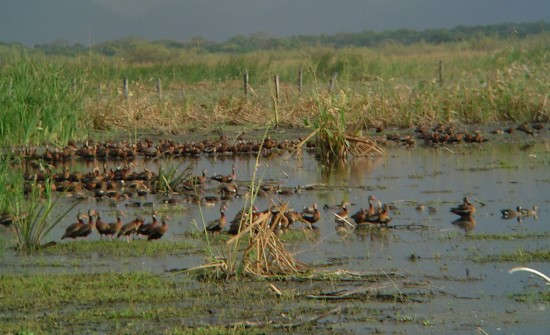
If getting on a raft and paddling through roaring rapids sounds too adventurous, try a safari float down one of the gentle rivers near Arenal. Floating down a river without whitewater rapids is a safe and unique way to experience the nature and wildlife of the Arenal Volcano region. About 45 minutes away, the Penas Blancas River offers a suitable safari float experience for travelers of all ages. If you’re willing to drive a bit further, you can explore the extensive network of rivers and marshes on a day tour of Cano Negro National Wildlife. The refuge is a thriving habitat for a variety of aquatic bird species such as Jaribu storks, roseate spoonbills, and egrets. To see more wildlife, visit in the green season when the rivers swell and the animals are plentiful.
Try a Costa Rican Cooking Class
There’s more to Arenal than zip lines and hot springs. If you’re the kind of traveler who gets excited about a destination’s culinary highlights, try a Costa Rican cooking class in Arenal! This is a great way to explore Costa Rica on a deeper level that involves all your senses. You have the option of getting hands-on with the while being guided by a professional chef, or simply sitting back as you watch and learn the art of local cuisine.
Dining Near Arenal Volcano: The Best Restaurants in Arenal
In the Arenal Volcano area, some of the best restaurants are in the hotel zone. Guests at Nayara Resorts , for example, have access to more than 5 unique dining experiences on-site. Stay at Tabacon Thermal Resort and you’ll have access to not only the best hot springs in Arenal but two of the best restaurants: Ave and Tucanes .
But if you’re looking to venture off the hotel property and explore the culinary scene in Arenal on a deeper level, we recommend a visit to La Fortuna. This small but bustling town hosts a cluster of local restaurants, shops, and tourist offices ready to delight visitors.
Located along the main road that connects downtown La Fortuna to the hotel zone, you’ll find Mercadito Arenal – a one-stop shop for casual and delicious international fare. This self-described “Gastro Market” offers sushi, tacos, burgers, pizza, coffee, and cocktails making it a perfect spot for families and groups!

Grilled Octopus served with fried garlic cream, pickled vegetables from the Fernández Family, and potato croquettes via Restaurant Don Rufino’s Facebook page
Don Rufino is one of Costa Rica Experts’ longest-standing restaurant recommendations in the La Fortuna / Arenal area. Ask your driver or hotel concierge for their recommendations and they’ll probably sing the same praises for Don Rufino. This long-time Arenal favorite does local classics like ceviche as well as intriguing culinary inventions; try the Pejibaye dumplings, the baked BBQ pork pastries, or the date-stuffed meatballs. This place is popular, so be sure to make a reservation on their website.
We usually recommend eating the local specialties when you’re in Costa Rica: colorful tropical fruits, fresh seafood, Gallo pinto, fried plantains, etc. But there are some days when the only thing you want is a delicious pizza, and if that day comes and you happen to be in Arenal, check out Anch’io . Woodfire pizzas, hearty pasta, and world-class wines are the name of the game here, where Italian cuisine is punctuated by subtle local touches. The enchanting courtyard provides a romantic setting for your night in La Fortuna.
For something completely different, follow your nose to India Curry House and experience some of the mouthwatering traditional dishes made with local ingredients. It is a strong contender for the best Indian restaurant in all of Costa Rica –check it out and decide for yourself.
Organico Fortuna is the most popular destination for travelers who want to maintain their healthy lifestyle, even on vacation. The feel-good food includes acai bowls, fresh juices, plant-based soups and sandwiches, vegetarian and vegan-friendly tacos and burritos, noodles, nachos, burgers, salads and more. Herbivores and carnivores can enjoy protein-forward entrees like grilled chicken, fresh-caught tune, and shrimp avocado pasta (to name just a few).
Arenal Volcano Travel FAQ:
Arenal Volcano
Hot springs.
- Tabacon Thermal Resort : Stay as a guest and you’ll receive unlimited access to the Tabacon Hot Springs, allowing you to enjoy them before and after the day trippers arrive. Couples will enjoy the adults-only Shangri-La section, which features romantic palapas, individualized service, and the famous Tabacon spa.
- The Springs Resort & Spa: Families flock to The Springs for the one-stop-shop Arenal vacation experience. The network of hot springs and pools at The Springs is conveniently adorned with a swim-up bar at the main pool and other small bar carts throughout the cleanly manicured grounds. More hot springs can be found at Club Rio, the outdoor adventure activity center at The Springs.
- Nayara Springs: Enjoy your own private thermal plunge pool at Nayara Springs, the adults-only sister resort to Arenal Nayara Hotel & Gardens. Perfect for honeymoons, celebrations, or simply indulging in one of Costa Rica’s best hotel experiences.
- Papagayo: 2.5 - 3 hours
- Bagaces/Upala: 2 hours
- Tamarindo/Guanacaste Beaches: 3.5 hours
- Nosara/Punta Islita: 4 – 4.5 hours
- Monteverde: 3 hours by ground OR 45 minute boat ride + 1.5 hour ground transfer
- Jaco/Playa Herradura: 3.5 hours
- Manuel Antonio: 4.5 - 5.5 hours
- Central Highlands (San Ramon, Bajos del Toro, La Paz): 2 hours
- Tortuguero boat dock (Guapiles): 2.5 - 3 hours
- Pacuare River put-out (Siquirres): 2.5 - 3 hours
- San Jose: 2.5 - 3 hours
- Liberia: 2.5 - 3 hours
YOU DESERVE A VACATION PLANNED BY EXPERTS.
Us headquarters, costa rica office.
Barrio La California, Calles 27 & 29, Ave 2, Ed #2798 Oficina #8 San Jose, Costa Rica 10104
READ OUR REVIEWS

Dreaming of cooler weather?

- DESTINATIONS
- THINGS TO DO
- PLAN YOUR TRIP
Privacy Overview
This is a necessary category.

Two Weeks in Costa Rica
Travel and Moving Blog
The Truth About Visiting Poas Volcano
- Jenn and Matt

11 Comments
Last Updated: August 18, 2022
Poas Volcano is one of Costa Rica’s most iconic volcanoes. At almost a mile (1.5 kilometers) wide and 900 feet (300 meters) deep, this crater volcano is surely impressive. Every day, droves of people head to Poas to try to catch a glimpse of the glorious crater and its blue-green lake. But what many people do not know is that it is actually not that easy to see. Often, the volcano is hidden behind a thick layer of clouds. Moreover, due to current protocols, visits must be planned in advance and the time you can spend at the crater is limited.
In this post, we’ll give current information about visiting Poas Volcano. We’ll include how to reserve tickets, current safety protocols, and what you can expect to see.
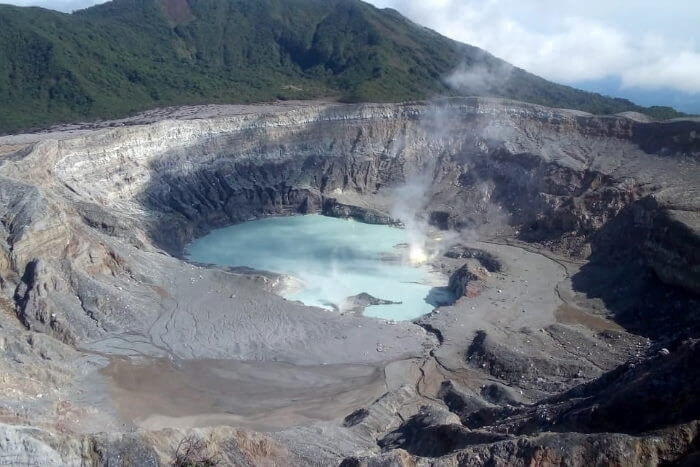
Poas Volcano is located in the mountains north of the capital city of San Jose . Although it looks fairly close on a map, it is still about a one-hour drive due to road conditions. The roads leading to Poasito, where Poas Volcano National Park is located, are slow and steep.
Because of its relative proximity to San Jose, Poas Volcano is a popular destination. Tourists come from San Jose looking for a day trip and locals head to Poas to get out of the city. It’s a big stop for tour companies as well, and you will often see large tour buses in the parking lot.
Tip: Although you can easily visit Poas Volcano on a day trip, it is worth spending a few days in the area. Poasito and the nearby town of Vara Blanca are very charming, with rolling green mountains, strawberry farms, waterfalls, and coffee tours.
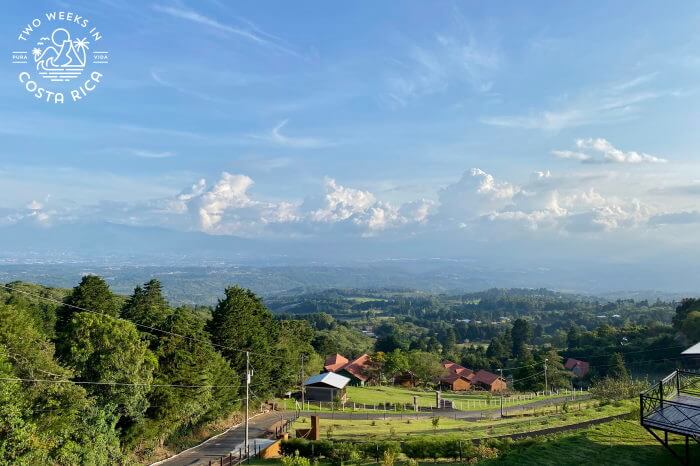
Background on Poas Volcano
Volcanic activity.
Poas is an active volcano (a complex stratovolcano) that is about 600,000 years old. It has been making headlines for the last several years with its showy eruptions.
Although Poas has been active since the 1800s, its activity intensified dramatically in 2017 .
In March and April 2017, the volcano experienced tectonic earthquakes, tremors, explosions (some over 500 meters/1,640 feet high!), and fumaroles (steam columns). It threw mud, ash, and gas, the lagoon changed from green to gray, and strong eruptions destroyed most of what was left of the volcano’s dome.
These eruptions led to the closure of the national park.
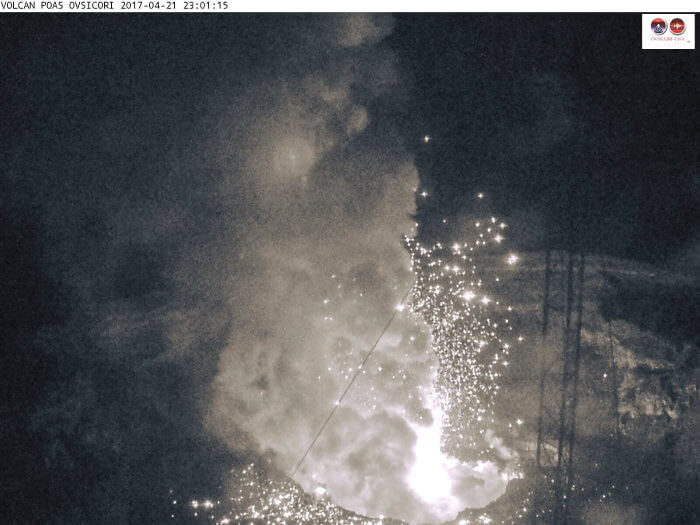
Reopening with Safety Measures
In August 2018, the park was permitted to reopen , after seismologists and health officials deemed it safe for visitors. There were a lot of changes, though.
Now, visits are much more controlled. The biggest changes are that you need to buy tickets in advance and the time you can spend at the crater is limited to 20 minutes.
Reopening of Laguna Botos Trail
Up until July 2022, all side trails at Poas Volcano National Park were closed for safety reasons. As of mid-August 2022, the Laguna Botos Trail is back open .
This is a great change as it gives visitors something else to check out if they don’t have luck seeing the crater.
Buying Tickets to Poas Volcano
To get tickets, you’ll need to go online to the SINAC government website .
First, you’ll create an account. There is a button to change the language to English.
Once you’re logged in, go to Buy on the left, then select Online Reservation.
Use the dropdowns to select Parque Nacional Volcan Poas.
Choose your date and time of visit (under Sector/Schedule). You’ll see that there are 18 timeslots in 20-minute increments. They start at 8:00 a.m. and go until 2:20 p.m.
Select the number of people, adults and children.
On the last page, you will need to fill in everyone’s full names and passport numbers, then enter your credit card information to pay. You’ll then get a confirmation, which also will be emailed to you.
At the park entrance, they will ask to see your confirmation. It’s best to have it saved to your phone in case you don’t have cell phone service at the park.
Visiting Poas Volcano – What to Expect
When you arrive, you’ll drive up to the gated entrance where they will make sure you already have tickets. You’ll likely see people pulled over buying them on their phone who haven’t done it yet. You’ll also pay for parking ($2).
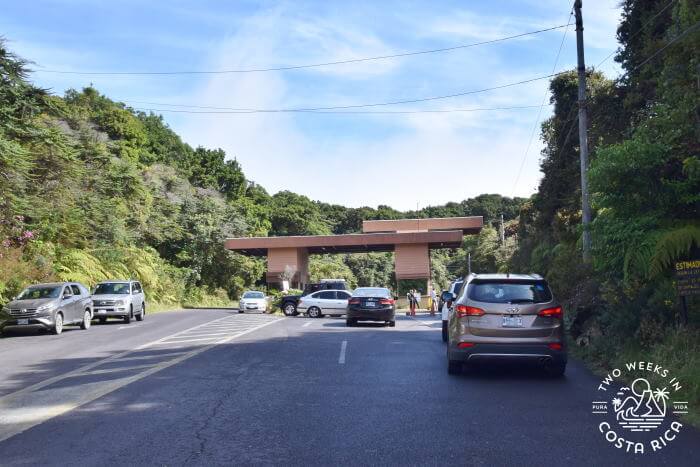
Safety Precautions
You’ll continue to the parking lot and walk to the main reception to get a hard hat.
Now, everyone has to wear a hard hat in the unlikely event of an eruption. This makes for some pretty goofy, but memorable, photos.

You’ll then join the rest of the group in the theater to watch a short video about the volcano and safety measures in place. The video is in several languages.
Near the crater are a few concrete structures in case of emergency. You’ll also notice something that looks like a traffic light. This monitors the level of volcanic gas and would change color and alarm if you needed to head to a shelter. Remember that scientists are constantly monitoring the volcano, so these are just precautions.

Walking to the Crater
Once the movie is done, a park official will escort the whole group (usually they combine multiple groups from different timeslots) to the crater.
The walk to the crater is short, only about 10 minutes, along a flat, paved path. It’s an easy walk, but because you’re at a higher altitude, the air is thinner, which can make it a little harder to breathe.
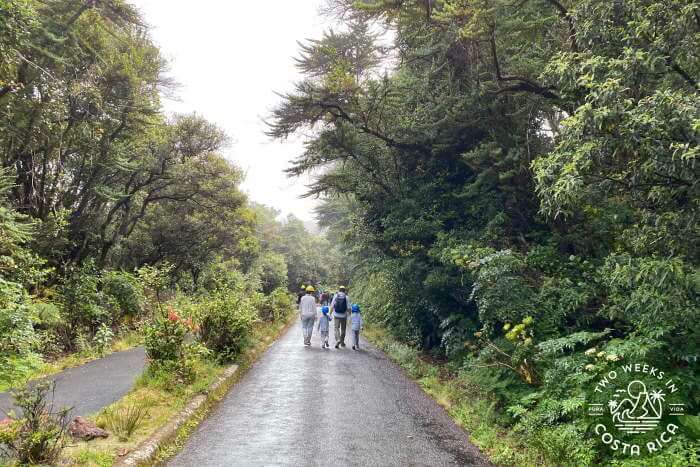
Walking even just the main trail will give you a sense of the beautiful, unique landscape.
Poas has cool temperatures (for Costa Rica), wind, and lots of moisture. The environment is different than elsewhere in the country and the ecosystem reflects this.
One noteworthy plant you’ll see is the so-called Poor-man’s Umbrella plant. These broad-leafed plants are dotted all along the trail and are so large, you could use them as an umbrella. You’ll also see lots of thick moss, vines, and epiphytes (air plants).

Arriving at the Crater
Once you get to the crater, hopefully you can peek past the barrier to get an amazing view! Since the crater is so wide, there’s plenty of space along the edges to get some good pictures.
If you aren’t so lucky and there are clouds, you can wait it out (up to the 20 minutes allowed by your tickets). The weather around Poas is constantly changing so it’s not uncommon for the crater to be clouded over one minute and perfectly visible the next.
But the reality is, it is not that easy to see the crater. We have been to Poas three times over several years and have NEVER seen the crater! We’ve visited at different times of year and in the morning when people say visibility is the best, and the crater has always been completely clouded over. Here is a link to our post, Racing the Clouds at Poas Volcano , about our first time visiting.

This is very common, and now that visits are limited to 20 minutes and you need advance tickets, it’s harder than ever to catch a glimpse of Poas Volcano.
Laguna Botos Trail
If you don’t see the crater, you also can check out the Laguna Botos Trail.
This is a short, 800 meter (0.5 mile) paved path that cuts through thick cloud forest.
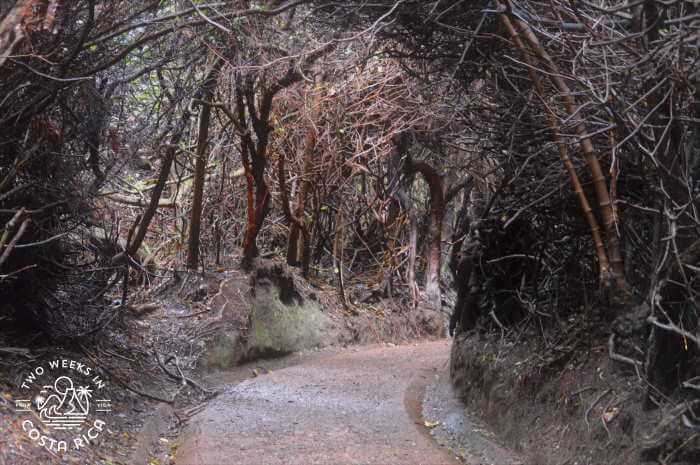
At the end of the trail, you’ll find a viewing platform overlooking Laguna Botos (Botos Lagoon). This is an extinct volcanic crater that is 400 meters (2,525 feet) wide and 14 meters (46 feet) deep. It’s covered in a pool of cold blue-green water.
If the crater was covered by clouds when you tried to see it, chances are, Laguna Botos likely will be obscured covered too. But there’s always the possibility of the clouds lifting.
Live Cam of the Crater
One really cool feature you can take advantage of is a live cam on Costa Rica’s Volcanic and Seismology Observatory’s website. This lets you see Poas’ crater in real time. Here is the link .
We spent some time watching it when working on this article and saw the crater go from full view to complete clouds over and over again!
Sometimes in a matter of 10 or 15 minutes, it can go from completely clear to completely obscured. So it’s definitely worth waiting the 20 minutes at the crater’s edge when it is your turn.
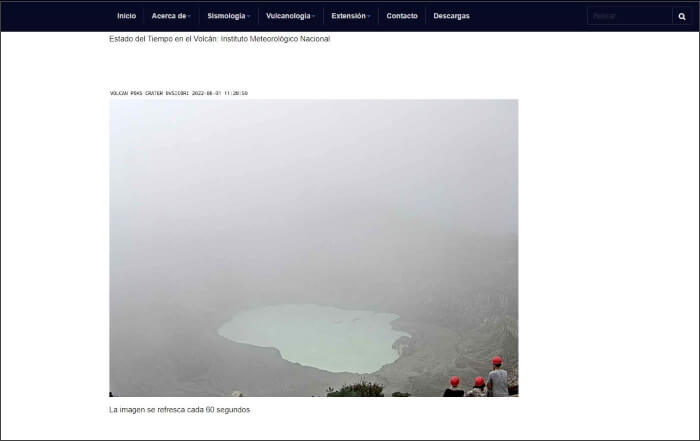
Ongoing Volcanic Activity
Poas continues to have eruptions and monitoring is ongoing. To see videos of recent activity, check out the national park’s Facebook page .
Tips for Visiting Poas Volcano
People say that the best time to see the crater is early in the morning, so when the park opens at 8:00 a.m. We have been early ourselves, getting there before 9:00 a.m., without seeing the crater. So some of it is just luck.
Because of the new protocols with having to get a helmet and watch the movie, it takes a while to actually get to the crater so we recommend getting the earliest time slot possible if you want to be there by 9:00 a.m.
We used to think that it was easier to see during dry season (December through April) but have heard from other locals that it doesn’t really matter if you go in dry or rainy season (May through November).
The national park is busiest on the weekends and holidays.
What to Wear/Bring
Since Poas is high altitude, it is quite chilly, with temperatures around 12°-15 °C (50-60 °F).
Wear pants and dress in layers. Definitely bring a raincoat or poncho, as rain comes and goes and it’s often misty with all the clouds. If you wear glasses, opt for contact lenses that day.
Foreigners: $15 adults, $5 children ages 2-12, free for children under 2.
Citizens and Residents: 1,000 colones adults, 500 colones children ages 2-12, free for children under 2.
Visitors Center
Poas Volcano National Park now has a huge, modern visitors center. Downstairs are bathrooms and upstairs is a large cafeteria and gift shop.
The cafeteria has empanadas, croissants, breads, sandwiches, muffins, donuts, desserts, and an assortment of drinks, including specialty coffees.

Accessibility
Poas Volcano National Park is handicap accessible. A wheelchair can easily go the whole way to the crater.
Poas Volcano is one of Costa Rica’s most famous volcanoes, but if you’re thinking of visiting, know that there’s no guarantee you’ll actually see it. It takes a bit of time and organization to visit so may not be worthwhile for everyone. After trying to see it three times ourselves, it will probably be a while before we venture back.
Have you seen Poas Volcano? Any tips on how to see the crater? Leave us a comment below.
Looking for more information to plan your trip to costa rica check out these posts:.
Arenal Volcano National Park – Arenal is Costa Rica’s best-known volcano. Although this cone-shaped giant also can be hidden behind the clouds, it’s a bit easier to see than Poas.
Irazu Volcano: Easy Access, Crater Views, and Extreme Climate – Irazu is another crater volcano located east of San Jose.
La Paz Waterfall Gardens : Another great attraction in the Poas area is this wildlife center and set of waterfalls.
James Kaiser
2024 Guide to Arenal Volcano National Park, Costa Rica
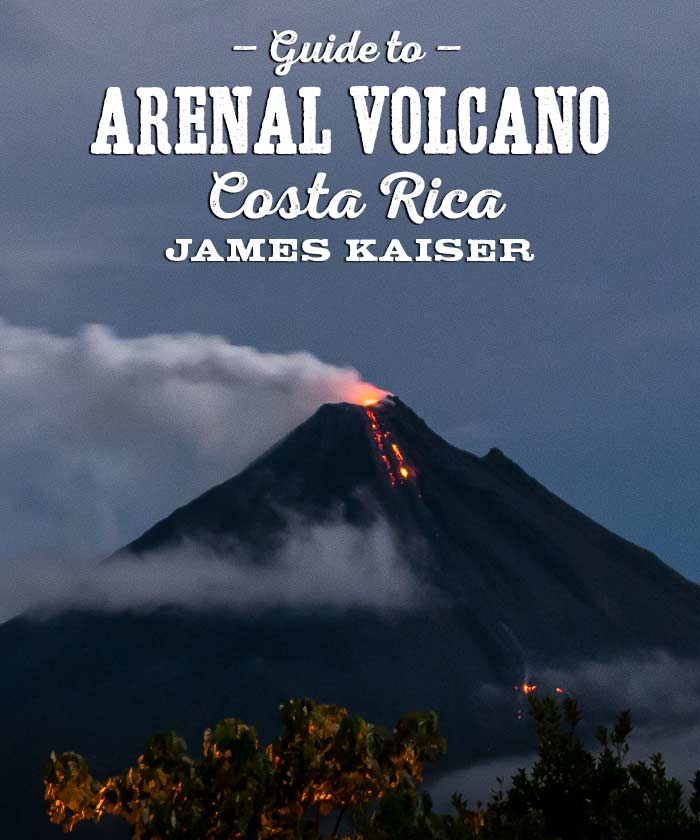
Home / Costa Rica / National Parks / Arenal Volcano
Arenal is Costa Rica’s most famous volcano. In a country filled with incredible volcanoes , that’s saying something.
Few volcanos in the world claim such a perfect conical shape, and few have delighted so many visitors. It started in 1968, when Arenal erupted after lying dormant for nearly 500 years. For the next four decades, the volcano spewed out a steady stream of lava and hot rocks. This attracted a steady stream of tourists who delighted in watching the glowing eruptions (from a safe distance, of course).
Arenal Eruptions & Activity
Then, in 2010, Arenal went quiet. The eruptions stopped , and as of this writing Arenal Volcano is officially considered “inactive.” According to scientists, the last time Arenal stayed inactive for this long, it stayed inactive for several hundred years.
Is the party over?
Not necessarily.
The volcano could rumble back to life at any moment. But let me be honest: even when Arenal was active, seeing it glow was a hit or miss proposition. Because clouds cover the volcano for much of the year, simply catching a glimpse of the erupting peak always required a certain amount of luck.
The glowing lava could only be seen at night (assuming it was a clear night) and only on the volcano’s northern or western slope (depending on which way the lava was flowing). Unless you were staying at a hotel with clear views of the lava on a cloudless night, chances are you wouldn’t catch a decent glimpse of the eruption.
If you did get lucky, however, watching Arenal erupt was one of Costa Rica’s most enchanting experiences.
Visiting Arenal Volcano
Arenal Volcano is a fascinating, beautiful place. But if you visit with expectations of dramatic glowing eruptions, you’ll likely end up disappointed.
So why visit Arenal? Because the region around the volcano is filled with family-friendly eco-adventures. The rugged topography serves up some of the best whitewater rafting and canyoning in Costa Rica, plus canopy tours, waterfall hikes and great wildlife watching.
Arenal is also surrounded by a number of beautiful hotsprings, which means you can finish your action-packed day soaking in a naturally heated pool, cocktail in hand.
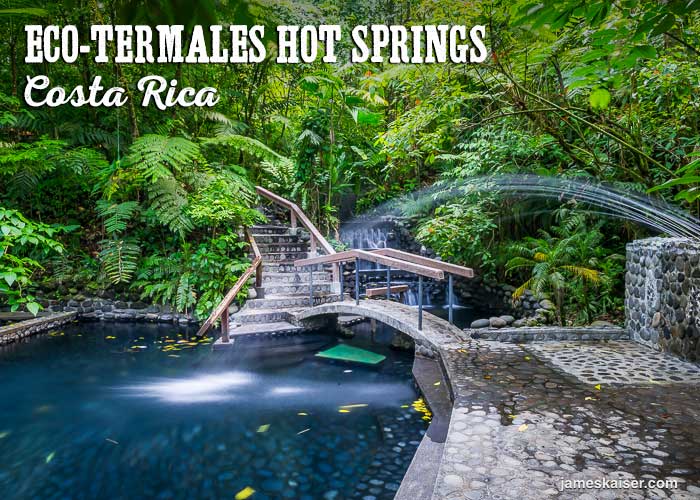
Discover the best Arenal Hot Springs

Arenal Volcano National Park
The views of Arenal from the nearby town of La Fortuna are impressive, but if you’re interested in the volcano’s geology it’s worth visiting Arenal Volcano National Park.
Located near the western base of the volcano — about a 25-minute drive from downtown La Fortuna — the park offers dramatic views of Arenal’s charred western slope, which has experienced multiple eruptions since 1968.
To get to the park entrance, follow the main road north from La Fortuna. About 5 minutes past Tabacón Spa & Resort , you’ll reach a junction marked by a blue and white police station on the right. Head left on the dirt road that heads towards El Castillo. The park entrance is located roughly 2.1 km (1.3 miles) down the dirt road on the left.
Hiking Trails
In addition to dramatic views (on clear days, at least), the park offers 4.8 km (3 miles) of hiking trails.
The most popular trail is the 2 km (1.2 mile) Las Coladas Trail, which heads to the remnants of a 1992 lava flow. Walking on top of the cooled black lava is a truly unique experience. At the end of the trail, an elevated viewpoint offers dramatic views of both the volcano and Lake Arenal.
When you head back, it’s worth taking the 1.8-km (1.1-mile) El Ceibo Trail, which passes by two impressive trees: a giant ceibo and a massive strangler fig. The park also offers a covered viewpoint and the 1-km (0.6-mile) Heliconia Trail.
Local, bilingual guides offer guided tours of the park’s trails. Although the trails are easy to follow on your own, a guide is worth it if you want to learn about the geologic history of the park.
Sadly, the national park doesn’t offer any detailed information about the volcano — no visitor center, no interpretive signs, no brochures, nada . Unless you hire a guide, you won’t learn much about the volcano.
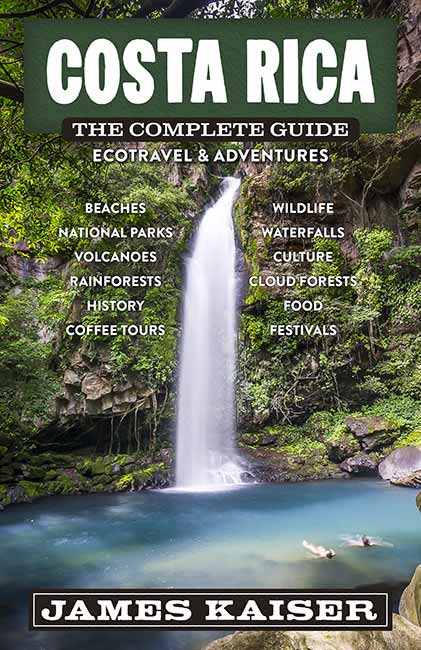
Discover the best of Costa Rica
The #1 Costa Rica guidebook.
Arenal 1968
Another alternative to Arenal National Park is the privately owned Arenal 1968 . Located just north of the national park entrance, Arenal 1968 offers over 30 kms (18.6 miles) of hiking/biking trails, including trails that pass over the original 1968 lava flow. There’s also a trail that passes by Lake Los Patos, which was created after the 1968 eruption. Guided hikes are available, though they are best reserved in advance.
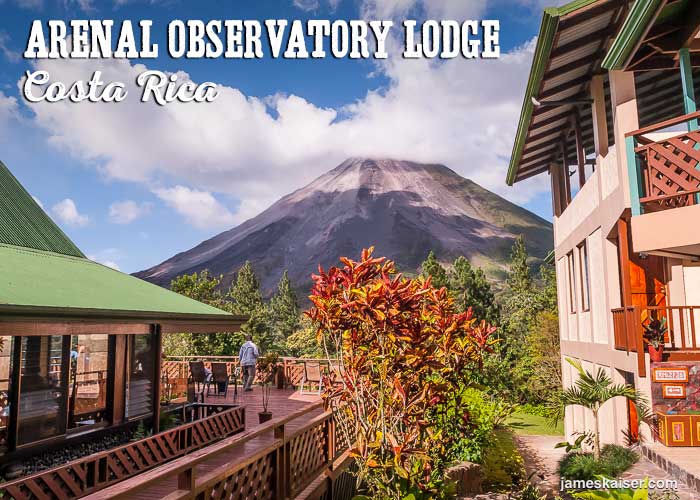
Arenal Observatory Lodge
Another great place to check out is the Arenal Observatory Lodge . This private lodge—the only hotel located inside the park—was originally built in 1987 as a Smithsonian Institute scientific research station. It has since been converted into an upscale hotel.
Perched safely on a bluff just 2.7 kms (1.7 miles) south of the volcano, it offers stunning views of Arenal. There’s a small museum and over 10 km (6.2 miles) of hiking trails, including a trail to a lovely waterfall and a trail to the top of Cerro Chato. Non-guests can enjoy the hotel’s museum and trails for $8 per person. The lodge is about a 10-minute drive past the park entrance.
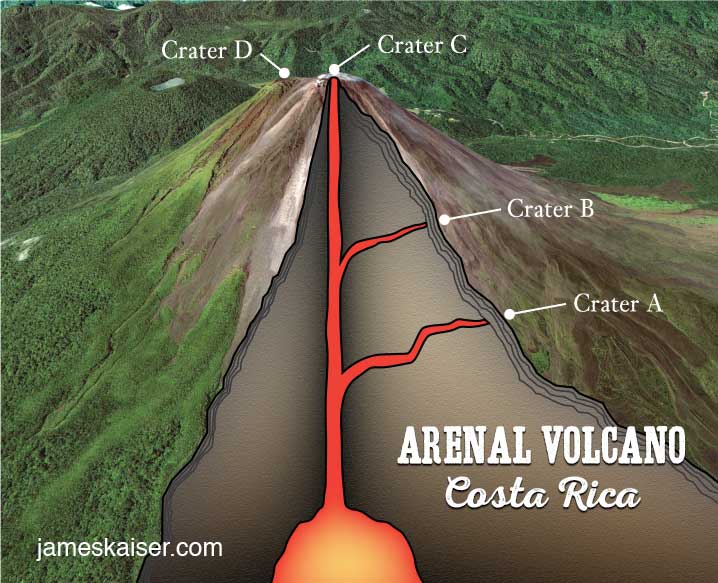
Arenal Volcano Geology
Although the exact details of Arenal’s inner workings remain a mystery, the volcano is the result of tectonic plate movement.
As the Cocos Plate (located off the Pacific Coast) collides with the Caribbean Plate (which includes Costa Rica), underground rocks melt and rise into a magma chamber below Arenal. When pressure on the magma becomes too great, the volcano erupts.
Arenal Volcano is roughly 7,000 years old. It has erupted multiple times, and eruptions seem to follow a somewhat predictable cycle. Small eruptions occur every 300–400 years and large eruptions occur every 600–800 years.
No wonder Costa Rica’s indigenous Malekus tribe believed the god of fire lived inside the volcano. The Spanish name Arenal (“sand pit”) is derived from the sandy deposits left by volcanic debris.
On July 29, 1968, Arenal erupted after lying dormant for roughly 450 years.
At 7:30am an enormous crater (Crater A) blasted open halfway up the volcano’s western flank, resulting in a “pyroclastic flow.” Giant rocks whizzed through the air at 500 meters (1,640 feet) per second, and a molten ash cloud raced down the slopes at 150 kilometers (93 miles) per hour. The ash cloud, which reached temperatures up to 1,000˚C (1,832˚F), vaporized everything in its path, including trees, houses and people. Rocks ejected from the volcano landed up to 5 kilometers (3.4 miles) away and left impact craters up to 25 meters (82 feet) in diameter.
Over the next three days Arenal continued to erupt. Two additional craters (B and C) blasted open on the volcano’s western flank, and vast quantities of ash and rocks rained down over the region. By the time the volcano settled down, Arenal had destroyed…
Continued in Costa Rica: The Complete Guide
Arenal Volcano Photos
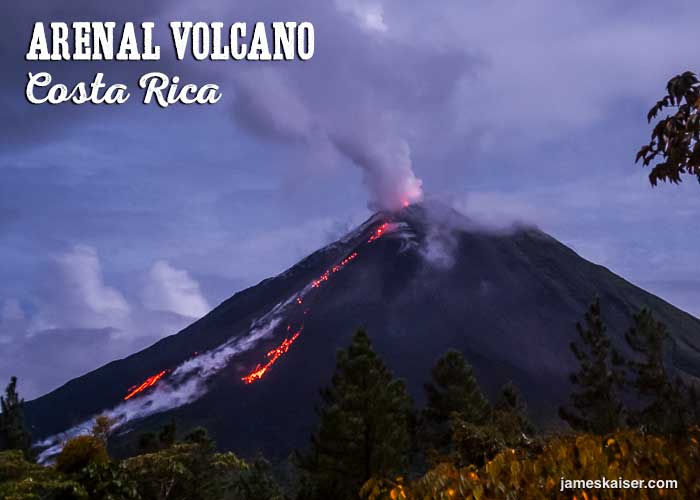
Arenal Volcano erupting in 2008. Glowing hot rocks launched out of the cone and tumbled down the charred slopes.
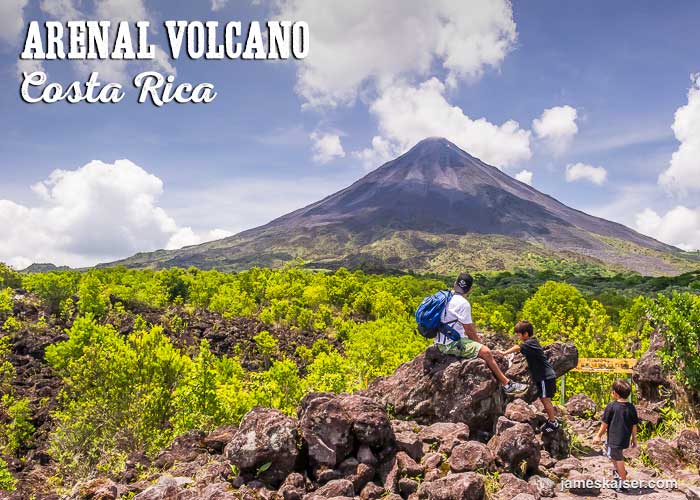
Viewing the western flank of Arenal from the remnants of the 1968 lava flow.
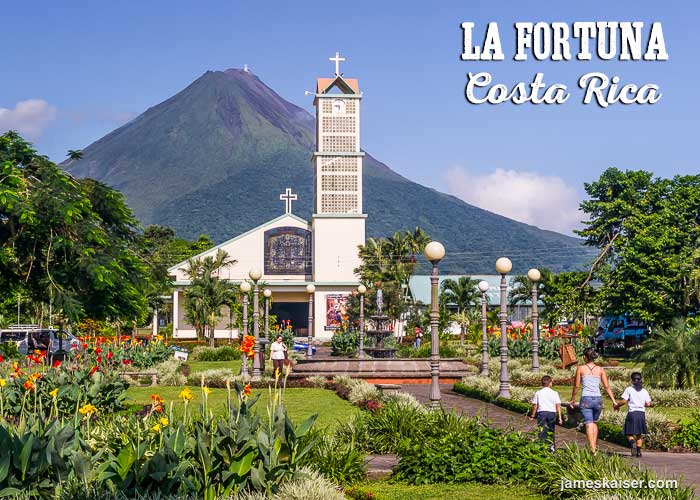
Arenal Volcano viewed from downtown La Fortuna, Costa Rica.
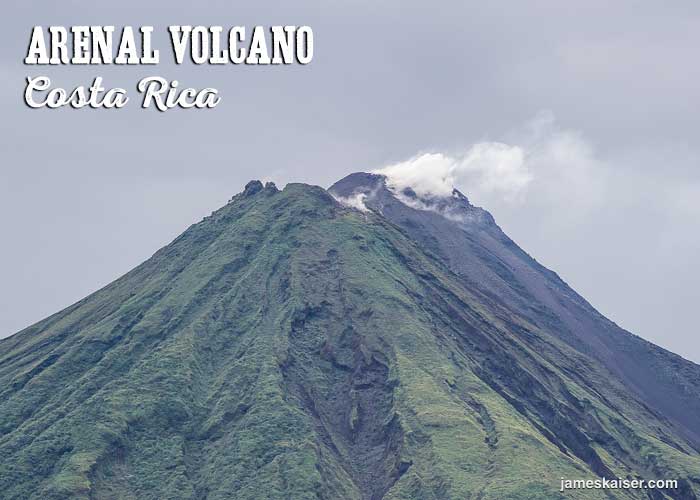
The peak of Arenal Volcano is actually two peaks: an ancient cinder cone (front) that formed prior to 1968, and a newer, taller cinder cone (rear) that formed between 1968 and 2010.
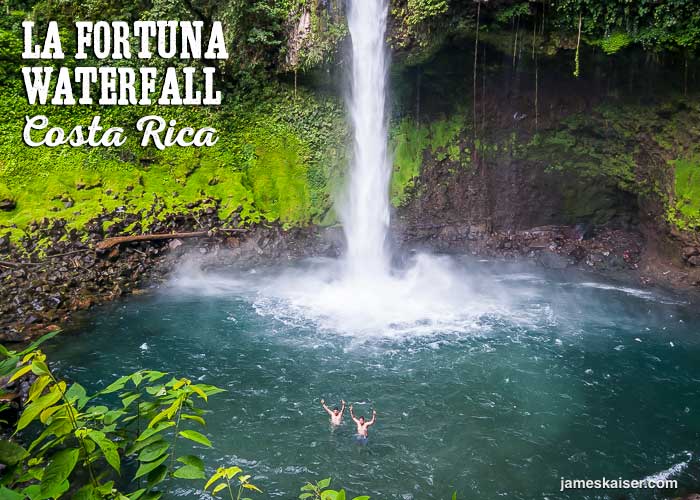
La Fortuna Waterfall – one of the most beautiful waterfalls in Costa Rica – is located southeast of Arenal Volcano.
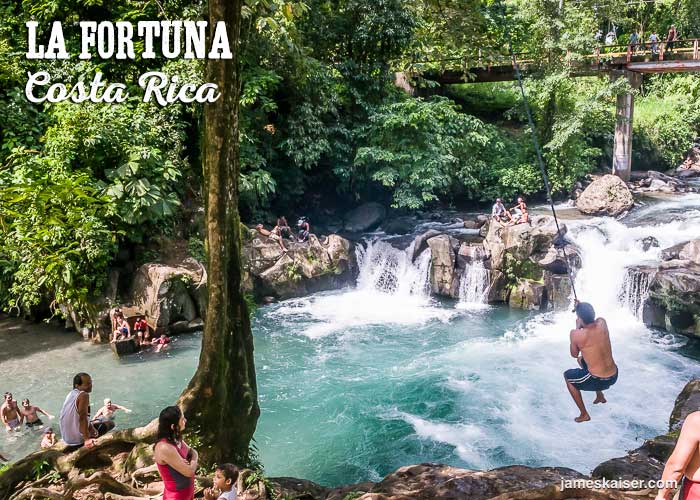
A gorgeous swimming area located just downstream of La Fortuna Waterfall.
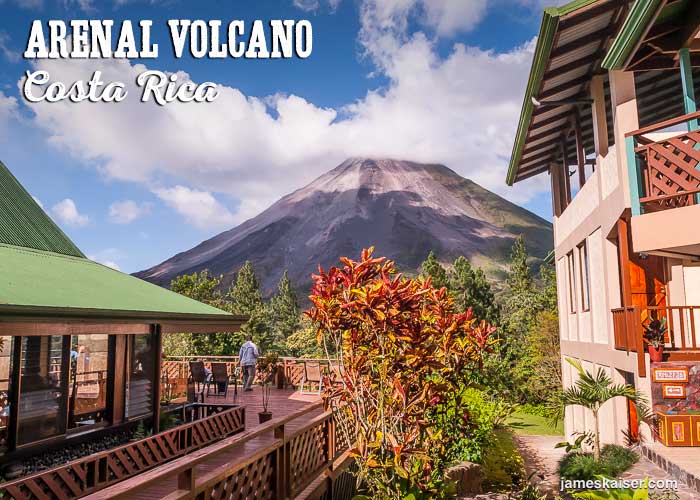
The southern flank of Arenal Volcano, viewed from the Arenal Observatory Lodge .
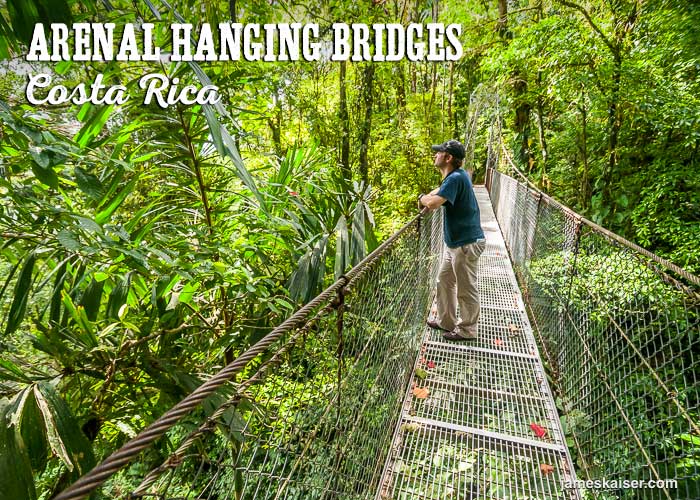
Exploring the lush rainforest surrounding Arenal Volcano from a suspension bridge at Arenal Hanging Bridges.
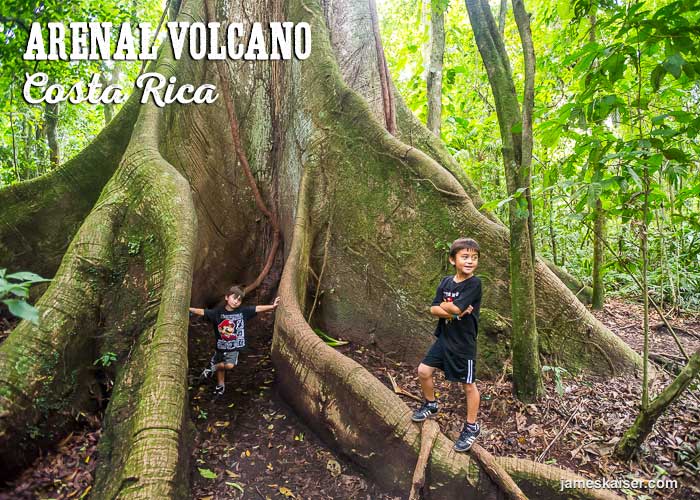
Kids explore giant trees in the rainforest near Arenal Volcano.
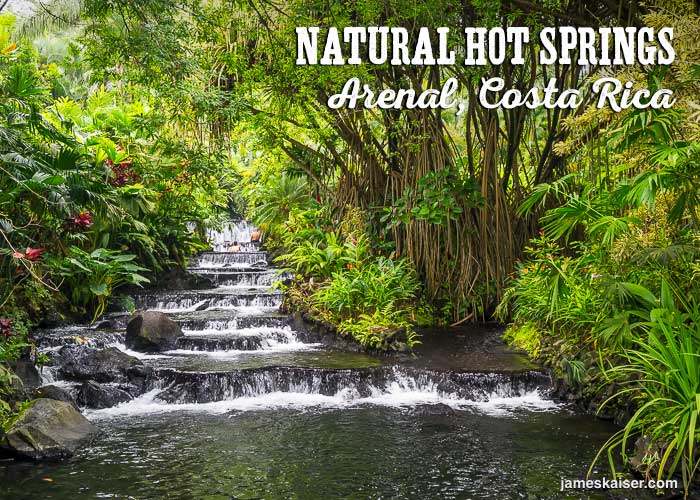
Over half a dozen natural hot springs are scattered around the base of Arenal Volcano.

Costa Rica Guide
Travel information and maps, volcanoes in costa rica.

Arenal, Poás (partially re-opened), Turrialba, Chato, Tenorio (re-opened!), Miravalles (re-opened!), Rincón, Von Seebach, and Santa Maria Volcanoes have all been impacted by increases or decreases in volcanic activity, weather, earthquakes and even bureaucracy.
Volcano Live Cameras
On the positive side the increase in gas venting, rock and ash ejection and even lava activity closing visitor centers, access roads and hiking trails also creates a dramatic backdrop for nearby attractions that remain open . There are also a few volcanoes where access remains unaffected ( see below ).
Volcano Closures in Costa Rica
Tenorio Volcano & Rio Celeste Re-Opened January 2018 – Tenorio National park and most notably the trail to the Celeste Waterfall were closed briefly on January 12, 2018 after a “swarm” of seismic events (several small localized earthquakes within a few hours).
During the shakeup the famous waterfall turned a muddy brown and there was online hysteria predicting the attraction was forever altered but it seemed more likely to us that it was just mud from small quake triggered upstream landslides.
The park re-opened two days later and the river and Celeste waterfall regained their eponymous coloration.
Chato – OFF LIMITS through at least 2020 – Cerro Chato has been inactive for thousands of years. The clear cold lake in the bottom of the crater and the spectacular views of Arenal a mere mile north from the rim made this the most popular volcano hike in Costa Rica. Unfortunately the trail was declared off limits in February of 2017 because guides were using it to stage climbs up the back side of Arenal.
We’ve been told that there is insufficient manpower to enforce the Lago Chato closure. Only the official guided hikes are being cancelled and many people are ignoring the ban and hiking anyway.
Miravalles – Re-Opened May 2017 – the trails from the outskirts of Bijagua to the waterfalls in Miravalles National Park were wiped out by Hurricane Otto in November 2016 but have been re-built and are open as of May 2017 – Yipee!

The visitor’s center/museum, cafe, gift shop and trails through the cloud forest and to Laguna Botos remain closed but visitors are now allowed to walk up to the crater overlook accompanied by guides .
Note – Poás closed to visitors due to high levels of activity sporadically in 2019 ( see details ) and will probably close without advance notice a few times in 2020. Turrialba – UPDATE: November 2020 – SINAC announced the re-opening of the viewpoints and overlook trail at Turrialba Volcano National Park as of December 3, 2020!!!.
UPDATE: February 2020 – SINAC announced the possibility of resuming official tours into the Turrialba national park. The outline calls for 4 groups of 35 visitors each day participating in a two hour hike accompanied by trained guides. The required infrastructure and trails are ready but local landowners are blocking access claiming the road to the park is private. The matter is being litigated and there is no estimate when tours might be able to commence.
UPDATE: October 2018 – The National Seismological Network has released dramatic video (see below) of new eruptions. Wait for it…10 seconds…
CLOSED – the most extensive and beautiful network of volcano trails in Costa Rica shut down temporarily in 2012 and completely in 2015 due to dangerous levels of activity in two of the craters. The road to the rim is also closed to the public.
Earlier in the summer a drone confirmed what residents have been reporting – a lake of lava more than 150 feet across has formed in the west crater of Turrialba volcano. Locals have noted an orange glow reflecting off of nighttime clouds for several weeks. The surfacing magma ensures that the peak and crater trails will remain closed but some are hoping to draw tourists to the surrounding area for lava viewing.
Rincón de la Vieja, Von Seebach, Santa Maria – OFF LIMITS 2014 – Starting sporadically in 2014 all three trails (north from Las Pailas, west from Santa Maria and south from Dos Rios) to all three craters were closed due to increased levels of activity in Rincón . Although the it’s been relatively quiet through 2018 the trails to the peaks are now closed permanently.
Arenal – DORMANT 2011 to 2020 – Arenal quit spewing lava in 2011 and although the beautiful cone still dominates the landscape there are currently no spectacular eruptions.
UPDATE: October 2018 – It’s dangerous and illegal to climb Arenal – most recently four tourists were hospitalized (one with a serious compound fracture of the femur) when they were injured in an ash, lava rock and boulder slide while attempting to summit Arenal. A team of rescuers took two days to evacuate the climbers.
Please do not be a moron. The zone around the crater is off-limits because of unstable slopes, poison gases and because it’s really expensive to rescue idiots who ignore the closure.
SJO Juan Santamaría International Airport – INTERMITTENT CLOSURES – Increased activity at Turrialba has shut down Costa Rica’s main airport a few times for a couple of hours to a couple of days. Poás is even closer but so far the ash fall has been carried away from the airport by prevailing winds.
NOTE: the status of trails and other amenities is subject to change without notice – use the directory of Costa Rican National Parks to contact the local offices for updates.
Where to Visit Volcanoes in Costa Rica Now
Drive up crater.
At times Costa Rica has had three drive up volcanoes. Currently Poás and Irazú are open.
Visits to Irazú tripled in 2017 after the closure of Poás and Turrialba. Although the colossus dominates the eastern skyline and appears close enough to touch from downtown San José it takes over an hour and a half to wind up the paved road past the famous cathedral and ruins in Cartago, bucolic hills, and finally elfin cloud forest before reaching Irazú’s summit.

Crater Lake Hikes
If you want to hike right up to a crater lake there are still a couple of trails open to Lago Barva (in Braulio Carrillo near San José) and Lago Danta (near Tenorio ). It was frequently warm and sunny at Lago Chato where a refreshing swim in the crater lake was de rigueur after the long hot climb.
Both Barva and Danta are at significantly higher elevations than Cerro Chato, much colder and surrounded by cloud forests rarely penetrated by the sun so swimming is not popular.
Directions and map to the Barva Volcano trail in Braulio Carillo National Park

Tenorio Volcano National Park has always been one of our favorites. Access to the top has always been limited and less than 1 in 5,000 visitors ever made the difficult climb preferring to hike to the amazing Celeste Waterfall and hot springs of the lower slopes instead.

After a quick visit to the reopened crater there are other attractions on the slopes of Poás volcano. La Paz Waterfall Gardens, and the Doka and Britt Coffee plantations are open and considered premier attractions from San José and the central valley. A slight detour (and possibly some 4WD) to the east puts visitors on the trail head to the crater of Barva Volcano in Braulio Carrillo National Park .

Rincón de la Vieja
The closure of the trails to the triple summits of Rincón, Seebach and Santa Maria will probably go unnoticed by the vast majority of visitors most of whom would never attempt the long, steep and extremely challenging climb if it were open.
The closure has not impacted the trails to the waterfalls, back country hot springs and the nature walk around the geysers and boiling mud pots which all remain open. Additionally, the slot canyon white water tubing, ziplines, spas and other attractions outside the park are still some of the most popular day trips from the Guanacaste beaches .

Although the spectacular night time displays stopped years ago, Arenal volcano still puts out enough heat to warm the hot springs and the region still attracts tourists with zip-lines, rafting and other adventure activities.
The Poás Closure History:
In April of 2017 the national park was evacuated and closed indefinitely when the cooled lava dome in the crater collapsed and sent ash and rocks into the air during a period of higher than normal activity. The volcano activity has since decreased back to typical levels and a number of visitor safety features were added in order to partially re-open Poás National Park on August 31, 2018. Please see this link for ticket purchase instructions (required) and further information.
August 28, 2018 – SINAC (Sistema Nacional de Áreas de Conservación) quietly informed tour operators that the work is complete and the national park will re-open soon. President Carlos Alvarado will preside over an inauguration ceremony for the new facilities on Wednesday August 29th and the park will reopen to the public on Friday August 31, 2018.
The parking area, restrooms and overlook are re-opening. 50 visitors at a time will be permitted a total of 20 minutes at the rim accompanied by guides trained in safety measures.
July 24, 2018 – The “last week of July” re-opening is cancelled and SINAC (Sistema Nacional de Áreas de Conservación) has not provided a new official estimate.
For the past year we’ve received several e-mails a day asking us when the park will actually re-open but we do not know. When we’re coerced into making a wild guess we have been saying “if there are no more eruptions it’s possible Poas will re-open by early December 2018 when high season starts.”
June 2, 2018 – The SINAC (Sistema Nacional de Áreas de Conservación) June 1 estimate for reopening has passed and the new official estimate for partial re-opening is the last week of July 2018 and access to the full trail system by sometime in 2019 at the earliest. Construction on the shelters began last Monday and SINAC officials met again with Instituto Costarricense de Turismo (ICT), Ministerio de Ambiente y Energía (MINAE), Comisión Nacional de Emergencia (CNE), and Comité pro Apertura del Volcán Poás (CAVP) last week to begin the process of purchasing the required real time noxious gas monitors. April 28, 2018 – SINAC (Sistema Nacional de Áreas de Conservación) representatives stated that cleanup, some shelters and trail improvements are completed (see complete list of re-opening requirements below) and that hiring of guides and training (expected to take about a month) has begun. The new official estimate for partial re-opening is June and the trails and amenities are all expected to be open by the end of 2018.
March 18, 2018 – SINAC (Sistema Nacional de Áreas de Conservación) representatives stated unequivocally that Poás will not open by Easter as rumored. The requirements and conditions announced on March 3, 2018 for the possible re-opening the National Park have not yet been implemented. The new official estimate is May or June.
- creation and implementation of an obligatory advanced reservation system that limits visitors numbers to 50 at a time restricted to 20 minutes at the volcano rim and 45 minutes total inside the park
- design and construction of “volcano shelters” to protect tourists in case of an unexpected eruption
- installation of gas sensors in all accessible areas
- repair the existing buildings and infrastructure that were damaged in the April 2017 eruption
- hire and train new staff
UPDATE January 26, 2018 The National Seismology Network has determined that the current mechanism of degasification makes it unlikely that there will be premonitory earthquakes which previously gave warning of impending eruptions.
According to Lidier Esquivel at the National Emergency Commission the lack of seismological indicators means the park could not be evacuated in time and is the reason the park remains closed. Turrialba volcano national park was closed for similar reasons six years ago and has not reopened.
December 26, 2017 – The local community petition to reopen Poás was rejected and the park remains closed until further notice.
October 23, 2017 the local communities petitioned to reopen the park because the volcano has been relatively quiet for several months. A decision is pending but I would be surprised if the petition is granted before 2018
July 4, 2017 – Recent evidence of lava ejections from the “Boca Roja” (Red Mouth) crater at Poás volcano mean the temporary closure of the national park, museum and visitor’s center will continue indefinitely. When Arenal started spewing lava access was prohibited for 50 years.
June 6 2017 – Another ash and steam eruption ensured that the park will remain closed so the best view you can get is from the OVSICORI live crater camera .
- Costa Rica Travel
Volcanoes of Costa Rica
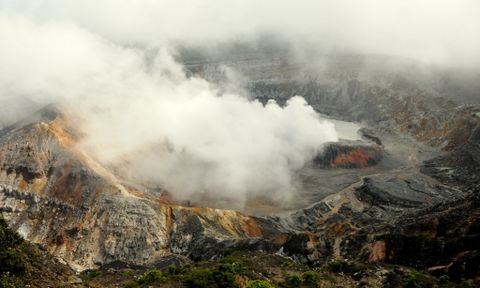
Explore these attractions in Costa Rica is very safe, find here an great article about Costa Rica safety.
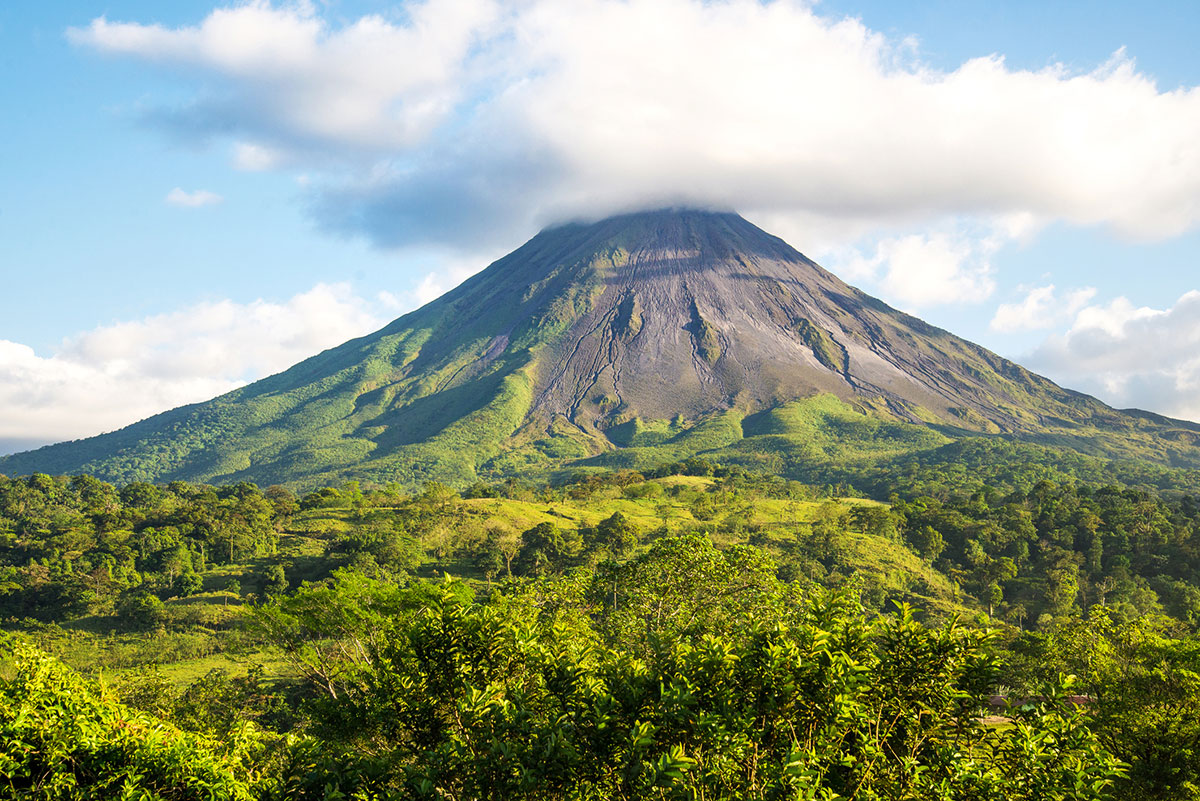
“That’s one hot adventure! Which Costa Rica volcano can you handle?”
Whether you want to rev up your adrenaline, or enjoy a scenic hike near a sleeping giant, there’s a Costa Rica volcano that will offer you just the right amount of adventure and exercise. Walk around nature and take in the fresh air whilst you enjoy amazing views, and get a peek at the country’s wildlife in their natural environment.
The following list recognizes Costa Rica’s most notable volcanoes.

- The terrain can be rugged, so leave the driving to the professionals.
- A volcanic adventure is the first of many exciting Costa Rica tours .
- Take a soak in one of Costa Rica’s many volcanically heated hot springs .
Poás Volcano
The Poás Volcano National Park is located in the Central Highlands of Costa Rica. Rising up to 8,885 ft (2,708 m), Poás remains one of Costa Rica’s largest and most active volcanoes. At almost a mile in diameter (1.6 km), the crater’s rain-fed, sulfuric pool bubbles and emits smoke. Although the last major eruption was in 1910, the volcano remains steadily active to this day, and visitors can still see geysers exploding into the air — some reaching as high up as 820 ft (250 m).
Located 1.5 hours from San José, Poás is a popular day trip for travelers staying in the country’s capital. The 68-mile (108 km) round-trip journey navigates along coffee and flower farms, many of which line areas of the park. The best time to visit is during the morning hours from January to April. Weekends are usually crowded and clouds normally roll in around mid-afternoon, making it difficult to enjoy the scenery. On a clear day, however, it’s possible to see both the Pacific and Atlantic coasts from the summit, as well as its gurgling, steaming crater.
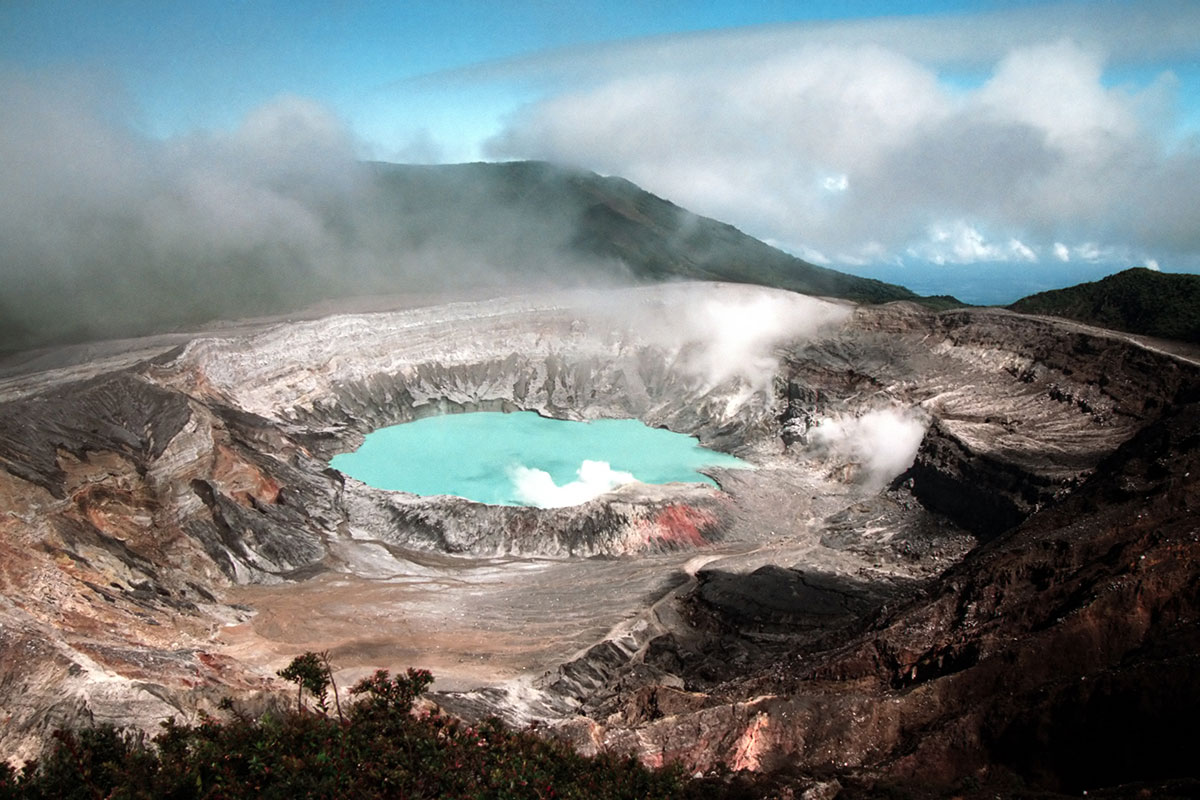
Rincón de la Vieja Volcano
The Rincón de la Vieja Volcano is located in the Guanacaste region of Costa Rica. Rincón de La Vieja is a cinder cone volcano in Costa Rica, and is part of nine contiguous craters that dot the Rincón de La Vieja National Park. This collection of volcanic peaks is most active in the Guanacaste Mountains, where major volcanic activity occurred during the latter half of the 1960s. The Von Seebach crater is currently active, venting steam and the occasional volcanic hiccup on a regular basis. Of the nine craters, the Santa Maria Volcano is the highest, topping out at 6,385 ft (1916 m).
The hike to the top of this crater is not easy — it’s a 6-mile (10 km) hike that ascends over 5,000 vertical feet. The hike primarily winds through tropical forest before giving way to dwarf cloud forests near the top. This final section — measuring some 2 km in length — is the steepest and most difficult portion of the climb. However, getting to the top of this volcano and staring down at the surrounding countryside is definitely worth the effort.

Irazú Volcano
The Irazú Volcano is located in the Central Highlands of Costa Rica. It is the tallest volcano in the country, reaching upwards of 11,260 ft (3,432 m), and has several active craters. The largest of these craters is 900 ft (275 m) deep, while the smallest crater, dubbed Diego de la Haya, dips some 300 ft (91 m) beneath the surface. Its mineral-rich lake can transform color, often fluctuating between emerald green and crimson red. On a clear day, the Pacific and Caribbean coasts are visible from the summit.
The Irazú Volcano National Park is set on 5,705 acres (2,300 ha) of immaculate montane forest, most of which is comprised of primary, secondary, and cloud forest. From San José, you can head east 14 miles (23 km) to the nation’s former capital, Cartago. From here, it’s 24 miles (39 km) to the Irazú Volcano National Park. The roads are in good condition and signs mark the route in.

Tenorio Volcano
The Tenorio Volcano and Miravalles Protected Zone is located in the Guanacaste region of Costa Rica. The smooth cinder cone of Tenorio rises from its surrounding forest, achieving a maximum height of 6,286 ft (1,916 m). The area surrounding this Costa Rica volcano is characterized by an enchanting blend of forest, hot springs, and geysers. Virgin forests extend to Tenorio’s summit and line the banks of a lake that fills the volcano’s crater. The summit can be accessed via the Lago las Dantas Trail, which winds its way up from the park’s base and through the cloud forest before arriving at the top.

Turrialba Volcano
The Turrialba Volcano National Park is located in the Central Highlands of Costa Rica along the southeast corner of the Central Volcanic Corridor. The summit peaks out at 10,919 ft (3,328 m), and on clear days the view includes the Atlantic coast and the Barva, Poás, and Irazú volcanoes.
Turrialba’s last major eruptions occurred in 1866. However, fumarolic activity (smoke and gas which often includes carbon dioxide, sulfur dioxide, hydrochloric acid, and hydrogen sulfide) remains constant from the highest peak. There are three well-defined craters located at the top, the most profound of which measures 164 ft (50 m) in diameter.

Book one of Costa Rica’s hottest adventures.
It’s not everyday you get to say you explored a Costa Rica volcano, so why would you miss this opportunity? Rugged excursions, warm hot springs, and colourful wildlife are waiting for you! Choose your preferred level of excitement, and add adventure to your travel itinerary.

Have questions about safely booking your volcanic adventure? Reach out to us toll-free at +1 866-454-0889 or send a message to our locally-based travel consultants .
Tailored, Trusted, and Transformative Travel Experiences

Customer Reviewed Anywhere.com was very helpful and responsive. From La Paz Waterfall to Drake Bay, they helped us refine our plans and made the best out of this memorable vacation.
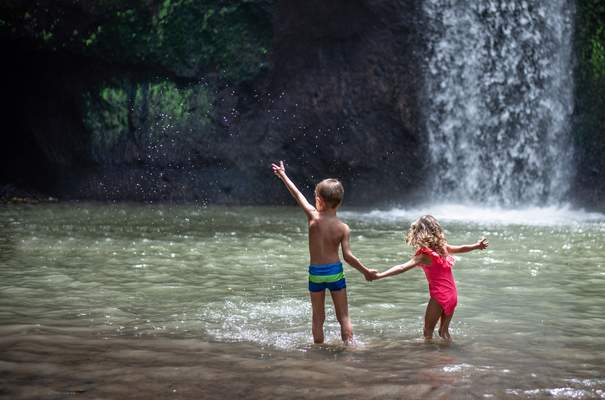
Expert Choice Climbing famous volcanoes, swimming in waterfalls. Walking through cloud forests, and soaking up the sun on beaches. This vacation: see it all, do it all, have it all.
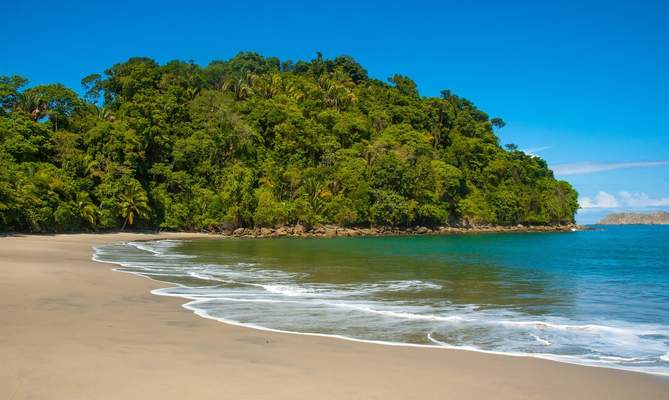
Customer Reviewed Great. What a beautiful country. Very impressive on how clean it is and the way of life.
- Skip to primary navigation
- Skip to main content
- Skip to primary sidebar
- Skip to footer

Costa Rica Travel Information
Costa Rica 11 Days Itinerary: Rainforest, Volcano, Cloud Forest & Beach
April 14, 2024 By Sammi 8 Comments
Experience the best of Costa Rica in this 11 day Costa Rica itinerary! Visit La Fortuna for rainforest and volcano, Monteverde for cloud forest and Manuel Antonio for beach. This Costa Rica 11 day itinerary offers plenty of adventure, relaxation and fun. You’ll experience three of the most popular tourist destinations so this itinerary is ideal for first time visitors.
You can use this exact itinerary or if you have more/less days, I’ll tell you how to adjust it. Also included are hotel and restaurant recommendations and ideas for excursions and tours.
There are affiliate links in this post.
Costa Rica 11 Day Itinerary Details
This itinerary includes your travel days and flying in and out days. If your flight lands very late on your first day, you should stay a night by the airport and then depart the next morning for La Fortuna. Likewise, if your flight is super early on Day 11, you should travel back to San Jose and stay the night near the airport on Day 10.
It gets dark by 6 PM everyday in Costa Rica and we do not recommend driving long routes at night (2+ hours), especially in rainy season.
You will fly in and out of San Jose International Airport. This is the closest international airport for your destinations.
Costa Rica 11 Day Itinerary Transportation
Transportation: This itinerary requires you to rent a car for the most flexibility and to maximize your time in Costa Rica. A high clearance car is required for this specific itinerary in the dry season. If you are visiting in rainy season and have a more adventurous spirit, a 4wd is required. Get our Costa Rica car rental discount and freebies here .
If you don’t want to drive, then book private shuttles. Private shuttles are ideal for groups, families with children/seniors, or those who are not on a strict budget but don’t want to drive. Learn more about shuttles in Costa Rica and request a quote .
You can take the public bus but I don’t recommend it as there aren’t direct routes or frequent schedules. It’s cheap but I don’t suggest it if you’re traveling with infants or seniors with mobility issues. I recommend driving or private shuttles in that case.
Shared shuttles are great for those more on a budget or are solo travelers. The downside to shared shuttles is that they have limited schedules. Many routes have only 1 shuttle in the morning, 1 shuttle in the afternoon. Some routes have just 1 shuttle a day. Additionally, they only pick up/drop off at certain hotels, no Airbnbs, no rentals and no hotels outside their route.
How to Adjust This Costa Rica 11 Days Itinerary
If you have less nights.
Remove one night (or two) from Manuel Antonio since this itinerary has 5 nights in Manuel Antonio.
If you have 9 nights, you can do 3 nights La Fortuna, 3 nights Monteverde and 3 nights Manuel Antonio to get a well rounded experience of each place.
For 7 nights, then I recommend 2 nights in La Fortuna, 2 nights in Monteverde and 3 nights in Manuel Antonio.
If you have more nights
To easily turn it into a full 2 week trip, add a night in La Fortuna and a night in Monteverde.
If you want to visit another destination, then I recommend 2 nights in Jaco after Monteverde. Jaco is 1 hour north of Manuel Antonio and a fun, party surf town. However, if you prefer not to stay in big beach town, Hotel Villa Caletas is a beautiful romantic hotel with gorgeous views and luxury rooms, 1.5 hours north of Manuel Antonio. If you’re a birder, Hotel Villa Lapas is a great option, close to Carara National Park .
Day 1: Fly Into SJO, Travel to La Fortuna (~3 Hours Drive)
Welcome to Costa Rica! After you go through immigration and customs , you will then travel onto your first destination in this Costa Rica 11 days itinerary: La Fortuna . This town is the main tourism hub near Arenal Volcano and boasts plenty of nature, wildlife, adventure, culture and relaxation activities.
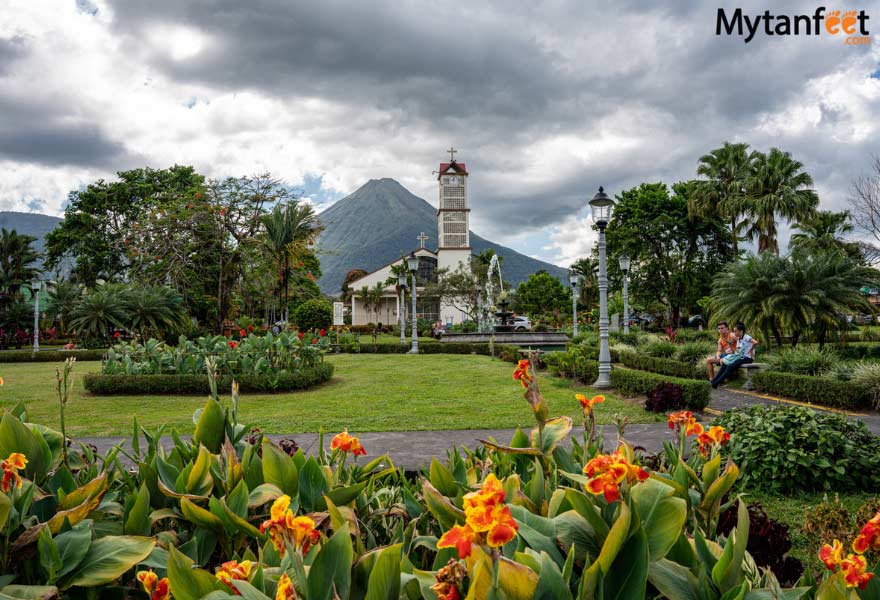
Driving: Pick up your rental car and then drive 3 hours to La Fortuna. If your flight lands after 4 PM, we recommend to stay a night by the airport and then leave for Fortuna next morning so you can drive in the daylight. Read more about the drive from San Jose to La Fortuna !
Shared shuttle: Most shared shuttles have one AM and one PM schedule. You will need to meet your shared shuttle at the Denny’s Restaurant or Fiesta Casino a couple miles away (you can call an Uber from the airport or take the airport taxi) If you cannot catch either of their schedules, then you will need to stay a night in San Jose or book a private shuttle. Here is our list of recommended hotels near SJO Airport.
Private shuttle: Your driver will wait for you directly outside the airport terminal exit to pick you up and take you to La Fortuna straight away. Your service includes a stop along the way for food/bathroom/shopping, etc. Contact us to book your private shuttle!
La Fortuna Hotels
There are many hotels and vacation rentals to choose from in La Fortuna. Here are some of our picks.
- Luxury: Amor Arenal adult only , Royal Corin , The Springs Resort & Spa , Tabacon , Nayara Gardens , Nayara Springs Adult Only , Nayara Tented Camp , Kioro
- Mid range: Los Lagos , Kokoro Volcano View , Volcano Lodge & Springs , Arenal Manoa , Arenal Springs Resort , Magic Mountain , Tifakara Lodge
- Budget / Solo traveler: El Secreto Fortuna , Selina Fortuna , Hotel Las Colinas , Arenal Xilopalo , La Choza Inn
- Nature Lover: Arenal Observatory Lodge , Arenal Oasis Eco Lodge
Nearly all hotels include a hot breakfast except hostels and super cheap hotels. You can read our guide on “ Where to Stay in La Fortuna ” for more options and details.
Day 2: La Fortuna (Sloth Trail + Chocolate & Coffee Tour)
In case you don’t have a car and need to book tours with transportation included, we offer small discounts for La Fortuna tours here.
In the morning, you’ll do an easy sloths and bird watching tour. Give yourself about 2.5 hours for this guided walk and then head into town for lunch. Lunch recommendations: Rainforest Cafe or Soda Garra Pata.
After lunch, grab a coffee, ice cream or dessert at Chocolate Fusion to relax, people watch and sit in the town square. If you’re lucky, the cloud may clear up a bit and you can see the classic La Fortuna town scenery with Arenal Volcano in the backdrop of the local church.
Then head to Northfields to do their fun chocolate and coffee tour. They have presentations at 2 and 3 PM in the afternoon. You’ll learn about the history and importance of cacao and coffee in Costa Rica, how to process it and the best part – sample it!
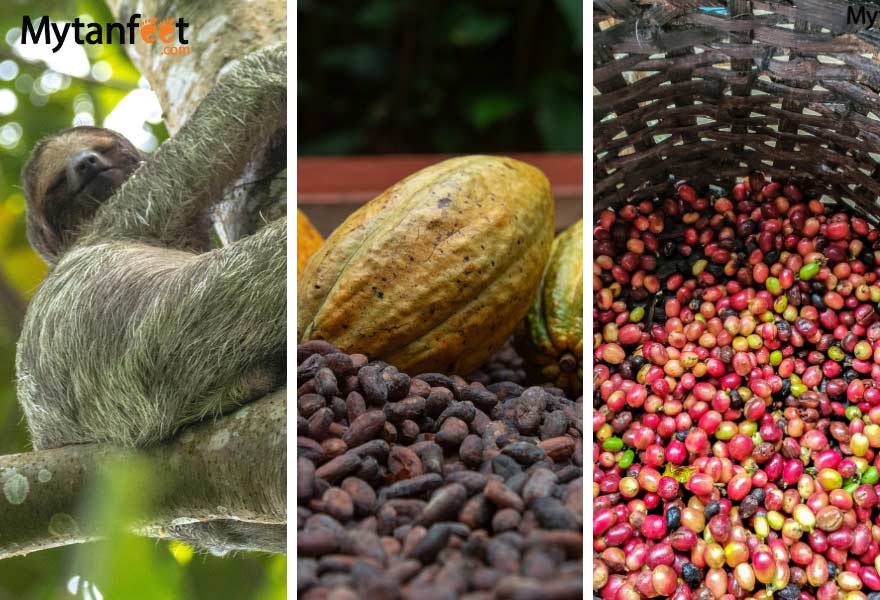
After the 2.5 hour presentation, head back to your hotel to nap and rest. You’ll finish the day at the hot springs. If your hotel doesn’t have their own hot springs, Paradise, Ecotermales, Tabacon, The Springs and Baldi are the most popular ones. You can also get dinner at the hot spring resorts.
For a romantic experience, Tabacon and The Springs are the best hot spring resorts for couples. We offer a $5 USD discount for The Springs 2 day hot springs pass. They are our favorite hot spring resort with a waterslide, swim up bars, river pools and more!
Day 3: La Fortuna (Arenal Volcano National Park and Lake Arenal Sunset Cruise
Today you’ll visit Arenal Volcano National Park to hike through the lava fields and the peninsula. There are two sections of the national park and you’ll visit both. The two sectors are about a five minute drive apart from one another. You will first do the volcano hike for close up views, and then go to the Lake Arenal sector.
A guide is not required to visit the national park. The trails are well marked and easy to follow to enjoy beautiful views of the volcano and Lake Arenal ! We recommend to go in the morning so start your hike at 8 AM and finish by around noon-1PM for both sectors. Make sure to have a good breakfast!
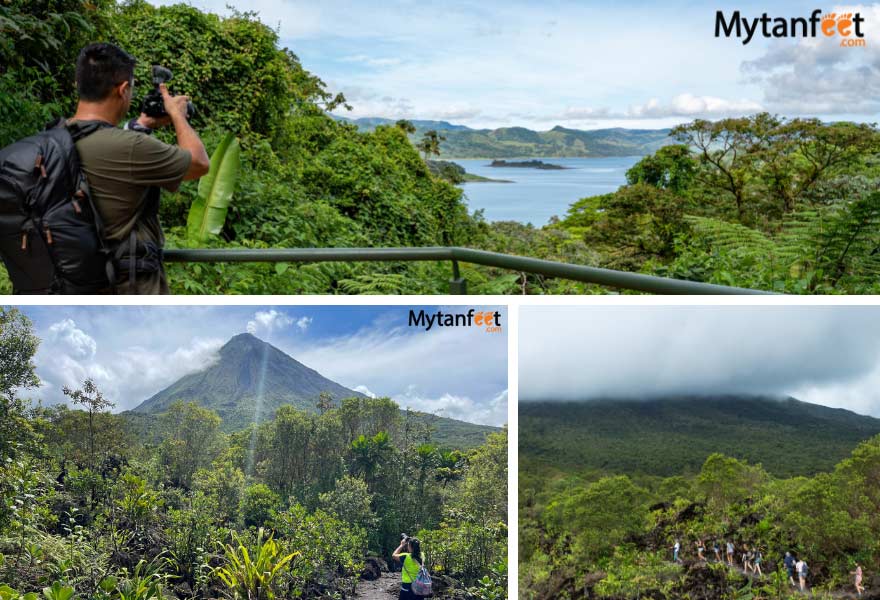
After the hike, have lunch on the way back to your hotel. Soda La Palma is a good local choice on Route 142 back to La Fortuna. We also like Cafeteria and Retaurante Rain Forest Arenal on Route 142.
Then in the afternoon, you’ll do a La Fortuna night walk to experience the tropical rainforest when the sun goes down. Get a discount off this tour here!
Dinner recommendations: Piura or Don Rufinos. For a lively night out, Lava Lounge.
More Things to Do in La Fortuna
If you’re interested in other activities, please check our things to do in La Fortuna and Arenal post for more ideas! We also have a discount for all the mentioned tours in La Fortuna which you can get in the link (lots of other tours offered).
Day 4: Travel to Monteverde (~3.5 Hr Drive)
Today you’ll travel to Monteverde , the town up in the tropical cloud forest. Sleep in and enjoy your last morning in La Fortuna. After you check out, fill up on gas and pick up some snacks and drinks. There are some gorgeous country views during the drive and you’ll want to go slow to enjoy them. You’ll also have to drive carefully as it’s an mostly unpaved windy road.
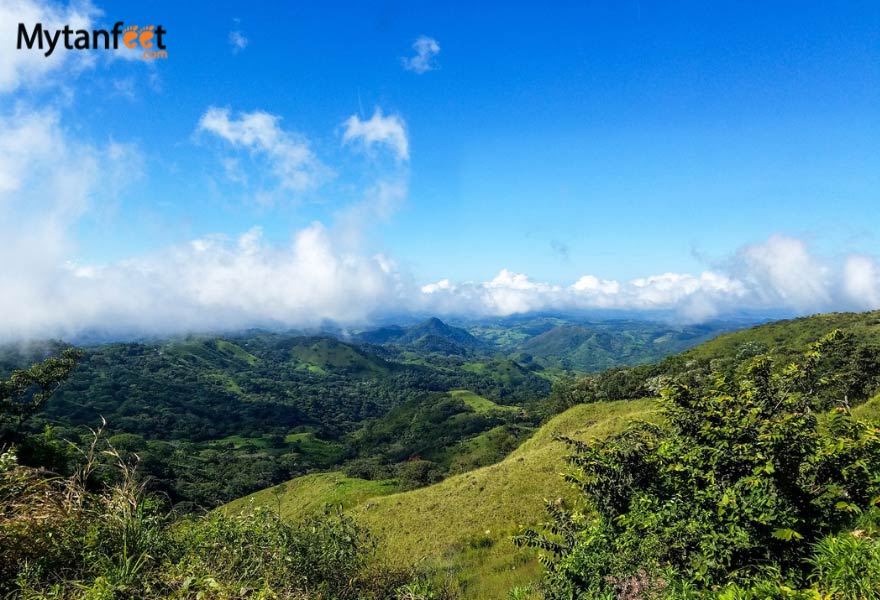
If the weather is good and you leave in the morning, you can stop by Viento Fresco Waterfall on the way. 4×4 access only and must be in decent condition to walk down steps.
You can get lunch along the way, there are several roadside restaurants. Restaurante Brisas del Lago is about halfway and very good.
If you’re not renting a car, we highly recommend taking the taxi-car-taxi across Lake Arenal. This service picks you up at your hotel in Fortuna, takes you to Lake Arenal to ride the boat across and then picks you up on the other side to take you to your hotel in Monteverde. Contact us to book this transfer!
Monteverde Hotel Recommendations
Most of the lodging in Monteverde consists of lodges, country inns, cabins, and boutique hotels. Tons of vacation rentals/Airbnbs.
- High end: Hotel Belmar , Senda , El Establo , Ocotea Boutique Hotel , Koora , Chira Glamping
- Mid range: Poco a Poco , Monteverde Country Lodge , Scala Monteverde , Monteverde Lodge & Gardens , Bella Vista Lodge Monteverde, Los Pinos Lodge and Gardens , Hotel Arco Iris . Use our 5% promo code “mytanfeet” to save $$ at the following hotels: Hotel Poco a Poco, Monteverde Country Lodge and Sibu Lodge. All wonderful places to stay in Monteverde with a great location, excellent restaurant and very cozy and comfortable rooms.
- Budget: Selina Monteverde , Monteverde Backpackers , Cabinas Vista Al Golfo
Day 5: Monteverde (Cloud Forest Hike)
Today you’ll visit the Monteverde Cloud Forest Biologlca Reserve in the morning for a hike. You can go on your own or book a tour with a guide. If you really love hiking and prefer to go at your own pace, we recommend to go on your own. You can purchase reserve tickets at the door and download their map. Plan for around 3 hours at the reserve and trails are well marked.
If you are a birder, we recommend a morning birdwatching tour at Curi Cancha Reserve instead. If you want to visit another cloud forest reserve that isn’t as busy as Monteverde, head to the Bosque Nuboso Santa Elena Reserva instead. That one is our favorite, it’s even higher in elevation, normally less people and feels even more tropical cloud foresty! You can do a self guided hike.
If you go to Monteverde Cloud Forest Reserve, have lunch at Stellas after your hike. You can also stop by the Colibri Cafe right outside the reserve. After a good lunch, visit a super cool spot very close to downtown Santa Elena, the Ficus Root Bridge . Great spot for photos!
Afterwards, you can head to your hotel to rest a bit and then head to the Mirador Valle Escondido Preserve to watch the sunset.
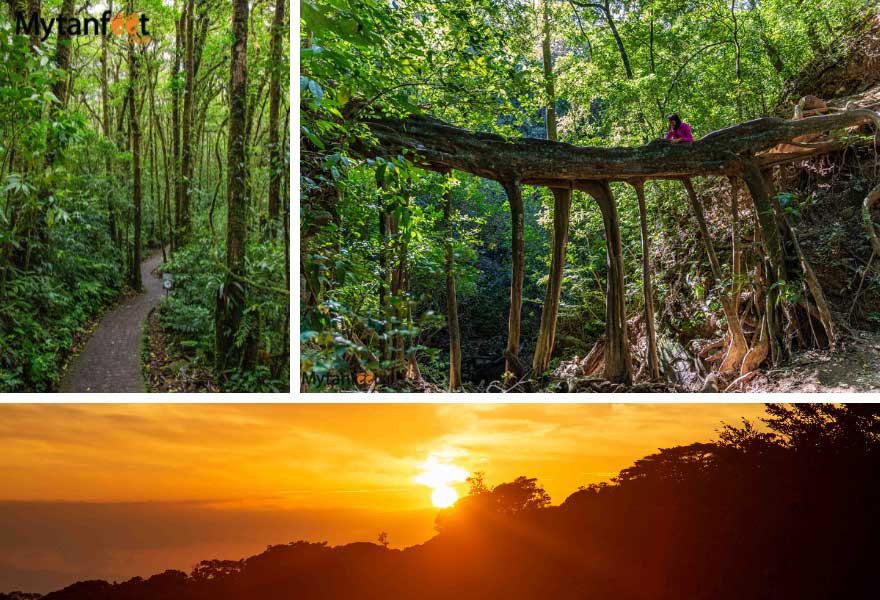
For dinner, we recommend Tramonti for Italian, Taco Taco or Restaurante Sabor Tico for local food. If you want to do something special for your last night in Monteverde, make a reservation at the San Lucas Treetop Dining Experience.
Day 6: Monteverde Ziplining + Hanging Bridges and Travel to Manuel Antonio (~4 Hour Drive)
Day 6 of your 11 day Costa Rica itinerary is a a very fun and busy day! You’ll do the hanging bridges and zipline tour at Selvatura Park . Afterwards, you will head straight to Manuel Antonio for beach time. Another option is Treetopia, which is right next to Selvatura Park that also offers hanging bridges and ziplining.
What’s the difference? The Treetopia zipline includes an 800 meter aerial tram to get to the start of the zipline. Selvatura Park has two optional Superman cables for more adrenaline and a sloth center, butterfly garden and reptile/amphibian exhibit you can add on.
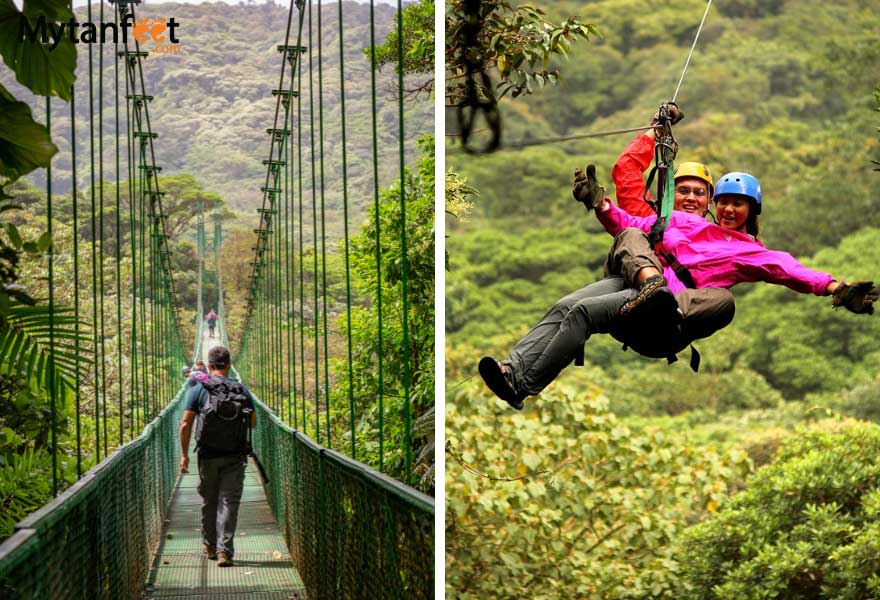
You have to start your activities at 830 AM to finish around noon. Have a quick lunch at the park’s restaurant and then plug in your GPS to your hotel in Manuel Antonio!
This drive takes around 3.5 hours and as soon as you get down the mountain from Monteverde, the drive is super easy on a highway all the way down to the south.
Make sure to stop at the Crocodile Bridge to see the giant crocodiles and you can get a snack at one of the roadside restaurants there. Then drive through Jaco to see the biggest beach town in Costa Rica. If you’re still hungry, there are a ton of food options in Jaco.
Manuel Antonio Hotels
There are a lot of hotels and vacation rentals in Manuel Antonio and this area is pricey. If you’re on a strict budget, find a hotel in Quepos or a hostel.
But if you want to splurge on a nice beach resort, Manuel Antonio is definitely the place to do it in Costa Rica!
- High end: Hotel La Mariposa , Tulemar , Shana By the Beach , Parador , Arenas del Mar , Si Como No , Issimo Suites Adults Only , Makanda By the Sea Adults only , Gaia Adults Only , Los Altos resort
- Mid range: Hotel Plaza Yara , Villas Lirio , Jungle Beach Hote l, Tico Tico Villas
- Funky: Igloo Beach Lodge (igloos), Hotel Costa Verde (hotel converted from a plane), El Faro Beach (containers)
- There are a handful of hostels like Hostel Manuel Antonio , Hostel Plinio , Hostel Pura Vida and Pura Vida Mini Hostel Manuel Antonio . Selina Manuel Antonio has private room options available. Wide Mouth Frog Hostel is in Quepos.
Day 7: Manuel Antonio Relax
Now you have 4 full days to enjoy Manuel Antonio, famous for its beautiful white sand beaches and lush rainforest.
Day 7 is your day to just relax. Do nothing. Lay by the pool. Nap. Sleep in. Read a book on the balcony. You can wander down to the beach or wander around town to check out the area. Get a massage, do yoga, meditate, recharge.
If you’d like to do something that day, we highly recommend a night walk to see creatures and critters of the night. Manuel Antonio is a fantastic place to see animals like frogs, snakes, insects, spiders and other nocturnal wildlife. Get a discount for the Manuel Antonio night walk here!
Day 8: Manuel Antonio National Park
On day 8 of your Costa Rica 11 days itinerary, you’ll visit Manuel Antonio National Park . We highly recommend hiring a naturalist guide. You can book a tour with transportation (get our Manuel Antonio tours discount here) or go on your own.
If you go on your own, make sure you purchase your park tickets online beforehand . If you are visiting in peak tourism season such as Christmas, New Years, Easter Week or your spring break, buy your park tickets at least 3-4 weeks before. As this national park sells a limited number of tickets a day and is the most popular park in the country, they sell out FAST during peak season.
If you drive, drive all the way to the park entrance and park in one of the lots in front of it. You can find a guide at the park entrance (ask for their ICT certification) and I recommend an hour guided walk. No car? Take the public bus that goes from Quepos to the beach every half an hour. You can also call an Uber.
Spend a good few hours at the park to swim, hike, relax, sunbathe, nap and enjoy one of the most beautiful national parks in the world! There is a cafeteria inside the national park for snacks and drinks as you cannot bring food inside the park or single use plastics.
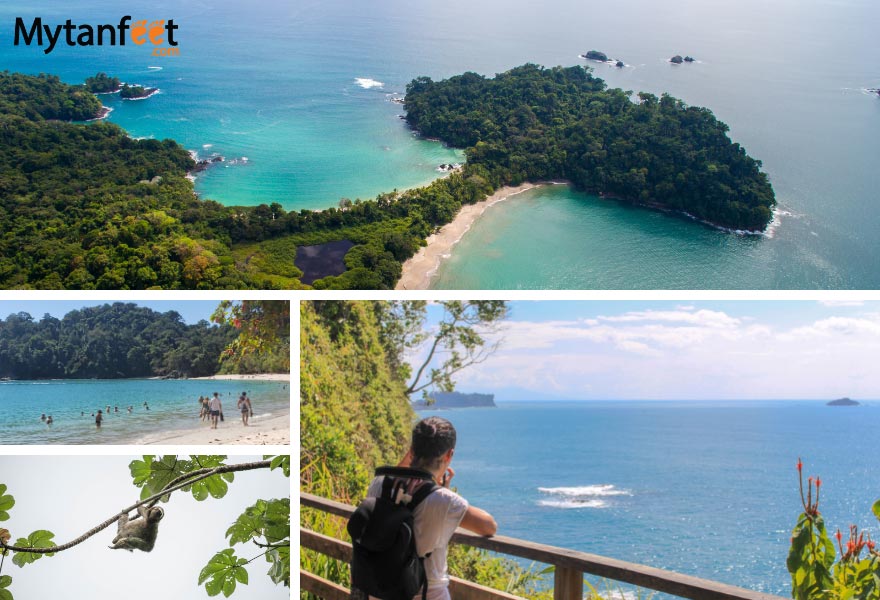
Important: once you leave the park, you cannot go back in so once you are done at the park and are hungry, you can visit one of the restaurants right outside such as El Chante del Parque (typical food). There are also many restaurants by the beach, a 5 minute walk away.
We also really like Rafaels Las Terrazas, Cafe Agua Azul and El Patio de Cafe Milagro up the hill (must drive). Those are great places for happy hour and to watch the sunset.
Day 9: Manuel Antonio (Los Campesinos Ecolodge)
On day 9, you’ll experience a bit of rural and local tourism with a visit to the Los Campesinos Ecolodge, an hour outside Manuel Antonio (4×4 required in rainy season, high clearance in dry). This ecolodge is up in the mountains and on the property, it has several waterfalls, thick jungle and suspension bridges.
You’ll hike, see the waterfalls and then have lunch at their restaurant before heading back to Manuel Antonio. It’s a great place to get off the beaten path and away from the touristy crowds of Manuel Antonio.
Day 10: Manuel Antonio Up to You!
For your last day in Costa Rica, it is up to you what you want to do! I personally recommend just relaxing and enjoying the hotel pool. If anything, end your trip with a bang with a parasailing tour from the beach outside the national park. Though it’s a bit expensive, it’s absolutely worth it for the killer unforgettable views.
I did this with my parents and it was truly one of the best bonding moments we’ve ever had! We went with Aguas Azules. It would also be a wonderful activity to do with your new spouse for a romantic experience.
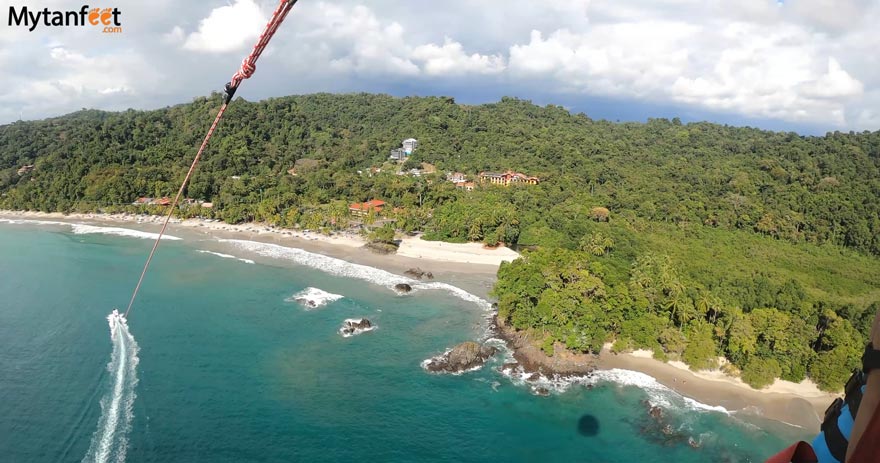
If you do want to add even more adventure, Manuel Antonio has great white water rafting with both Class 2 & 3 or Class 3 & 4. If rafting doesn’t float your boat, then perhaps a sunset snorkeling cruise will. Read about things to do in Manuel Antonio and get our Manuel Antonio tours discount!
Day 11: Fly Out of SJO
Today you will fly home! The drive from Manuel Antonio to San Jose International Airport is approximately 3 hours without traffic. I recommend leaving with plenty of time to arrive 3 hours before your departure flight. That way, you will have enough time to return the rental car and get to the airport and account for any delays along the way.
So if your flight is at 4 PM, I recommend to leave at 9 AM in case you run into any traffic or delays. You can also stop on the way for food and bathroom without rush.
However, if your flight departs at noon or earlier, I recommend to drive the airport on Day 10, return your rental car and spend your last night near the airport. That way, you don’t have to worry about any delays on the road, especially if you are visiting during Christmas , Easter or rainy season. Here are our recommendations for hotels near SJO Airport . We offer a 10% promo code “mytanfeet” for Adventure Inn , a great hotel near the airport with free airport shuttle.
Other Costa Rica Itineraries
1 month Costa Rica itinerary
5 days in San Jose, Costa Rica
5 days in Tamarindo, Costa Rica
10 days Costa Rica itinerary : Bijagua, Bajos del Toro, Manuel Antonio
Read ALL of our Costa Rica itineraries here! .
Costa Rica Vacation Checklist
- First time to Costa Rica? Read our First Time in Costa Rica guide.
- Not sure how to move around Costa Rica? Read our How to Get Around Costa Rica guide to find the best transportation method for you.
- Click the link to get our detailed Costa Rica Packing List so you know what essential items to bring.
- Do not forget to purchase Travel Insurance for your trip to Costa Rica.
- Stay connected by purchasing a prepaid SIM Card in Costa Rica. Get 10% off your Airalo eSIM package with our promo code “mytanfeet”
- Save money with Mytanfeet Deals for tours and hotels. Save more money with our Costa Rica Car Rental Discount.
Join our mailing list and get our free Costa Rica eBook!
Reader Interactions
Darla Clark says
June 3, 2024
Hi there. I have a very similar itinerary planned to this one. I have really enjoyed all your blog posts. In regards to Arenal National Park would you also suggest Arenal 1968 and Mirador El Silenco?
They are both great, but 1968 does get more people so it has more facilities (cafeteria, large parking lot, viewpoint, well laid out trails). El Silencio has wonderful trails but not really other services.
March 7, 2024
Looking to do a very similar itinerary. Is it worth adding Drake Bay if you have 12-13 days? Also, where would you suggest is best for fishing? Going in July so might have some rainy weather along the way.
May 2, 2024
If you had 13+ days, you could add Drake Bay but not for only 12 days, I’d say it’s too rushed and Drake Bay is quite far, it takes a bit of planning to get there. Manuel Antonio/Quepos has excellent fishing
Michelle says
June 17, 2023
Hi! This is the exactly itinerary I’m considering. I think I might want to head west and spend a few days then fly out of Liberia instead of returning to SJO. Any recommendations? We have 10 total days.
Fly into SJO, La Fortuna, Monteverde, Manuel Antonio (maybe less days here?) then……fly out of Liberia.
June 18, 2023
YOu can, just note that Manuel Antonio to Liberia is around 4-5 hours drive so plan accordingly
rocker says
February 22, 2023
Oh, this is great! We’re doing 3 nights La Fortuna, 3 nights MV, and the 5 beach nights (Montezuma), but have been wrestling with what to do in the two inland places–which hikes to do, where to zipline, which bridges, etc. SO helpful!
Tracey says
December 30, 2022
Bless you Sammi. You have provided us with so much valuable info for our upcoming trip to CR. We are going to follow your 11 day itinerary. Have a great New Year and thank you for your weekly blogs. I have learnt so much from you. All the best Tracey from the UK
Leave a Reply Cancel reply
Your email address will not be published. Required fields are marked *
Exclusive deals

The top 10 things to do and see in beautiful Costa Rica
Posted: September 4, 2023 | Last updated: September 4, 2023

Top 10 Fun Things to Do When Visiting Costa Rica
Considering a Costa Rica vacation? As part of Central America, Costa Rica is a beautiful country with lush rainforests, active (and safe) volcanoes, and pristine beaches. It’s a natural wonderland that’s become a favorite destination for those who want to explore its beautiful landscapes.
It can also be a convenient trip: Many cities offer direct flights, which means you shouldn’t have to devote too much travel time. Plus, if you’re happy with mid-priced restaurants and lodging, it’s an affordable country to visit compared to other popular travel destinations.
Keep reading to find out the best and worst times to visit, how much you can expect to spend, as well as some fun experiences and locations worth checking out while you’re there.
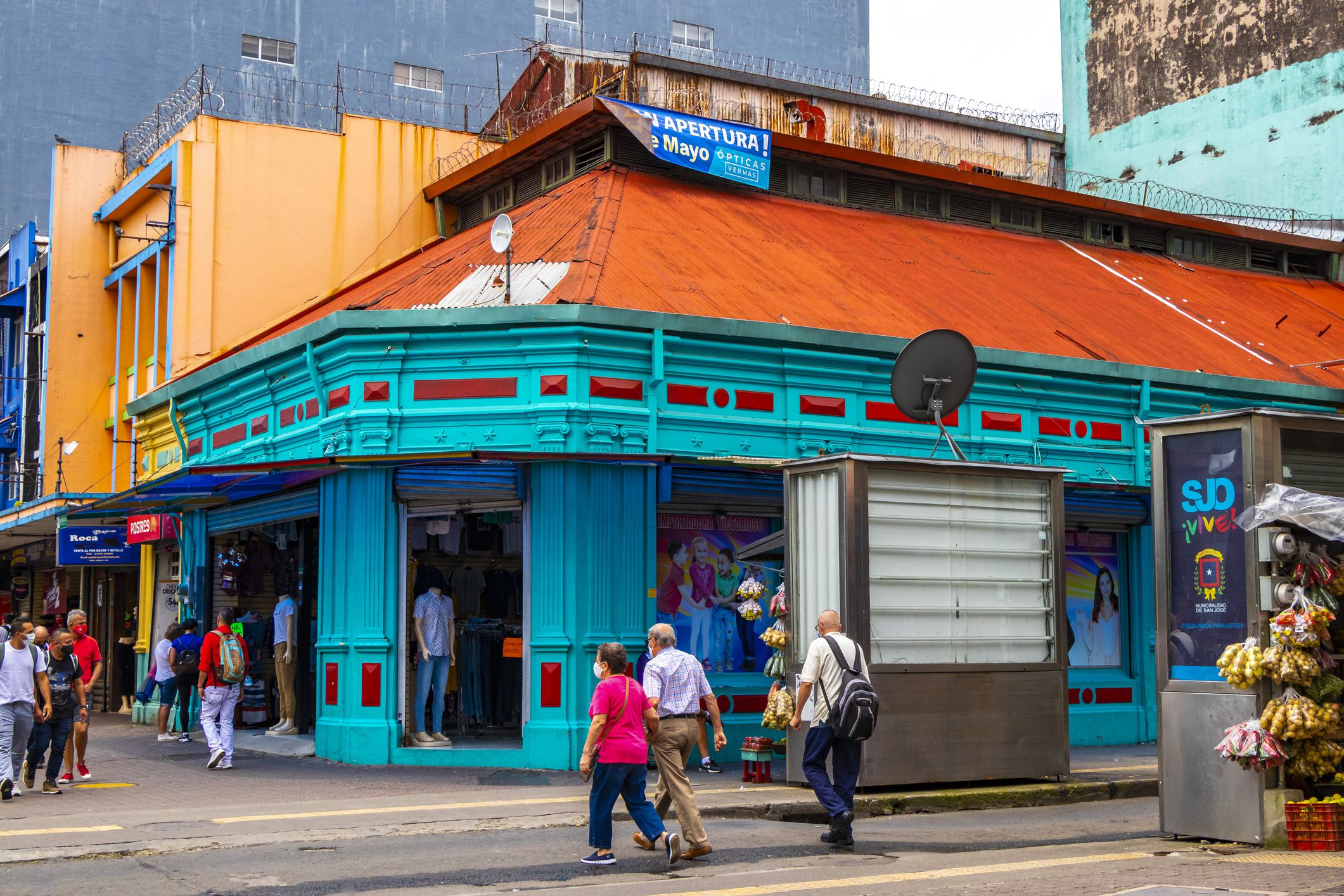
Best Times to Go to Costa Rica
There are two things to consider when planning a trip to Costa Rica: people and weather.
If you want to avoid heavy rain and tourists, the sweet spot for visiting Costa Rica is January and February. Not only is the weather dry and warm, but you won’t feel like you’re in a sea of people.
If you’re researching how to save money for a trip to Costa Rica, one of the best things you can do as a frugal traveler is book during the off season. With its rainforests, beaches, and and volcanoes, Costa Rica is a popular tourist destination for a variety of reasons. Determine what excites you the most to narrow down when you should travel so you’re not overwhelmed by fellow tourists and heavy rainfall.
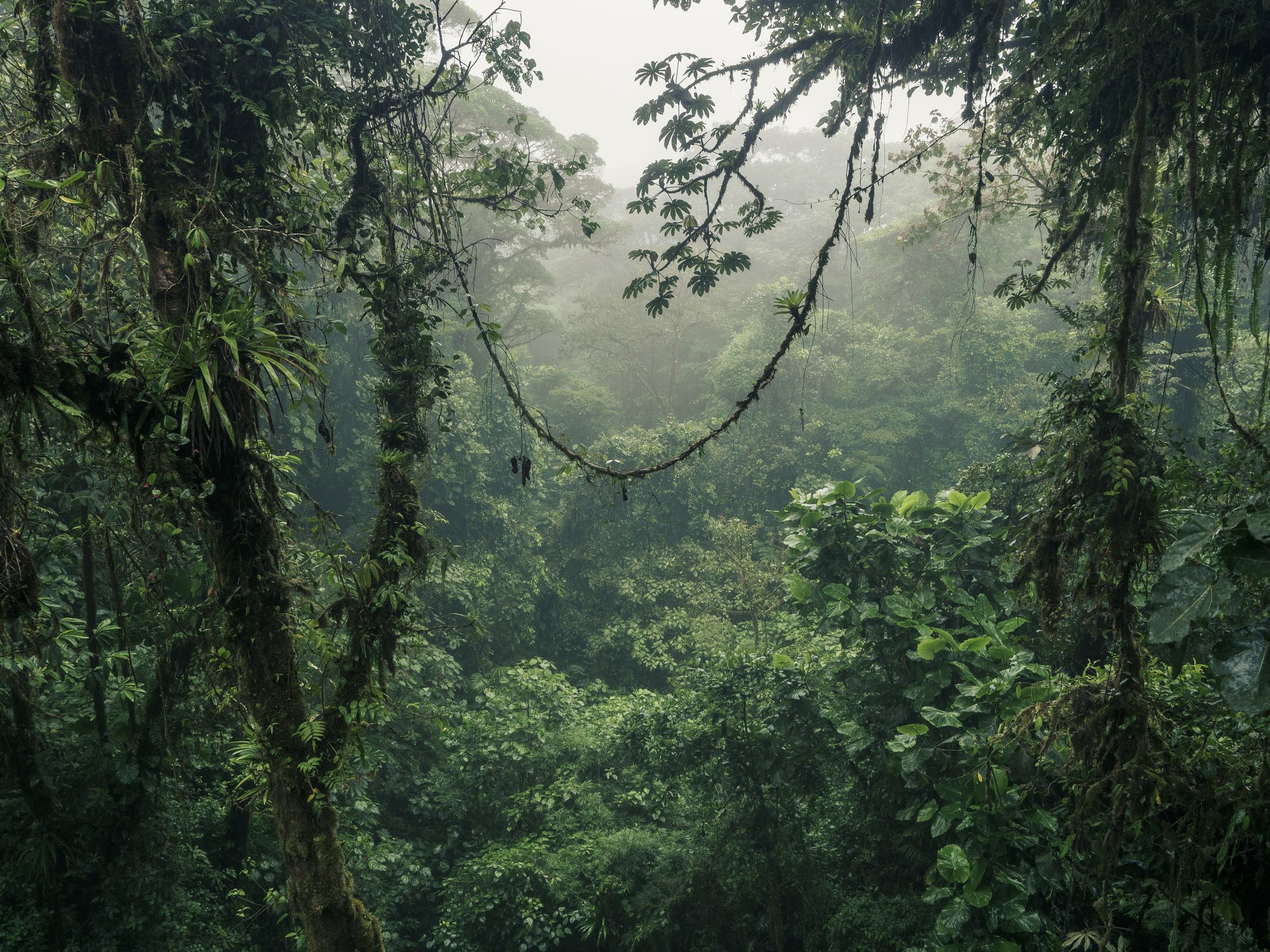
Bad Times to Go to Costa Rica
As briefly mentioned above, the two things you want to keep in mind when visiting Costa Rica are weather (especially rainfall) and fellow tourists.
Costa Rica has an average temperature of 80 degrees Fahrenheit all year round, so you don’t need to plan around the temperature so much as the rain. May through November is when the region typically experiences its heaviest rainfalls (with September usually being the peak month).
Tourists often visit the country once the rainy season ends and kids are off for school break. Therefore, from December to April is when many people choose to travel. If you don’t like crowds and the possibility of bumped-up prices, avoid those months.
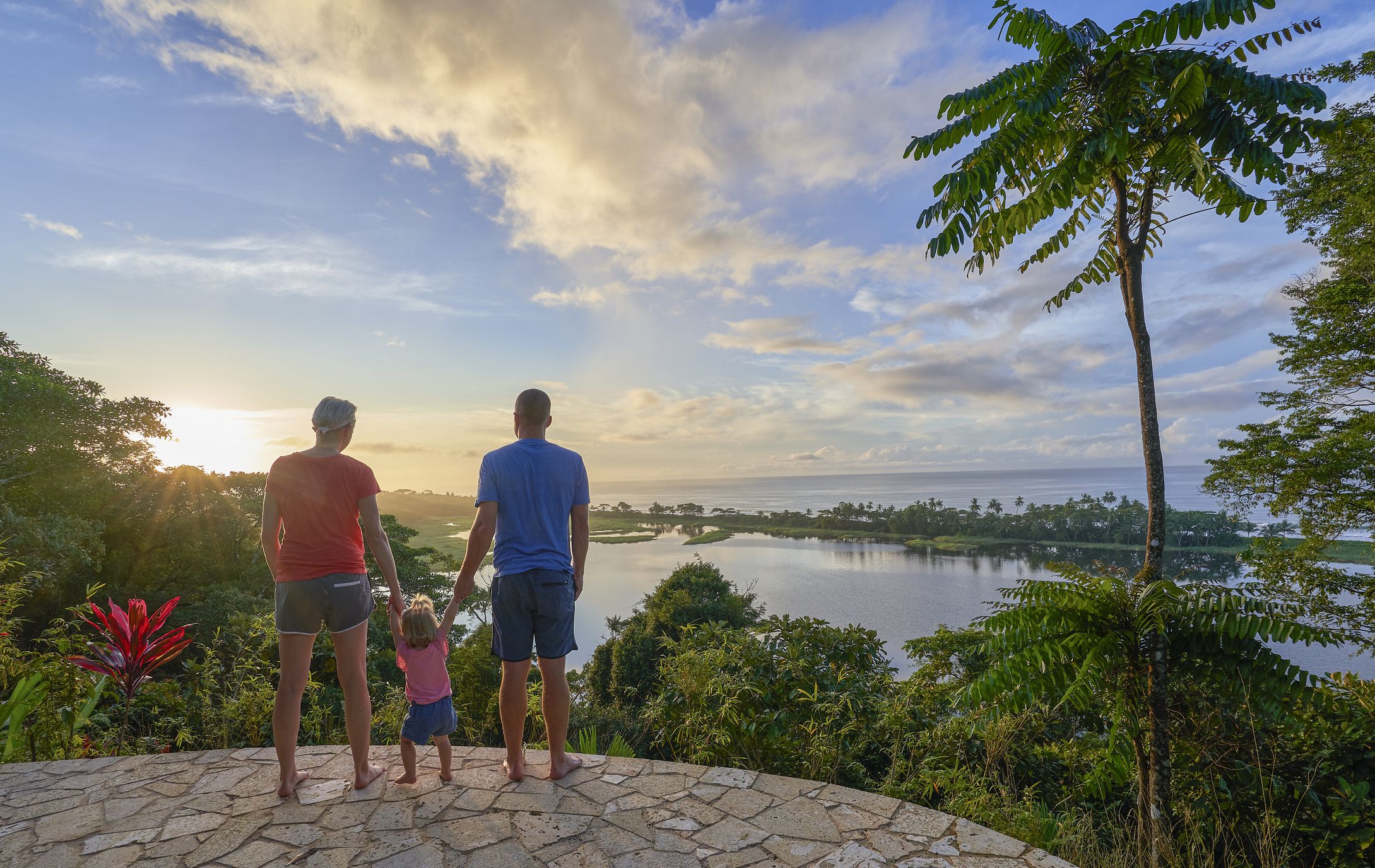
Average Cost of a Costa Rica Vacation
Here are some estimates of what a Costa Rica vacation can cost if you seek out mid-range restaurants and lodging. Knowing these prices can help you budget, decide where to keep your travel fund , and get started saving.
These costs don’t include your travel to and from Costa Rica. This expense will obviously vary depending on when you travel, where you are traveling from, and how you like to travel (say, business class vs. basic economy with no checked bags). Another factor: how well you do your research on how to get cheap flights and hack your way to the lowest possible prices.
Financial prep for travel can begin with considering how to finance your trip.
- Do you have a year to save? Could you create a travel fund and have some money automatically transferred in with every paycheck?
- Or, to afford a Costa Rica trip in the near future, could you take advantage of a book now, pay later travel deal without taking on too much debt?
- Could you find a travel deal that makes the trip a too-good-to-pass-up prospect? That does happen sometimes, meaning spending time on research can reward you well!
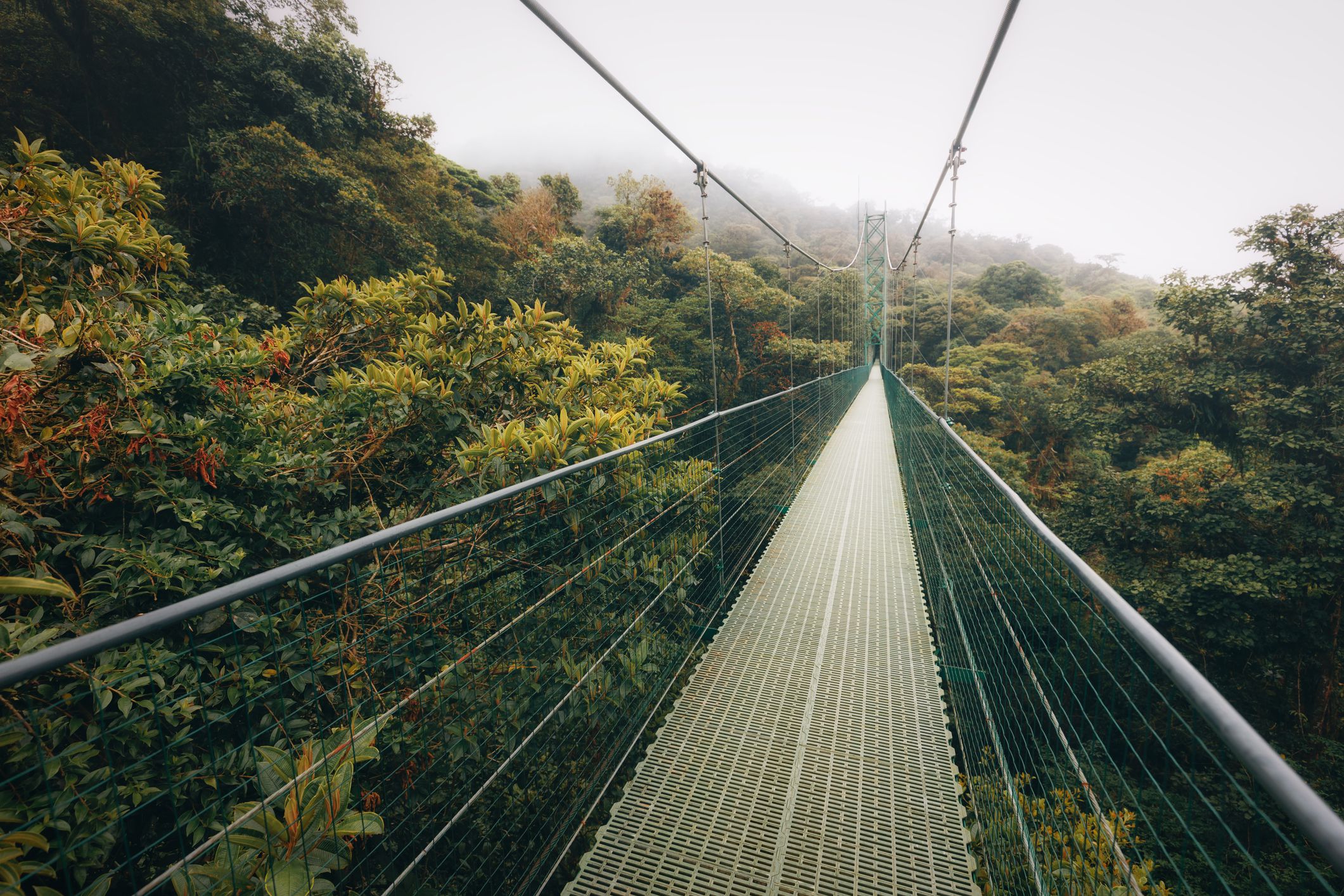
10 Fun Things You Must Do in Costa Rica
Looking for fun things to do in Costa Rica? This list was developed by scouring online forums, review sites, and travel guides to formulate the top 10 things you should do in Costa Rica. Plus, there’s advice from savvy travelers who’ve explored the country.
1. Explore Monteverde Cloud Forest
One of the best things to do in Costa Rica is visit Monteverde Cloud Forest, which, for nature lovers, is like a vast playground. Here, visitors can explore the reserve via zip lines, go birdwatching, visit butterfly and hummingbird reserves, and take a nighttime guided tour to see and hear the park’s nocturnal residents. With almost 26,000 acres, it’s no wonder the reserve sees almost 70,000 unique visitors each year.
If you put this one on your list, you’ll want to purchase tickets in advance. On its website you can buy a day pass, book an experience, or reserve a room at the Monteverde Cloud Forest Lodge. Typically, a day pass is $12 for kids, $25 for adults. cloudforestmonteverde.com/
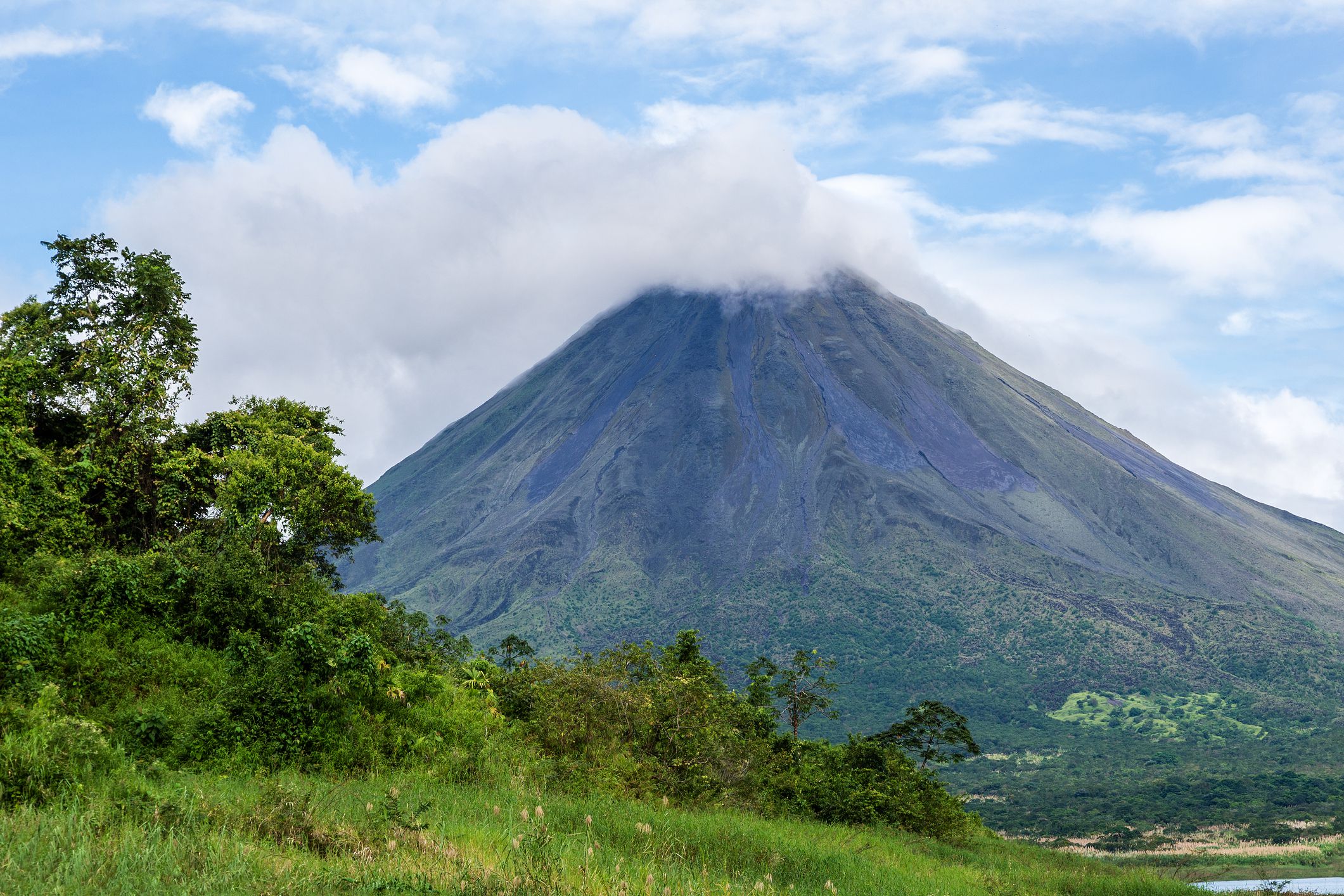
2. Trek Around Arenal Volcano National Park
Located near La Fortuna, Arenal Volcano is an active volcano in Costa Rica. While it hasn’t had a major eruption since 1968, it still has frequent, minor eruptions that visitors can safely view and appreciate. Because of this, it’s one of the most unique things to do in Costa Rica.
Visitors should also consider spending time in the town of La Fortuna. While it provides great views of Arenal Volcano, there are also numerous restaurants and attractions to explore.
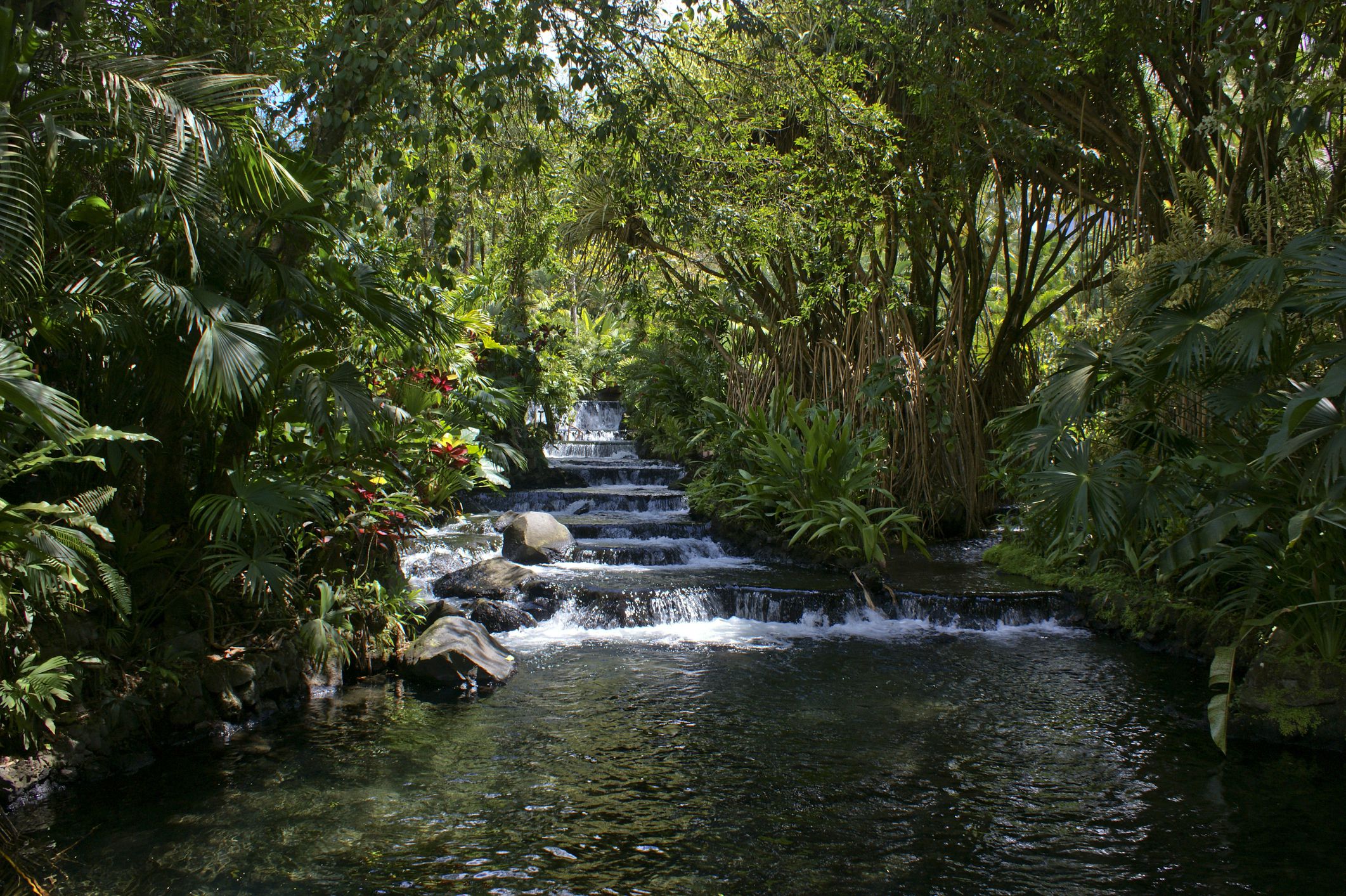
3. Soak in Tabacon Hot Springs
Just west of La Fortuna and Arenal Volcano National Park is Tabacon Hot Springs, which is one of the most popular hot springs in Costa Rica, if not the world. Here you can lounge in one of the many clean, natural pools heated by the Arenal Volcano. You’ll want to book your visit well in advance because spots are limited. Day passes start at about $80 for adults and $38 for kids, depending on the season; a full array of treatments, from facials to massages, are available at the spa. tabacon.com/
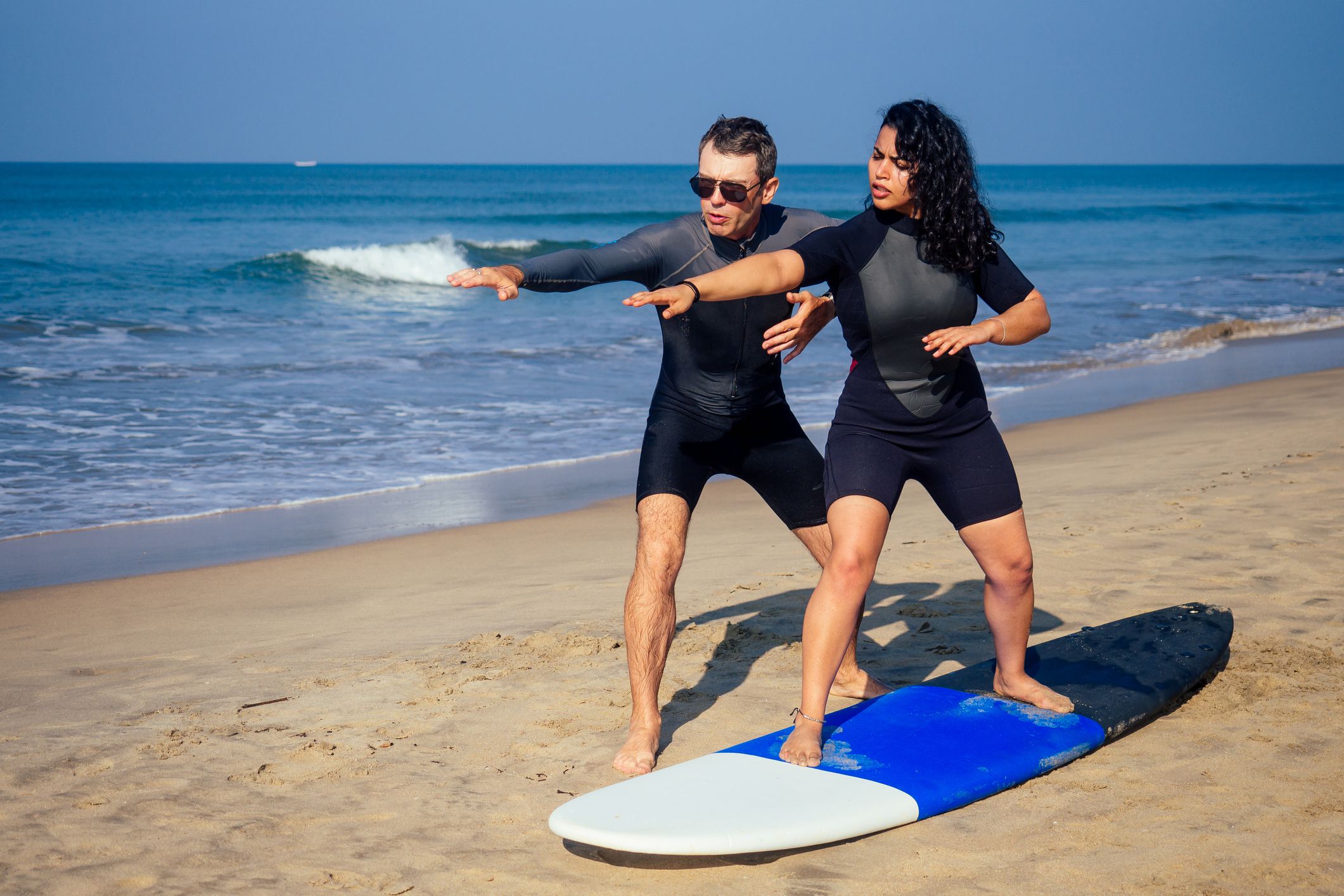
4. Take a Surf Lesson
If you’re looking for things to do in Tamarindo Costa Rica, one of the best things you can do is surf or take surfing lessons. With coastlines on both the Caribbean and the Pacific, it’s a dynamic country to get some great waves for both beginners and experts. If you’re just starting out, book a surf lesson to get the most of your time.
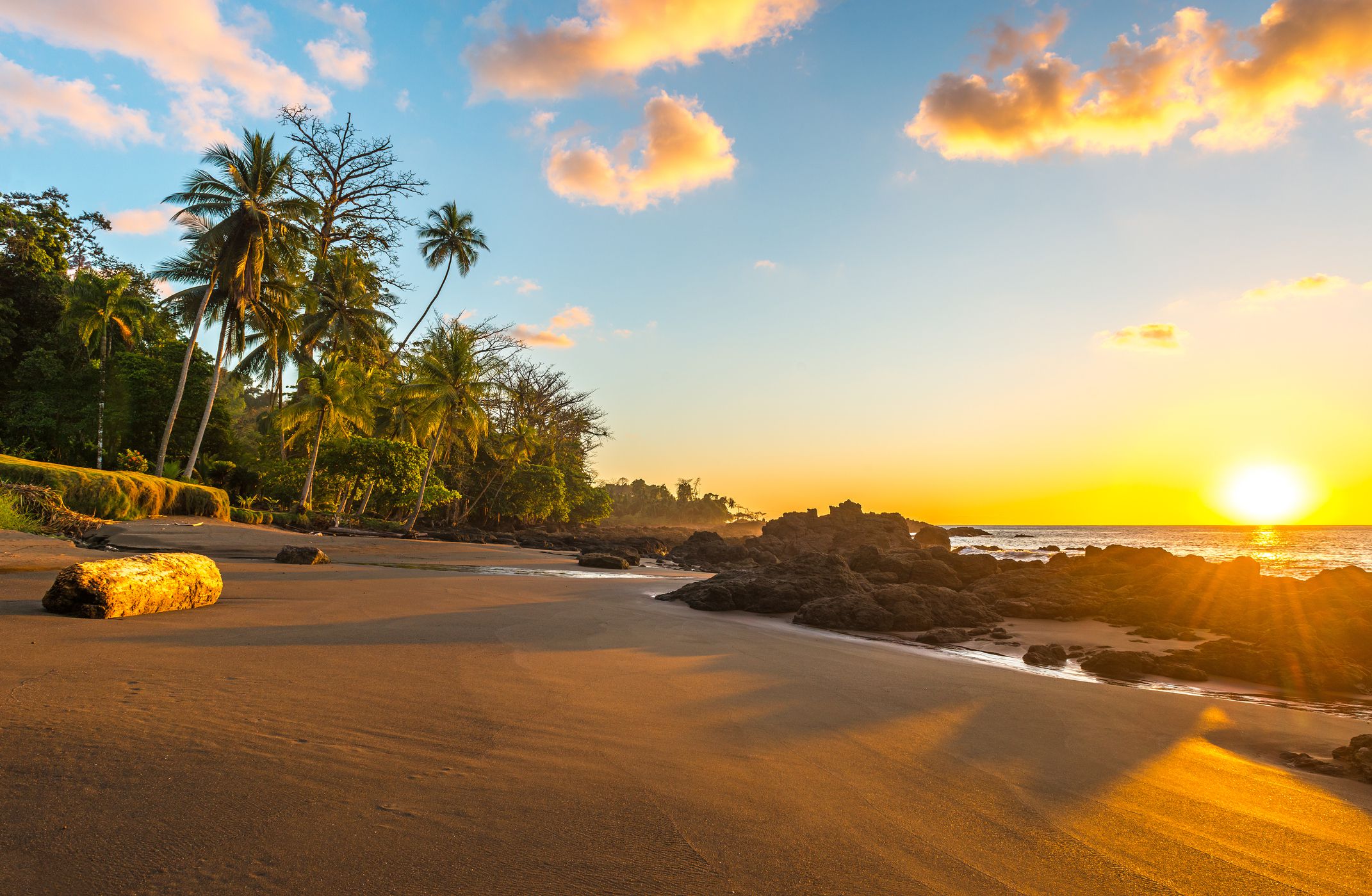
5. Bask on the Beaches of Guanacaste
Located in the northwestern part of Costa Rica (and about two and a half hours away from Arenal Volcano) is Guanacaste, which has some of the best beaches in the country. Note for those traveling with pets : Yes, dogs are allowed at these public beaches!
If you’re not one to soak up the sun, there are a ton of outdoor activities you can do in the area, such as snorkeling, scuba diving, and fishing. So, if you and your traveling partner have different tastes, one of you can enjoy a spa day at a local resort while the other has a little adventure.
It can be wise to work those credit card rewards when touring Costa Rica. Whether you use points to help pay for purchases or swipe a credit card to accumulate rewards doesn’t matter because both are smart financial moves.
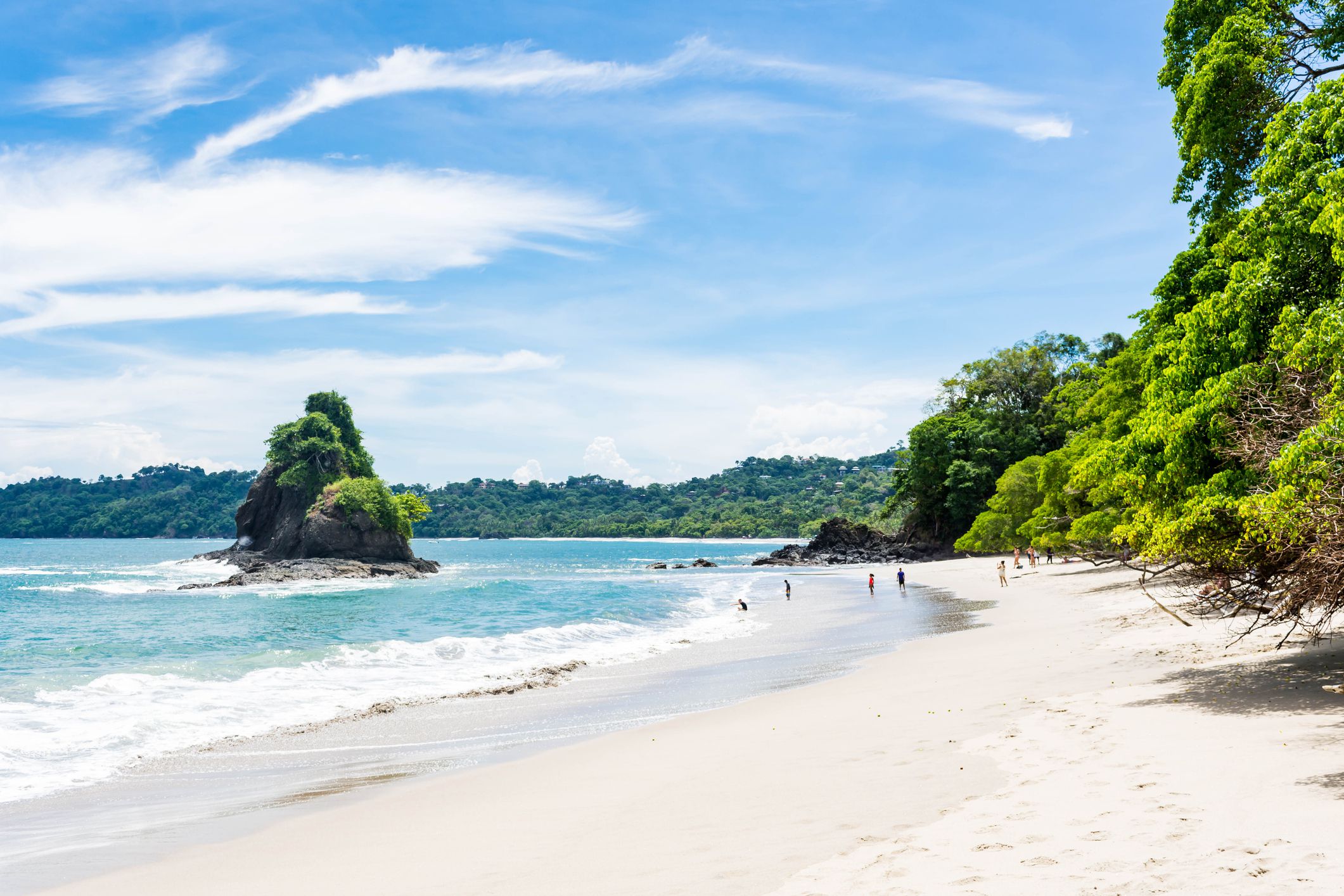
6. Visit Manuel Antonio National Park
If you’re learning how families afford to travel , one of the ways they do so is by visiting locations that offer great experiences at reasonable prices. At Manuel Antonio National Park ( manuelantoniopark.com/ ), you can reserve day passes and hike the trails, or you can book a variety of unique experiences, such as:
- Medicinal plants tours
- Jungle night walks
- Whale watching
Prices start at around $40 for kids and $60 for adults for a guided tour.
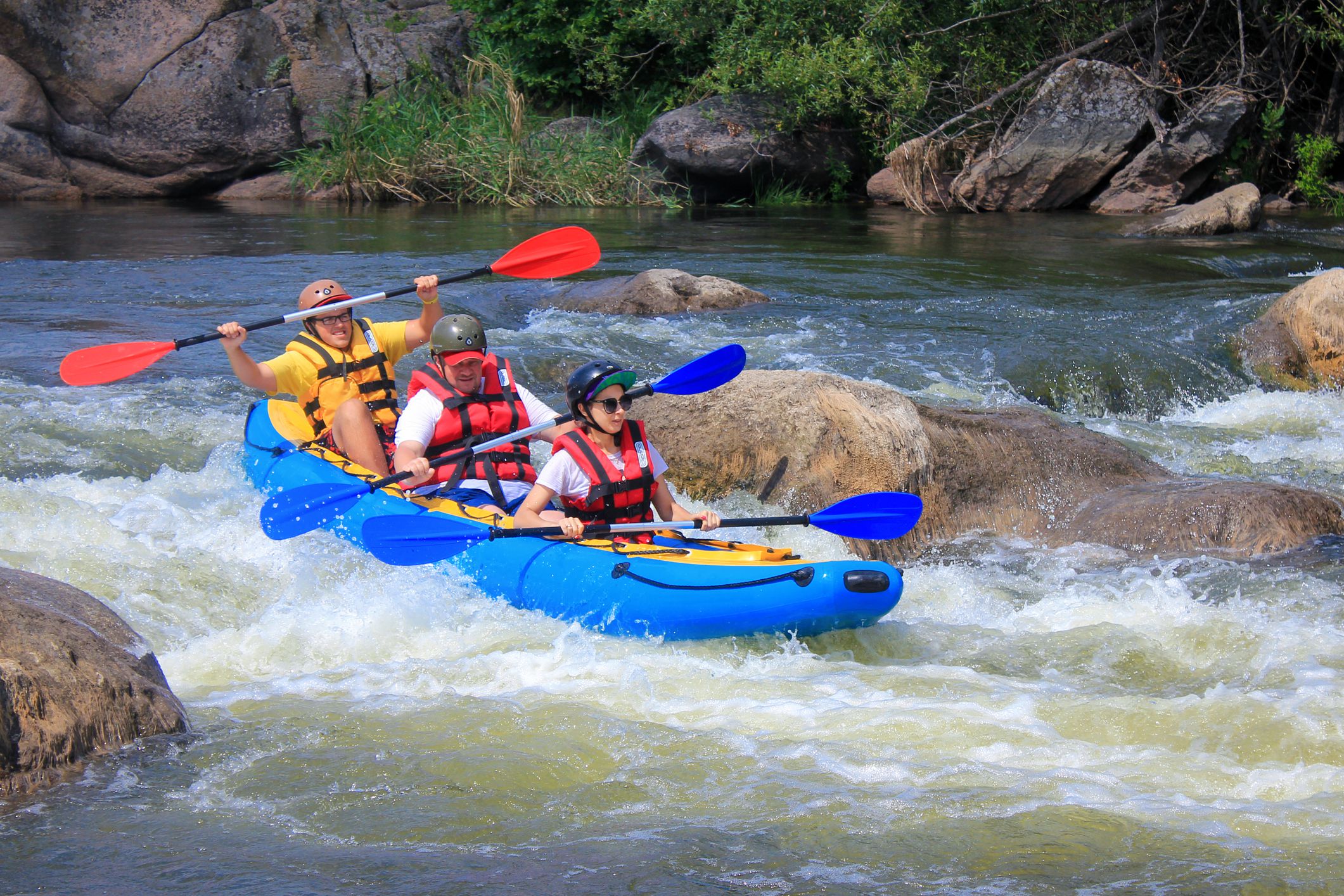
7. Go Whitewater Rafting
Costa Rica has a host of spots perfect for whitewater rafting. Depending on your skill level and taste for adventure, you can likely find a fun outing to splash through the scenery. It can be wise to book a rafting experience close to your hotel. For example, if you plan on staying in Guanacaste for the beaches, then the Tenorio River is close by and offers both class III and class IV rapids.
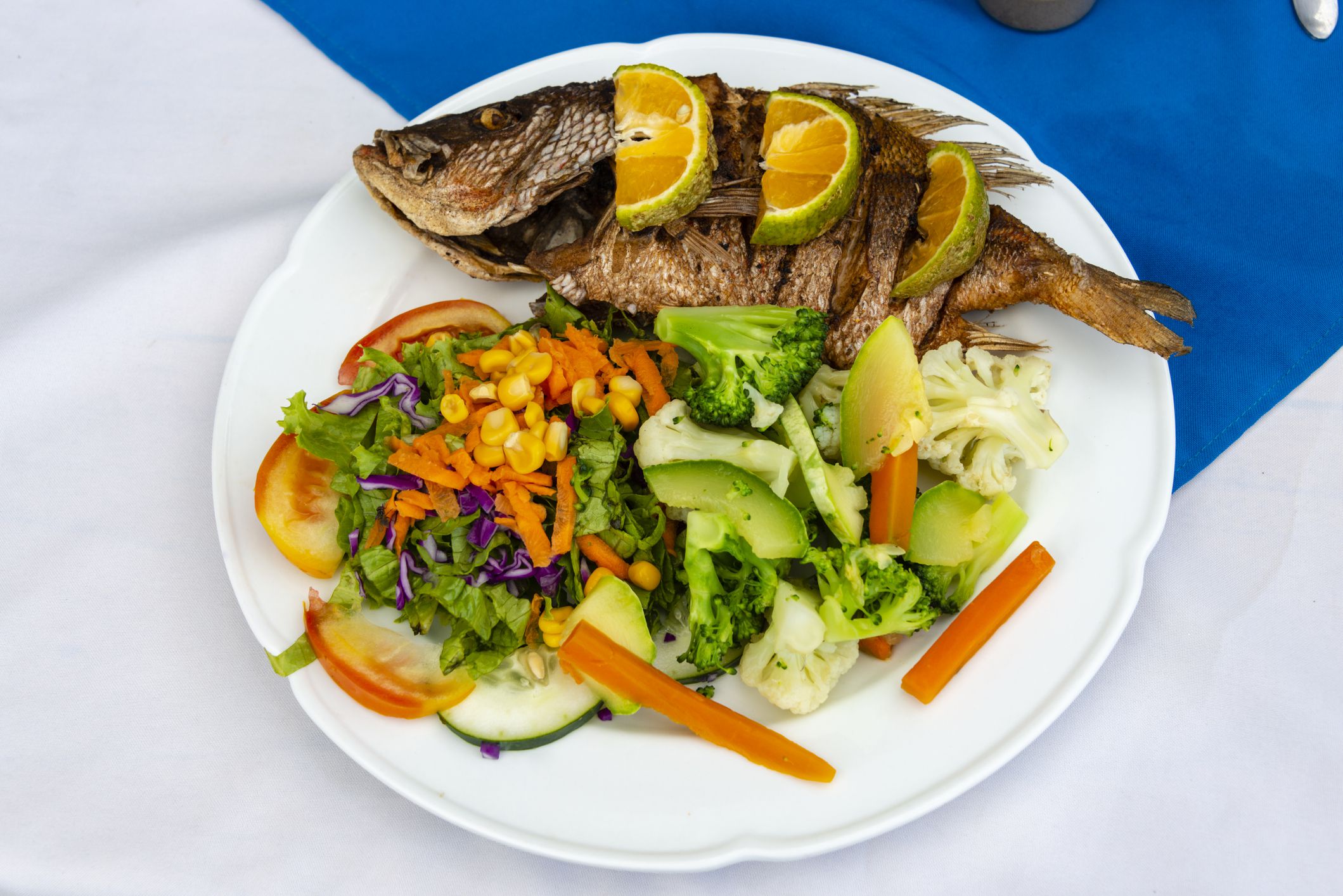
8. Chow Down at Lola’s Restaurant
Located in Guanacaste, Lola’s Restaurant has exquisite food and photo-worthy views. You’ll be tucked amid palm trees by the beach. Soak in the sights while also enjoying some of the best food in Costa Rica, whether you’re craving a guanabana smoothie or some seared ahi tuna. If you’re lucky, you may even visit during a surfing competition or get to meet Lolita, the pet pig. lolascostarica.com/
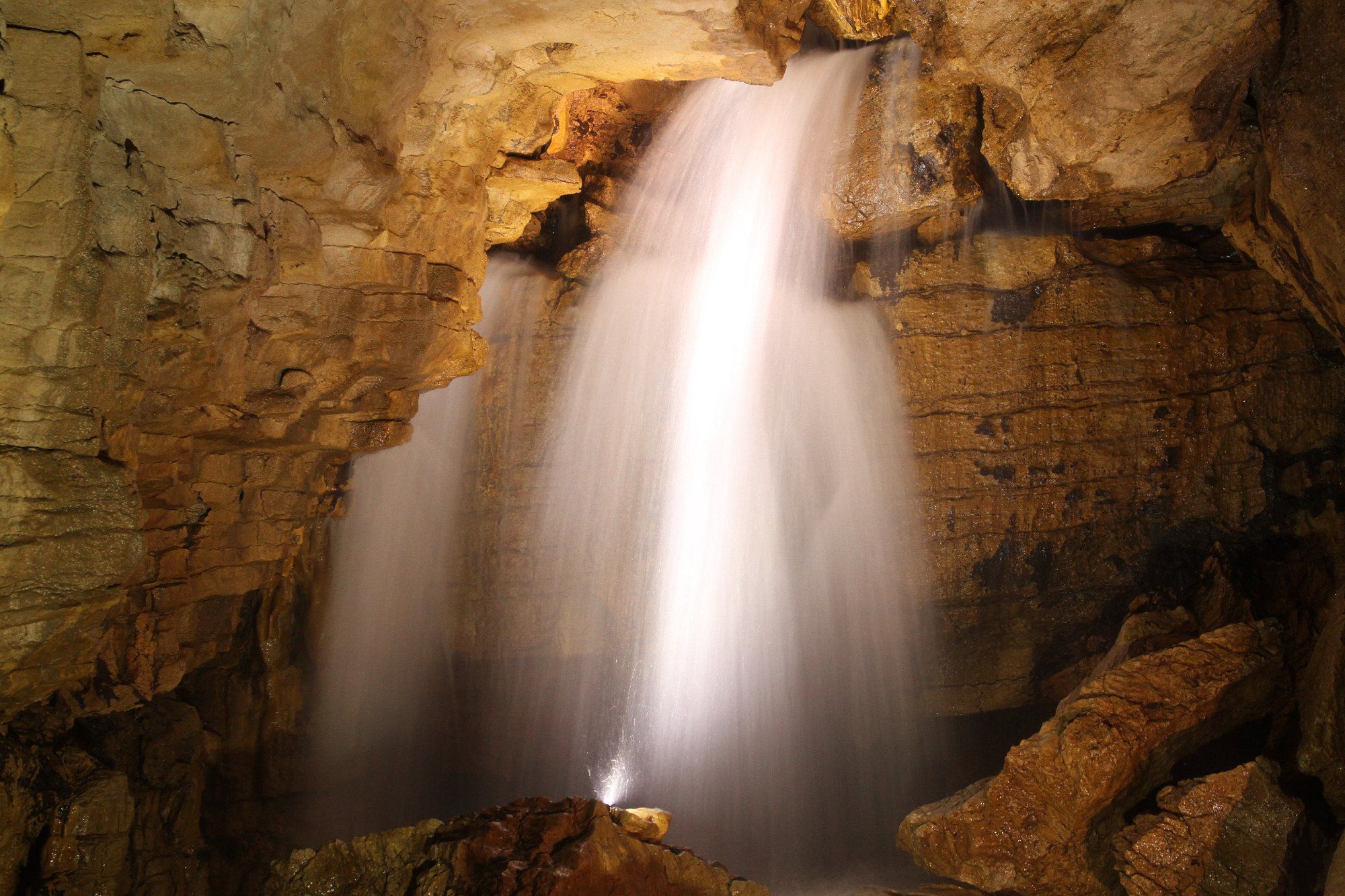
9. Venture into Venado Caves
One of the top things to do in Costa Rica is visiting the Venado Caves. Located near the Arenal Volcano, Venado Caves can offer an all day experience if you have ever wanted to go spelunking. Not only can you take a guided tour, but you can also swim in underground pools and rivers. FYI, you will get wet and muddy, so be prepared! cavernasdelvenadocr.com/index.html
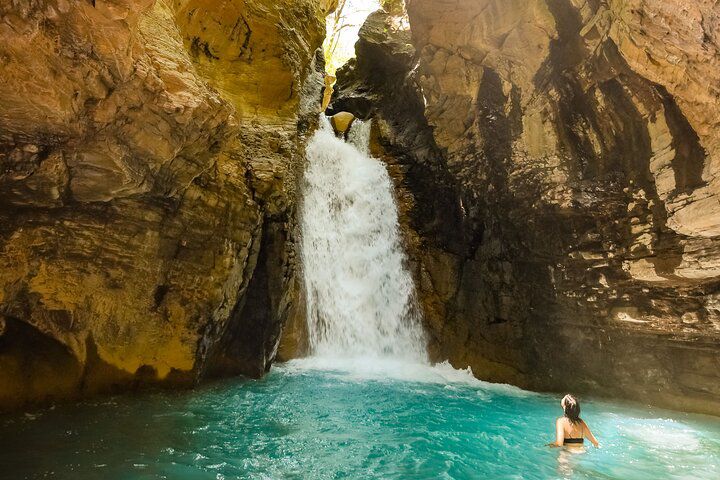
10. Hike to La Leona Waterfall
If you’re comfortable hiking 30 minutes to and from, La Leona Waterfall is one of the most magnificent waterfalls in Costa Rica. Group tours start at $30, while private tours are $45. Once you reach the bottom of the trail, you can even take a dip in the natural pools to cool off. leonawaterfall.com/
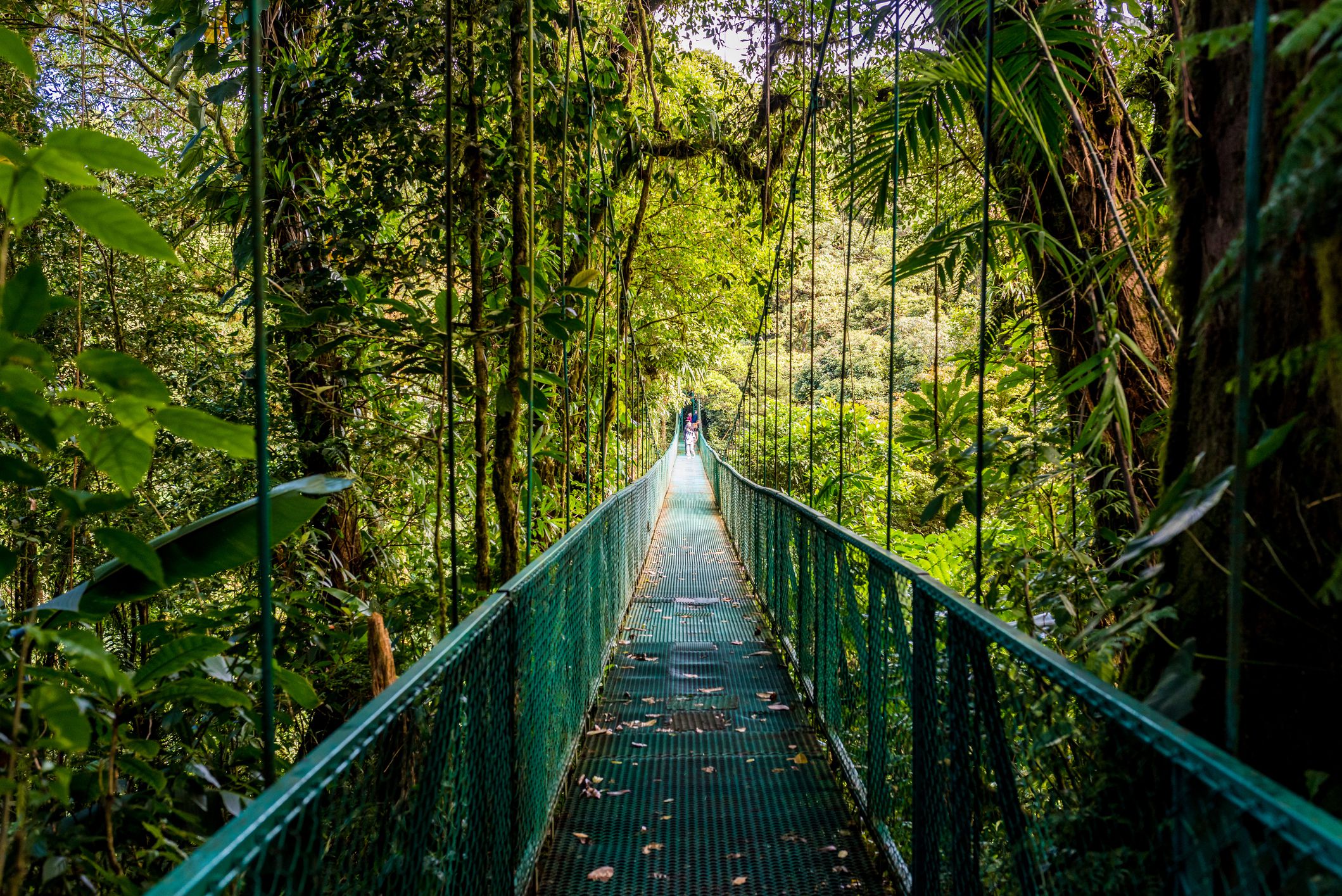
The Takeaway
Costa Rica is an exciting country to visit. Because it’s so popular, it can be wise to book your trip as early as possible to ensure you get to do everything you want. There are waterfalls, parks, whitewater rapids, and other natural wonders to see, as well as great food and spa treatments to enjoy, among other attractions.
This article originally appeared on SoFi.com and was syndicated by MediaFeed.org .
Please understand that this information provided is general in nature and shouldn’t be construed as a recommendation or solicitation of any products offered by SoFi’s affiliates and subsidiaries. In addition, this information is by no means meant to provide investment or financial advice, nor is it intended to serve as the basis for any investment decision or recommendation to buy or sell any asset. Keep in mind that investing involves risk, and past performance of an asset never guarantees future results or returns. It’s important for investors to consider their specific financial needs, goals, and risk profile before making an investment decision.
The information and analysis provided through hyperlinks to third party websites, while believed to be accurate, cannot be guaranteed by SoFi. These links are provided for informational purposes and should not be viewed as an endorsement. No brands or products mentioned are affiliated with SoFi, nor do they endorse or sponsor this content.Communication of SoFi Wealth LLC an SEC Registered Investment AdvisorSoFi isn’t recommending and is not affiliated with the brands or companies displayed. Brands displayed neither endorse or sponsor this article. Third party trademarks and service marks referenced are property of their respective owners.
Communication of SoFi Wealth LLC an SEC Registered Investment Adviser. Information about SoFi Wealth’s advisory operations, services, and fees is set forth in SoFi Wealth’s current Form ADV Part 2 (Brochure), a copy of which is available upon request and at www.adviserinfo.sec.gov . Liz Young is a Registered Representative of SoFi Securities and Investment Advisor Representative of SoFi Wealth. Her ADV 2B is available at www.sofi.com/legal/adv .

More from MediaFeed
4 ways travel credit cards can really save you big on your next vacation.
- 10 of the greatest, most sought-after Chevy models of all time
- 10 of the wildest UFO stories we’ve ever heard
More for You
Taylor Swift sends crowd in meltdown as dancer chants three-word foul-mouthed statement at audience
Jason Kelce Reveals How Much Weight He's Lost Since NFL Retirement
Frustrated Home Depot employee shares photo of countless carts full of gardening products wasted for no good reason: 'Not our call'
How Big Is the Average Social Security Check of a Lower-Class Retiree?
"He offered me some cash in front of my grandma" - Kevin Garnett on how his grandmother pulled out a shotgun on a recruiter
Carpenter's Hack for Starting Screws Makes Life So Much Easier
LeBron James and Lakers lose desired NBA star to New Orleans Pelicans
16 Popular Pizza Chains, Ranked Worst to Best
Humanoid Robots That Look Like Real People?
The Only Way You Should Store Peanut Butter, According to SKIPPY
GMA's Michael Strahan's retirement from TV in his own words
Joe Biden Suffers Poll Blow Among Democrats After Debate
What Happens if You Deposit More Than $10,000 in Your Bank Account?
Check Out the Original Invoice on This 1928 Ford Model A
The Twilight Zone's 7 Most Notable Episodes, Ranked
"It Was A Massive Waste Of Money:" 22 Common Purchases And Projects That Homeowners Either Deeply Regret Or Totally Swear By
17 Unknown Secrets In Well-Known Landmarks
'That money ain't gonna last forever': NBA legend Charles Barkley reveals why nearly 80% of professional athletes go broke after retirement — how to avoid their wealth-killing mistakes
Customers upset after Costco makes change to rotisserie chicken
3 New Required Minimum Distribution (RMD) Rules Everyone Needs to Know About in 2024
A travel expert who has been to more than 90 countries says these are the best under-the-radar destinations
- Samantha Brown shared three underrated travel destinations to avoid crowds.
- Brown has visited over 90 countries in her 20-year career as a seasoned travel host.
- She said Australia and Canada offer unique experiences.

From Europe and Asia to South America and Australia, Samantha Brown has been to more than 90 countries around the world.
The Emmy-award-winning travel host of the PBS show " Samantha Brown's Places to Love " takes viewers across the globe to share what it's like to experience different cultures.
She's been hosting travel shows on various networks for 25 years, including Travel Channel's "Great Vacation Homes."
In a recent conversation with Business Insider, Brown highlighted three underrated destinations that will wow you without the crowds.
Darwin is an underrated destination in Australia.
Darwin is at the top of Australia in the Northern Territory.
"It's closer to Asia than it is to Melbourne or Sydney," Brown said. Singapore is about 300 miles closer than Melbourne, according to Google Maps.
Despite the roughly four-hour flight between Darwin and these more popular Australian destinations, Brown says it's a hidden gem worth visiting because of its unique landscapes in the two bordering national parks, Mary River and Litchfield.
The surrounding national parks may make you feel as if you're on another planet.
Brown travels to Darwin to see waterfalls, pools, and unique landscapes at Mary River and Litchfield National Parks.
"You're in this phenomenally different landscape from the Outback. Darwin feels as if you are not only hitting a new country but a new planet," she said. "It's unlike anything you've ever seen. And I think if you've traveled that far, you need to see that."
If you enjoy train travel, board the Ghan from Darwin to Adelaide. It is known as one of the most scenic railways in the world , with dramatic landscapes inaccessible by other transportation modes.
If you can't get to Europe, take a trip to Montreal.
"If Europe is too expensive, go to Montreal ," Brown said.
The city in Canada's eastern province of Quebec is just a 90-minute flight from NYC.
The French-Canadian city feels like Paris, according to Brown.
The French-Canadian city reminds Brown of Paris with historic architecture, cobblestone streets, and French culture.
Most Montreal locals speak French, and with a European aesthetic, it's easy to see why Brown considers it a comparable destination.
"Montreal is one of the best cities in the world," she said. "The 400-year-old city feels like Europe for half the cost."
She's particularly a fan of the public art scene. According to the city's website , more than 1,000 pieces are displayed around Montreal and are free to view.
Brown recommends taking yourself on a free tour. From the streets to the underground metro stations, Montreal is full of art.
"I love public art, and I love places that we are all allowed to inhabit with no money," Brown said.
A great place to start is Place Jacques Cartier , a public square filled with street artists and vendors, as BI previously reported.
Costa Rica may not seem like a hidden gem, but it is during the rainy season.
In Central America, Costa Rica is a hot spot for tourists. From beaches and jungles to volcanoes and cloud forests, travelers can have a range of experiences in one trip.
But fewer tourists visit in the summer, as Costa Rica's wet season begins in late May and spans six months.
Many tourists don't know that the rain clears up midseason for July.
In the midst of the wet season, rain stops in Costa Rica in July, Brown told BI.
"It happens every year, just for the month of July," she added.
Since many travelers assume Costa Rica is rainy all summer, prices for flights and hotels decrease.
"You can go to the Caribbean side, where all the resorts are, or you can go to the interior, where there are volcanoes and rainforests," Brown said. "You're going to a place that everyone loves to go to. The biodiversity is off the charts. But you're going at a time when no one thinks to go."
For more ideas on where to travel this summer , Brown released the ultimate itinerary in a Summer Travel Trends Report in collaboration with Klarna.
- Main content

IMAGES
COMMENTS
Those were 7 must-visit volcanoes in Costa Rica, but of course, there are lots more for you to explore - Costa Rica is known for its volcanoes, after all. Thanks so much for reading. I hope you enjoyed reading our guide to the best Volcanoes in Costa Rica. If you did, then be sure to browse around and check out more of our in-depth guides ...
If you're planning a trip to Costa Rica and need to see a volcano, don't miss our list of the top Costa Rica volcanoes to visit for the ultimate thrill. Arenal Volcano. Without a doubt, however, the most popular of Costa Rica's volcanic giants is Arenal. Located in the northern part of the country, it towers over the surrounding fertile ...
It's a huge crater! The cost to visit Poas Volcano is $15 USD for non-residents (foreigners) over the age of 13 and $5 USD for non-residents under 13. Resident adults of Costa Rica can visit Poas Volcano for 1,000 Colones ($1.90 USD) and children for 500 Colones ($0.90 USD) . All children under 2 are free!
In Costa Rica, a volcano is considered active if it has erupted in the last 10,000 years. Currently, there are 5 active volcanos in Costa Rica, and they're popular for their steaming craters and sometimes lava flows. The big names here are Arenal, Poás, Rincón de la Vieja, Irazú, and Turrialba, which you'll hear more about below.
Irazu is the tallest volcano in Costa Rica, reaching around 11, 260 ft (3, 432 m). The national park is almost 6000 acres and is full of wildlife and interesting plants to see. There are so many options for food, drinks, picnic locations and excellent hiking trails in the park! Elevation: 3,432 m (11,260 ft)
La Fortuna became known as the place to go in Costa Rica if you dreamed of seeing an active volcano. Unless you happened to visit on a cloudy day, the majestic Arenal Volcano made dreams come true. La Fortuna and the Arenal Volcano post-2010 A non-erupting Arenal Volcano post-2010
Arenal Volcano. Arenal, at 1,670 meters above sea level, is undoubtedly the most well-known of Costa Rica's volcanic giants since it is one of the world's top ten most active volcanoes. It is in the nation's northern region and towers above the lush surroundings, where the best coffee globally is grown on plantations.
Written by Nikki Solano. Nikki is the CEO of Pura Vida! eh?Inc. (Costa Rica Discounts), and the author of the guidebooks Moon Costa Rica (2019, 2021, 2023, and 2025 editions) and Moon Best of Costa Rica (2022 edition) from Moon Travel Guides.Together with her Costa Rican husband, Ricky, she operates the Costa Rica Travel Blog, created the online community DIY Costa Rica, built the Costa Rica ...
The Arenal Volcano National Park spans across almost 30,000 acres of rainforest and is a great place to see the volcano up close from various trails. Choose from several hiking trails that leave from the entrance of the park, some only taking 30 minutes, some taking a couple of hours. Solo hikes on the trails are permitted but you can also ...
Costa Rica Volcanoes. Arenal is the most famous volcano in Costa Rica. But after decades of steady eruptions, it suddenly went quiet in 2010. Arenal Volcano is now considered dormant. At Poás and Irazú you can drive to the rim of the volcano and peer into the crater.
Rincon de la Vieja is known as 'the old women's corner'. Located in the Guanacaste area in the north-west of Costa Rica, this is an andesitic complex volcano. The name means 'The Old Woman's Corner' - this is in reference to a local legend about Princess Curabanda. The volcano is around 1,916 m (6,286 ft) high.
Irazú Volcano. Dominating the landscape at an elevation of 3,432 meters, Irazú is the tallest volcano in Costa Rica and is conveniently located just a short drive from the capital. Its most recent period of activity spanned from 1963 to 1965, famously beginning on the day U.S. President John F. Kennedy started his state visit to the country.
Without a doubt, Arenal is the most popular and well-recognized of Costa Rica's volcanoes. Until recently, it was the country's most active volcano with an average of 41 eruptions per day. ... Related Article: 5 Costa Rica Waterfalls You Must Visit. Each of our 50+ itineraries can be customized to fit your unique vacation style. Find a ...
Poas Volcano is one of Costa Rica's most iconic volcanoes. At almost a mile (1.5 kilometers) wide and 900 feet (300 meters) deep, this crater volcano is surely impressive. Every day, droves of people head to Poas to try to catch a glimpse of the glorious crater and its blue-green lake. But what many people do not know is that it is actually ...
Just 1.5 hours from downtown San Jose, Poas Volcano National Park is an excellent day trip from San Jose and national park to visit for first time Costa Rica visitors. At this national park, visitors can see two volcano craters 2000 meters up in the cloud forest. Here is our guide to visiting Poas Volcano National Park.
Arenal is Costa Rica's most famous volcano. In a country filled with incredible volcanoes, that's saying something. Few volcanos in the world claim such a perfect conical shape, and few have delighted so many visitors. It started in 1968, when Arenal erupted after lying dormant for nearly 500 years. For the next four decades, the volcano ...
Irazú Volcano. Although the highest active volcano in Costa Rica, at 11,260ft (3,432m), Irazú is one of the easiest to visit, sitting within proximity of the capital, San José. It even has a road leading right up to the summit traversed by a weekly bus service. Between 1963 and 1965, a major eruption showered the nearby capital with ash and ...
Arenal Volcano is the most popular and well-recognized volcano in Costa Rica. Standing at 1633 meters in height with a crater diameter of 140 meters, this beautifully symmetrical-shaped strato volcano is the heart and main attraction of the Arenal Volcano National Park. The volcano is considered in the resting phase, however, the last eruption ...
Drive up Crater. At times Costa Rica has had three drive up volcanoes. Currently Poás and Irazú are open. Visits to Irazú tripled in 2017 after the closure of Poás and Turrialba. Although the colossus dominates the eastern skyline and appears close enough to touch from downtown San José it takes over an hour and a half to wind up the paved ...
The volcanoes of Costa Rica can be divided into 3 volcanic range systems. The Guanacaste Range is home to the Ricon de la Vieja, Orosi Volcano, Miravalles Volcano, Tenorio Volcano & Arenal Volcano. ... On a clear day from the volcano's summit you can see both the Atlantic and Pacific Oceans. As the soil on this volcano is very fertile, its ...
Visit the Arenal Volcano National Park. La Fortuna village scenery, hotels, dining, and nightlife. Lounge in hot springs heated by the volcano. Hike and swim the 200-ft waterfall hike near town. Largest lake in Costa Rica is here Lake Arenal. Discover 100 things to do around Arenal. Navigate the rocky terrain and enjoy volcano views.
The Poás Volcano National Park is located in the Central Highlands of Costa Rica. Rising up to 8,885 ft (2,708 m), Poás remains one of Costa Rica's largest and most active volcanoes. At almost a mile in diameter (1.6 km), the crater's rain-fed, sulfuric pool bubbles and emits smoke. Although the last major eruption was in 1910, the ...
Visit La Fortuna for rainforest and volcano, Monteverde for cloud forest and Manuel Antonio for beach. This Costa Rica 11 day itinerary offers plenty of adventure, relaxation and fun. You'll experience three of the most popular tourist destinations so this itinerary is ideal for first time visitors. You can use this exact itinerary or if you ...
Located near La Fortuna, Arenal Volcano is an active volcano in Costa Rica. While it hasn't had a major eruption since 1968, it still has frequent, minor eruptions that visitors can safely view ...
From beaches and jungles to volcanoes and cloud forests, travelers can have a range of experiences in one trip. But fewer tourists visit in the summer, as Costa Rica's wet season begins in late ...
After 800 years of calm, volcanoes have awakened in the Reykjanes Peninsula of Iceland — about 56 kilometers (35 miles) south of the nation's capital, Reykjavik. Since 2021, a string of ...